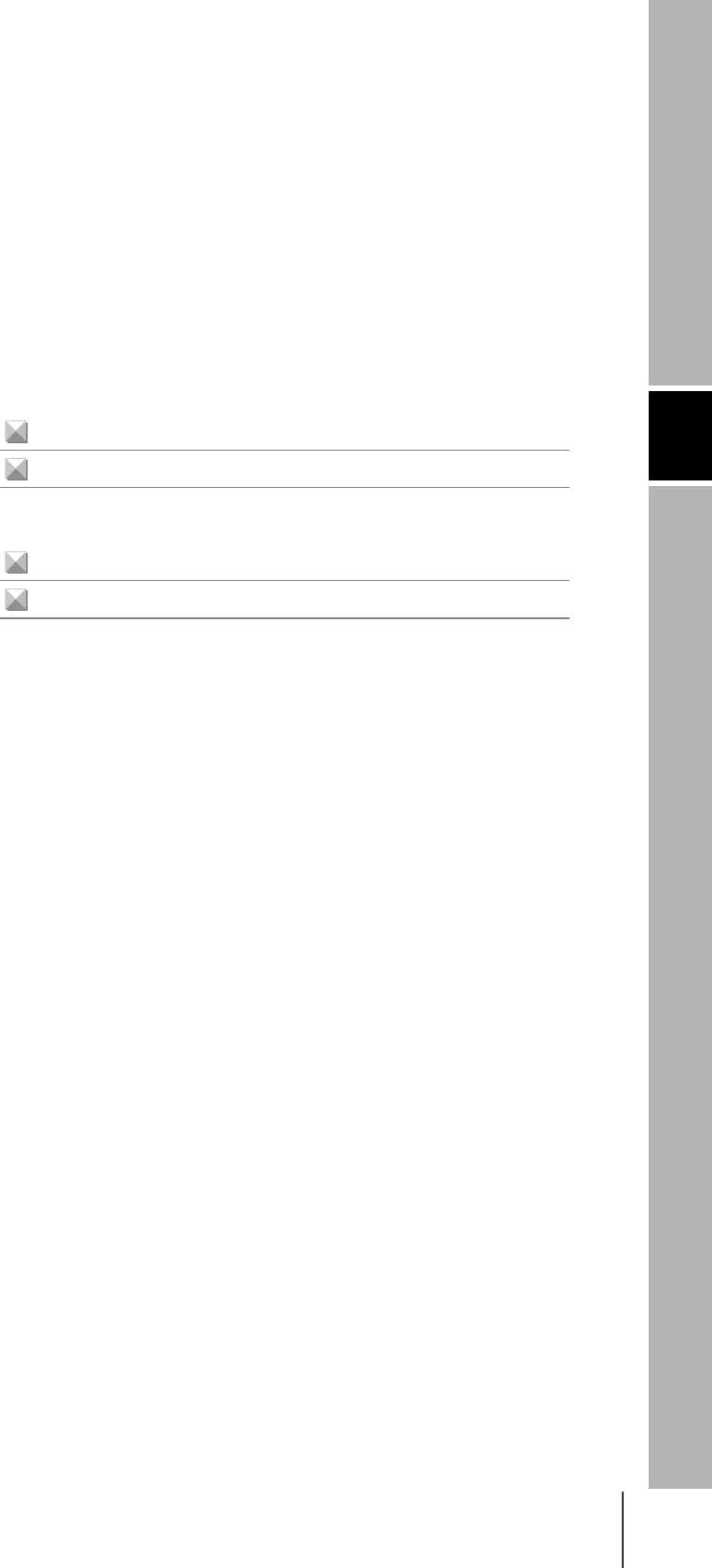Omron 6CYCIDV6700104 Modular RFID Transmitter User Manual v670cf01
Omron Corporation Modular RFID Transmitter v670cf01
Omron >
User Manual

Electromagnetic Inductive RFID System
V670 Series
User's Manual
Cat. No. ntlp-E1-01
CF Reader/Writer
V670-CF01
ID Tag
V670-D13F03
V670-D13F01
V670-D13F01H
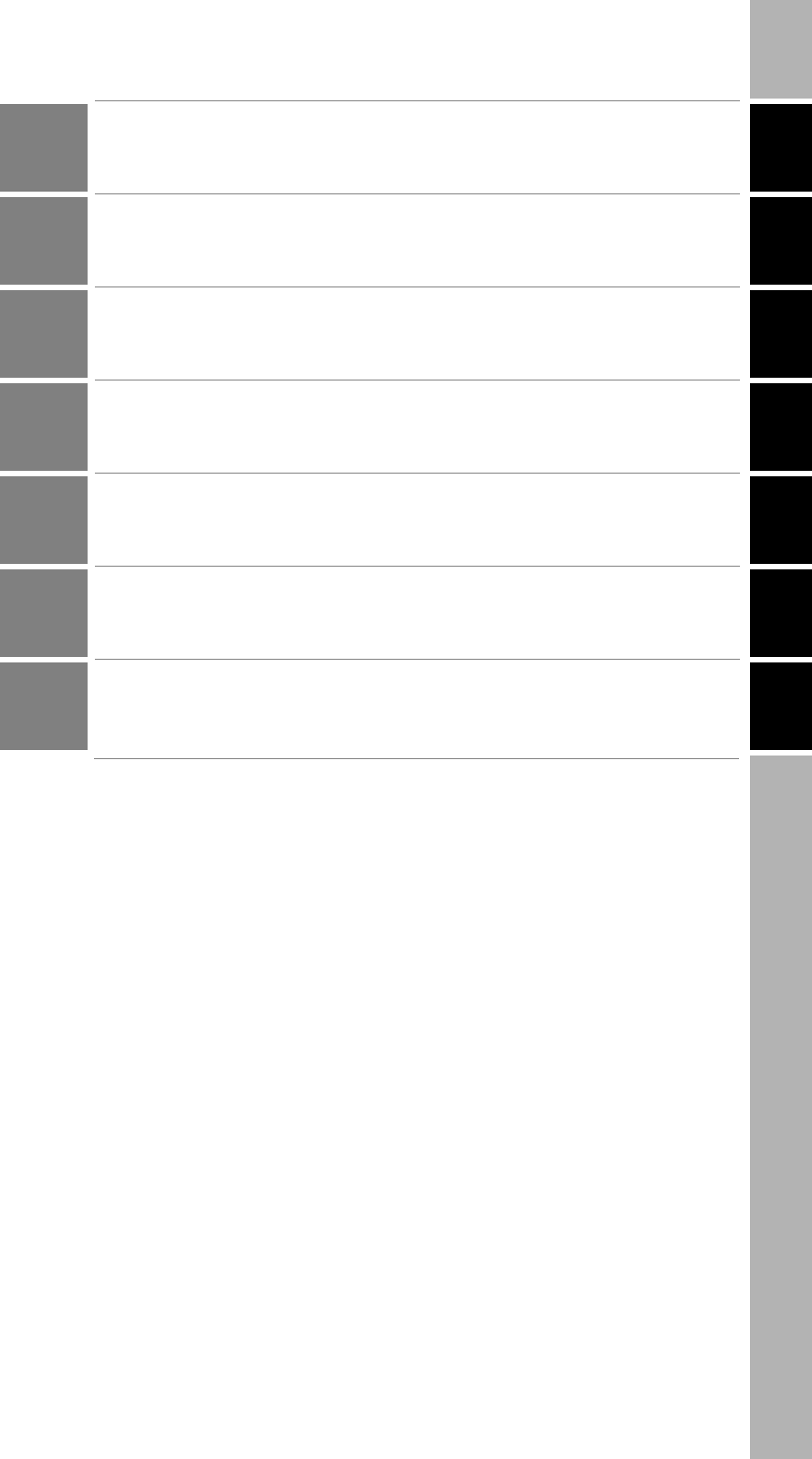
はじめに 第 1 章 第 2 章 第 3 章 第 4 章I
ntroduction SECTION 1 SECTION 2 SECTION 3 SECTION 4 SECTION 5 SECTION 6
Introduction
SECTION 1
SECTION 2
SECTION 3
SECTION 4
SECTION 5
SECTION 6
Standard Conformity
Product Outline
Communications Preparations
Functions
Commands
Troubleshooting
Appendices (Specifications and Dimensions, Characteristics Data Based on
Operating Conditions, Memory Map, Maintenance and Inspection, Table of
JIS8 Unit Code (ASCII), Degree of Protection)
Electromagnetic Inductive RFID System
V670-CF01 CF Reader/Writer
V670-D13F03 ID Tag
V670-D13F01 ID Tag
V670-D13F01H ID Tag
User's Manual
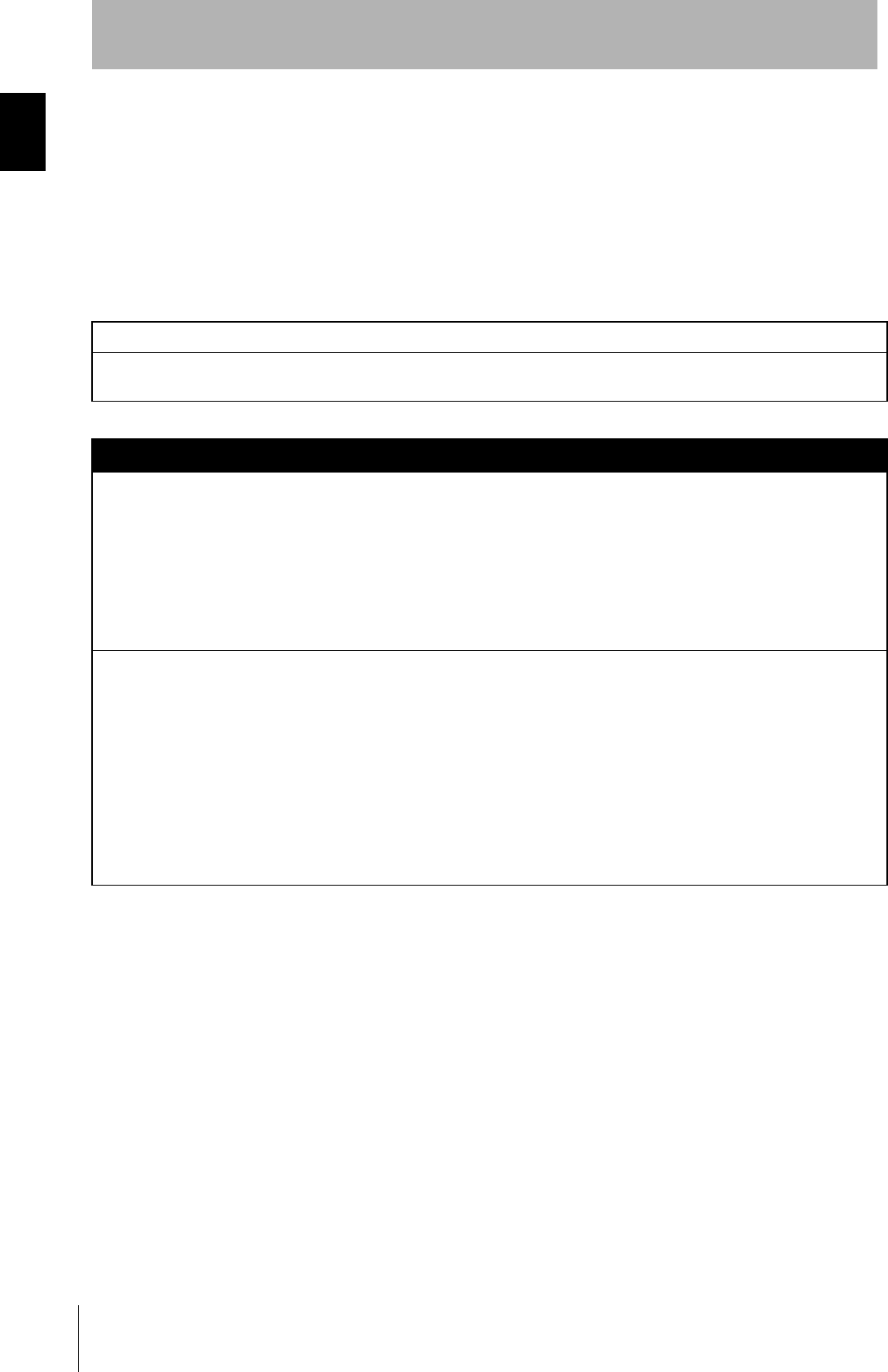
2
Introduction
Introduction
Electromagnetic Inductive RFID System
User's Manual
Introduction
Introduction
OMRON products are manufactured for use according to proper procedures by a qualified operator and only for the
purposes described in this manual. Observe the following precautions when using a V670-series Electromagnetic
Inductive RFID System.
• Read and understand this manual before attempting to use the product and use the product correctly.
• Keep this manual in a safe but accessible location so that it can be used as reference when required.
Read and Understand this User’s Manual
Please read and understand this instruction manual before storing, installing, programming, operating, maintaining, or
disposing of the products. Please consult your OMRON representative if you have any questions or comments.
Warranty and Limitations of Liability
WARRANTY
OMRON's exclusive warranty is that the products are free from defects in materials and workmanship for a period of one
year (or other period if specified) from date of sale by OMRON.
OMRON MAKES NO WARRANTY OR REPRESENTATION, EXPRESS OR IMPLIED, REGARDING NON-INFRINGE-
MENT, MERCHANTABILITY, OR FITNESS FOR PARTICULAR PURPOSE OF THE PRODUCTS. ANY BUYER OR
USER ACKNOWLEDGES THAT THE BUYER OR USER ALONE HAS DETERMINED THAT THE PRODUCTS WILL
SUITABLY MEET THE REQUIREMENTS OF THEIR INTENDED USE. OMRON DISCLAIMS ALL OTHER WARRAN-
TIES, EXPRESS OR IMPLIED.
LIMITATIONS OF LIABILITY
OMRON SHALL NOT BE RESPONSIBLE FOR SPECIAL, INDIRECT, OR CONSEQUENTIAL DAMAGES, LOSS OF
PROFITS OR COMMERCIAL LOSS IN ANY WAY CONNECTED WITH THE PRODUCTS, WHETHER SUCH CLAIM IS
BASED ON CONTRACT, WARRANTY, NEGLIGENCE, OR STRICT LIABILITY.
In no event shall the responsibility of OMRON for any act exceed the individual price of the product on which liability is
asserted.
IN NO EVENT SHALL OMRON BE RESPONSIBLE FOR WARRANTY, REPAIR, OR OTHER CLAIMS REGARDING
THE PRODUCTS UNLESS OMRON'S ANALYSIS CONFIRMS THAT THE PRODUCTS WERE PROPERLY HANDLED,
STORED, INSTALLED, AND MAINTAINED AND NOT SUBJECT TO CONTAMINATION, ABUSE, MISUSE, OR INAP-
PROPRIATE MODIFICATION OR REPAIR.

3
Electromagnetic Inductive RFID System
User's Manual
Introduction
Introduction
Introduction
Application Considerations
SUITABILITY FOR USE
OMRON shall not be responsible for conformity with any standards, codes, or regulations that apply to the combination of
products in the customer's application or use of the products.
At the customer's request, OMRON will provide applicable third party certification documents identifying ratings and limi-
tations of use that apply to the products. This information by itself is not sufficient for a complete determination of the suit-
ability of the products in combination with the end product, machine, system, or other application or use.
The following are some examples of applications for which particular attention must be given. This is not intended to be
an exhaustive list of all possible uses of the products, nor is it intended to imply that the uses listed may be suitable for
the
products:
• Outdoor use, uses involving potential chemical contamination or electrical interference, or conditions or uses not
described in this instruction manual.
• Nuclear energy control systems, combustion systems, railroad systems, aviation systems, medical equipment, amuse-
ment machines, vehicles, safety equipment, and installations subject to separate industry or government regulations.
• Systems, machines, and equipment that could present a risk to life or property.
Please know and observe all prohibitions of use applicable to the products.
NEVER USE THE PRODUCTS FOR AN APPLICATION INVOLVING SERIOUS RISK TO LIFE OR PROPERTY WITH-
OUT ENSURING THAT THE SYSTEM AS A WHOLE HAS BEEN DESIGNED TO ADDRESS THE RISKS, AND THAT
THE OMRON PRODUCTS ARE PROPERLY RATED AND INSTALLED FOR THE INTENDED USE WITHIN THE OVER-
ALL EQUIPMENT OR SYSTEM.
PROGRAMMABLE PRODUCTS
OMRON shall not be responsible for the user's programming of a programmable product, or any consequence thereof.
Disclaimers
PERFORMANCE DATA
Performance data given in this manual is provided as a guide for the user in determining suitability and does not consti-
tute a warranty. It may represent the result of OMRON’s test conditions, and the users must correlate it to actual applica-
tion requirements. Actual performance is subject to the OMRON Warranty and Limitations of Liability.
CHANGE IN SPECIFICATIONS
Product specifications and accessories may be changed at any time based on improvements and other reasons.
It is our practice to change model numbers when published ratings or features are changed, or when significant construc-
tion changes are made. However, some specifications of the products may be changed without any notice. When in
doubt, special model numbers may be assigned to fix or establish key specifications for your application on your request.
Please consult with your OMRON representative at any time to confirm actual specifications of purchased products.
DIMENSIONS AND WEIGHTS
Dimensions and weights are nominal and are not to be used for manufacturing purposes, even when tolerances are
shown.
ERRORS AND OMISSIONS
The information in this instruction manual has been carefully checked and is believed to be accurate; however, no
responsibility is assumed for clerical, typographical, or proofreading errors, or omissions.
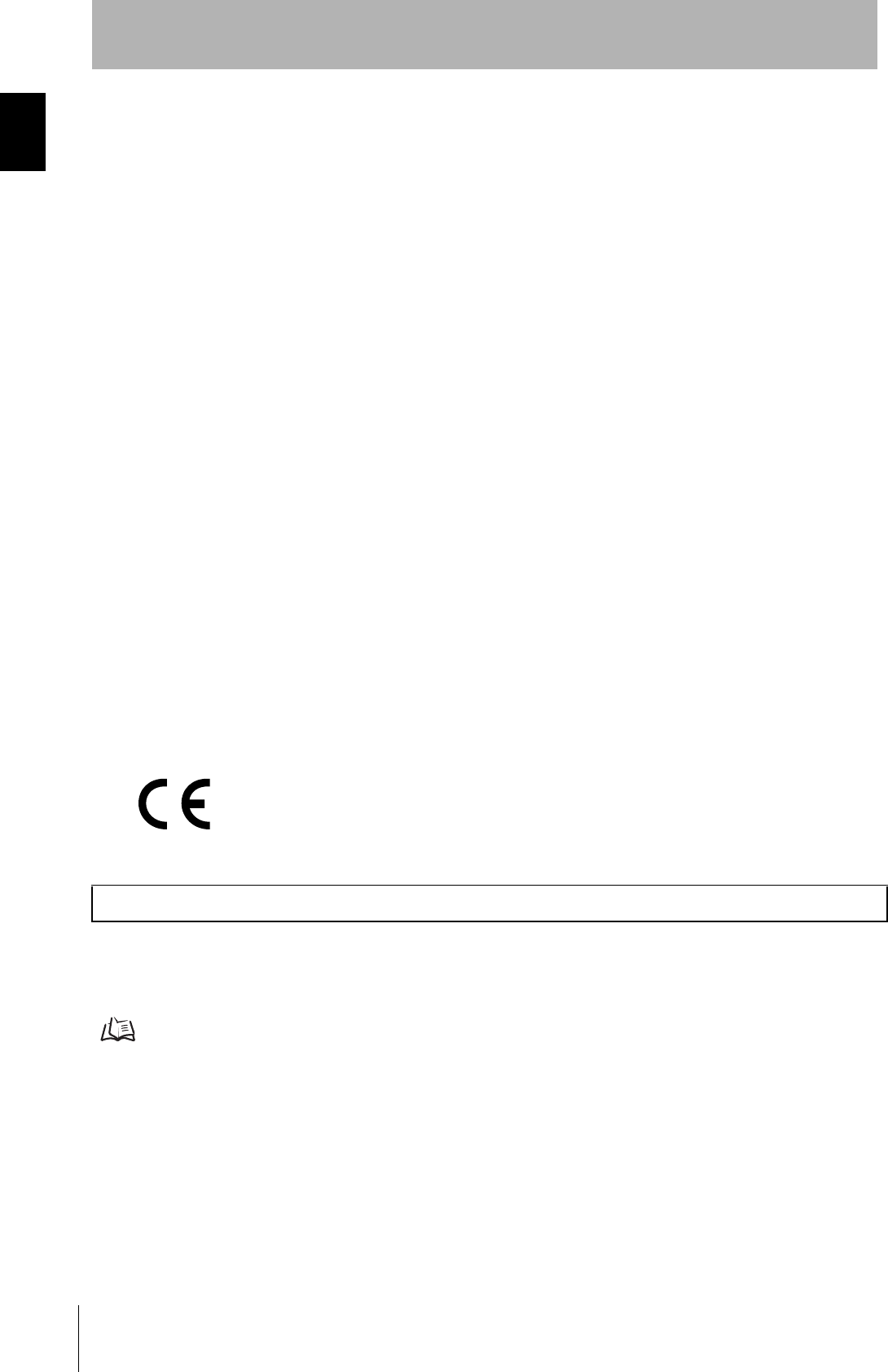
4
Introduction
Standard Conformity
Electromagnetic Inductive RFID System
User's Manual
Introduction
Standard Conformity
1. Radio Law in Japan
This product is covered by the following portions of the Radio Law in Japan (frequency of 13.56 MHz with an electrical
field strength of 500 µV/m or less at a distance of 3 m). Accordingly, the product is classified as a communications
device not requiring a license.
Radio Law Article 100 Item 1 Paragraph 1 (Industrial Facilities Emitting Radio Waves)
Radio Law Implementation Regulations Article 44 Item 1 Paragraph 3 (2) (Inductive Reading/Writing Facilities)
2. FCC Rules (Federal Communications Commission)
This Product complies with Part 15 Subpart C of the FCC Rules.
FCC ID: E4E 6CY CIDV6700104
FCC NOTICE
This device complies with part 15 of the FCC Rules. Operation is subject to the following two conditions:
(1) This device may not cause harmful interference.
(2) This device must accept any interference received, including interference that may cause undesired operation.
FCC WARNING
Changes or modifications not expressly approved by the party responsible for compliance could void the user's author-
ity to operate the equipment.
3. EC Declaration of Conformity
Hereby, OMRON Corporation declares that this RFID System and all of it’s components are in compliance with essen-
tial requirements and other relevant provisions of the Radio and Telecommunications Terminal Equipment Directive
1995/5/EC, and satisfy tests for the appropriate requirements of the following relevant standards.
Radio: EN 300 330-2V1.1.1 (06-2001)
EN 300 330-1V1.3.1 (06-2001)
EMC: EN 301 489-3V1.4.1 (08-2002)
EN 301 489-1V1.4.1 (08-2002)
Safety: EN 61010-1: 2001 (2nd Edition)
For safety, be sure to observe the following precautions:
1. Do not operate this device in any flammable, explosive or corrosive gas environment.
2. Do not disassemble, repair, or modify this device.
3. Use only the recommended Handy Terminals. Proper operation many not be possible if any other Handy Terminal is
used.
p.12
4. Insert the CF Reader/Writer into the CF card slot with the indicator on the CF Reader/Writer facing upward.
5. Be sure to attach the Protective Covers to the Handy Terminal. Be sure to tighten the mounting screws securely. The
Protective Covers are not designed to withstand dropping.
6. If the system gives out a foul smell or if the CF Reader/Writer becomes abnormally hot, emits smoke, or exhibits any
other abnormal condition, immediately stop using the system, turn OFF the power, and contact your OMRON repre-
sentative.
7. Dispose of this product as industrial waste.
Precautions for Safe Use

5
Electromagnetic Inductive RFID System
User's Manual
Introduction
Standard Conformity
Introduction
Please observe the following precautions to prevent failure to operate, malfunctions, or undesirable effects on product per-
formance.
1. Installation Site
Do not install the product in the following locations
• Where it is exposed to direct sunlight
• Where it is exposed to corrosive gases, dust, metal chips, or salt
• Where the operating temperature exceeds the range given in the specifications
• Where there are sudden changes in temperature (including locations subject to condensation)
• Where the humidity exceeds the range given in the specifications
• Where vibration or shock exceeding the values given in the specifications is imposed directly on the product.
• Where the product is subject to splashing water, oil, or chemicals
2. Installation
• This device uses the frequency band 13.56 MHz to communicate with Tags. This frequency band is also used as the
ISM band (one of frequencies assigned to medical or industrial heaters). These heaters may affect communications
with a Tag or may damage the Tag if the heater is located near this device. Do not install ID Tags near devices that
use the frequency band 13.56 MHz.
• To minimize general influence of noise, ground any metallic object located around this device according to 100 Ω or
less.
• When using more than one CF Reader/Writer, communications performance may be adversely affected by mutual
interference. Refer to information on mutual interference when installing the system.
p.79
3. Power Supply
• Use the power supply specified in this manual.
p.68
4. Wiring
• Always turn OFF the power supply to the Handy Terminal before inserting or removing the CF Reader/Writer.
• To protect the system from damage due to static electricity, use a wrist strap or other means of preventing static dis-
charge when touching signal wires for terminals or connectors.
5. Cleaning
• Do not use any thinner. Resin material and case paint are dissolved by thinner.
6. Communications
• Power is supplied when opening the COM port on the CF Reader/Writer. Wait for at least 500 ms after opening the
COM port before starting communications.
Precautions for Correct Use

6
Introduction
About this Manual
Electromagnetic Inductive RFID System
User's Manual
Introduction
About this Manual
Meaning of Visual Guides
Indicates precautions to be observed in operating the Product, advise on operating methods, and important information for main-
taining Product performance.
Indicates the pages numbers where related information can be found.
Indicates information related to troubleshooting.
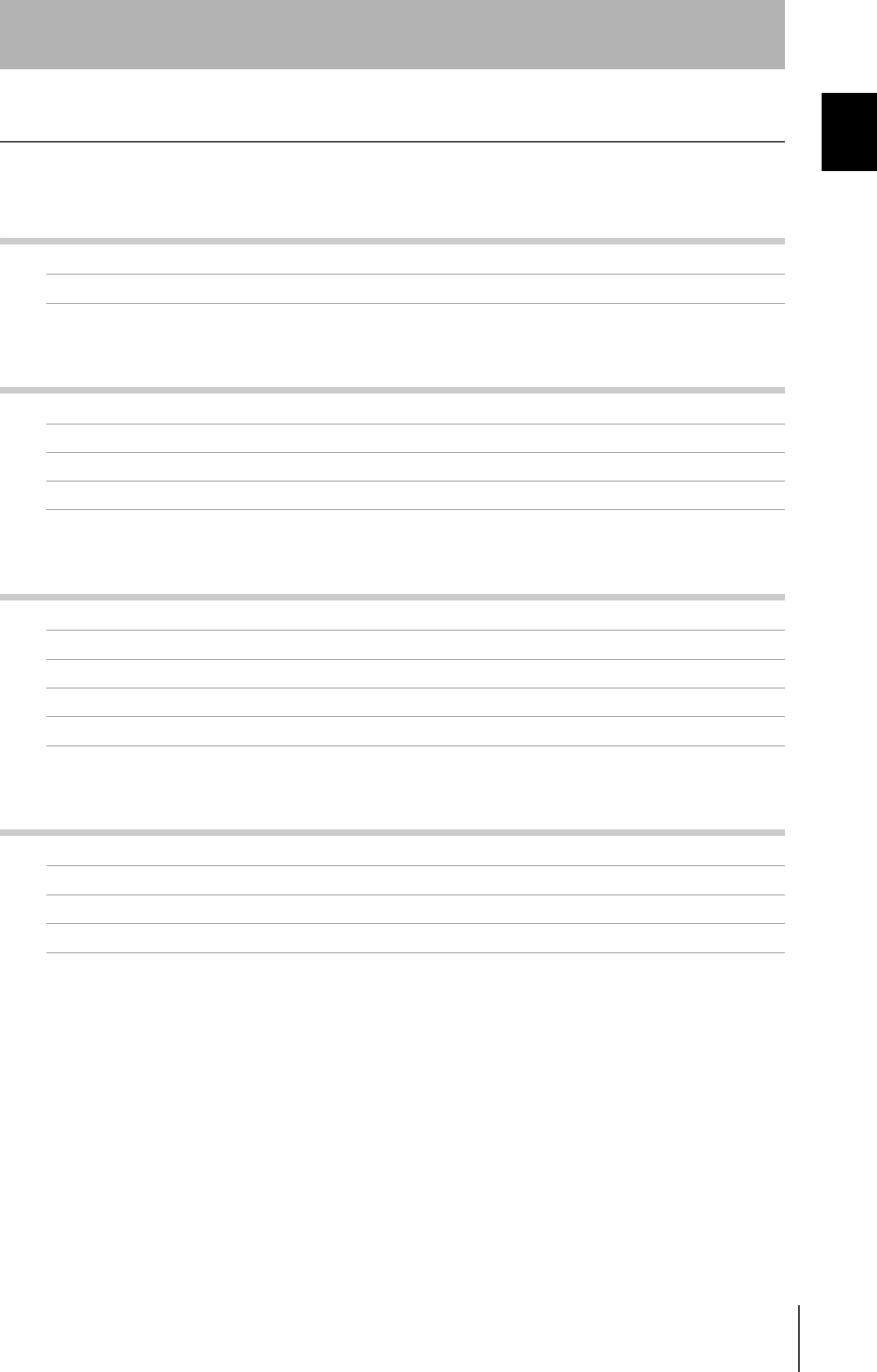
7
Electromagnetic Inductive RFID System
User's Manual
Introduction
Introduction
CONTENTS
Introduction 2
Standard Conformity 4
About this Manual 6
SECTION 1 Product Outline 9
Features 10
Part Names and Functions 11
System Configuration 12
Application Flowchart 13
SECTION 2 Communications Preparations 15
Connection 16
Tags 17
Protective Covers 21
Setting Handy Terminal Communications Conditions 25
Communications Test 26
SECTION 3 Functions 29
Communications Designation Function 30
Setting Operating Parameters 31
Memory Check Function 32
Write Protection 33

8Electromagnetic Inductive RFID System
User's Manual
Introduction
Introduction
SECTION 4 Commands 35
CF Reader/Writer Operation Status 36
Command Response Format 37
Command Response Flow 40
Command List 41
Communications Designations 43
Communications Commands 44
Communications Subcommand 52
Controller Control Commands 53
Host Commands 55
Appraisal Commands 56
End Code List 59
SECTION 5 Troubleshooting 61
Diagnosis Function 62
Errors and Countermeasures 63
SECTION 6 Appendices 67
Specifications and Dimensions 68
Characteristics Data Based on Operating Conditions 79
Memory Map 83
Maintenance and Inspection 84
Table of JIS8 Unit Code (ASCII) 85
Degree of Protection 86
Manual Revision History 90
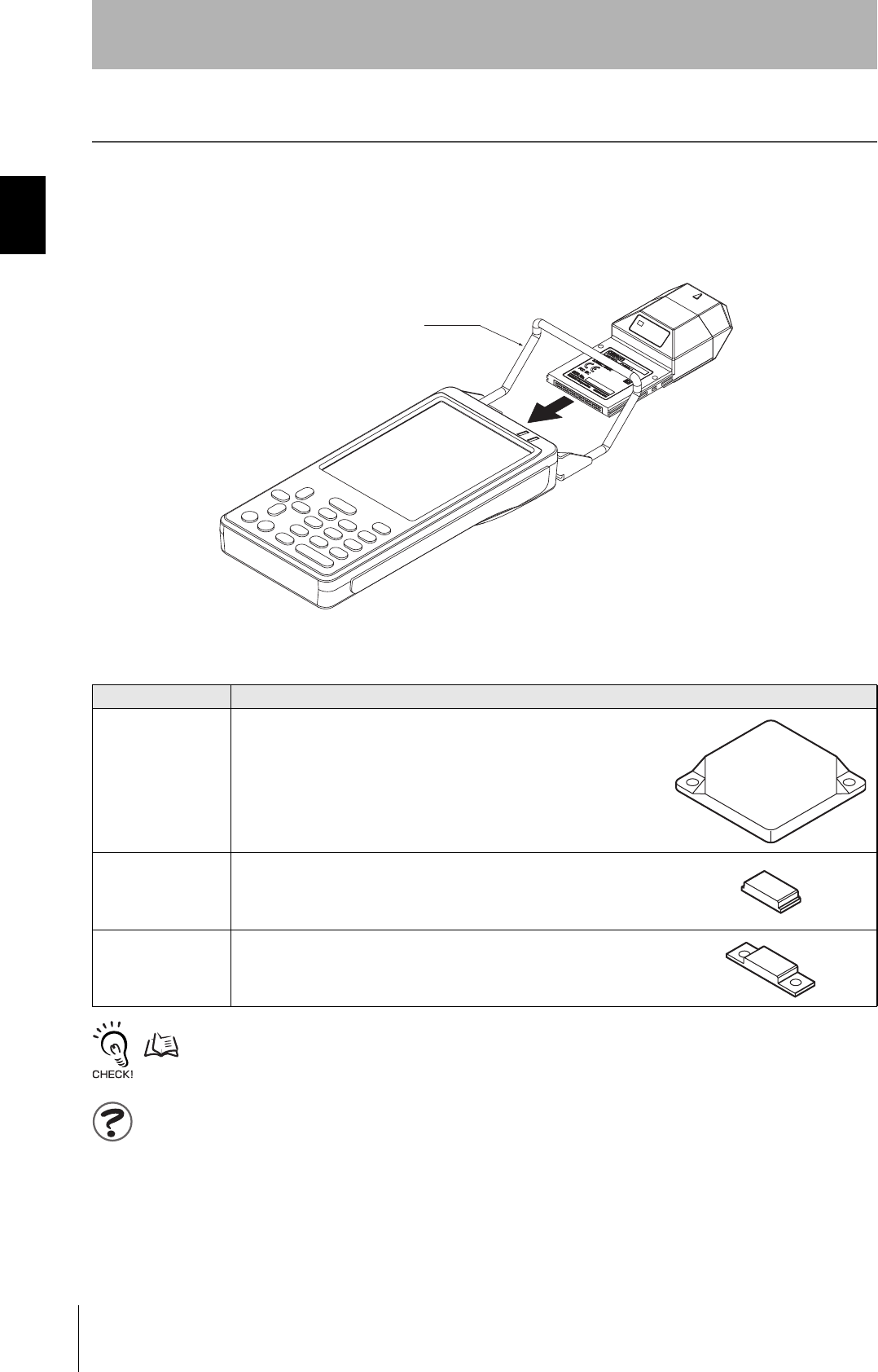
10
SECTION 1
Features
Electromagnetic Inductive RFID System
User's Manual
SECTION 1
Product Outline
Features
The V670-CF01 CF Reader/Writer combines the V670-series Antenna and Controller into a single unit with a
CF interface. It has superior portability and operability because it can be by slotting it into a CF card slot (Type
II) on a Handy Terminal. Tag data can be read and written using serial communications from the Handy
Te r m i n a l.
Refer to Ta g s for detailed Tag specifications.
p.70
Ferroelectric memory (FeRAM) is a type of non-volatile memory that can write data much faster than previous types of memory,
such as EEPROM and flash ROM, and it has a semipermanent writing life. Furthermore, the previous types of memory could no
longer hold data if nothing had been written to the memory for a certain period (approximately 10 years). FeRAM, on the other
hand, is far better for data storage because it can hold data as long as data is read or written within a specific period of time.
The following three types of ID Tags (“Tags”) can be used with the CF Reader/Writer.
Model Description
V670-D13F03 The V670-D13F03 ID Tag has a memory capacity of 128 bytes. It is a 40 ×
40 mm square tag with water-resistant properties. It also uses a highly effi-
cient, non-volatile ferroelectric memory, called FeRAM, as internal mem-
ory. FeRAM has a semipermanent life (i.e., it can be accessed 1 billion
times).
V670-D13F01 The V670-D13F01 ID Tag is a 8 × 16 mm rectangular tag. It is highly
chemical resistant because a PPS case and highly chemical-resistant
epoxy resin is used on the exterior. It has the same memory capacity and
performance as the V670-D13F03.
V670-D13F01H The V670-D13F01H ID Tag has the same performance and construction
as the V670-D13F01. It has holes for easy mounting.
CF Reader/Writer
V670-CF01
Handy Terminal
RZ-N155S (Manufactured by Sharp)
PDT8046 (Manufactured by Symbol Technology)
Protective Cover
V670-A75SH155S
V670-A75SY8046
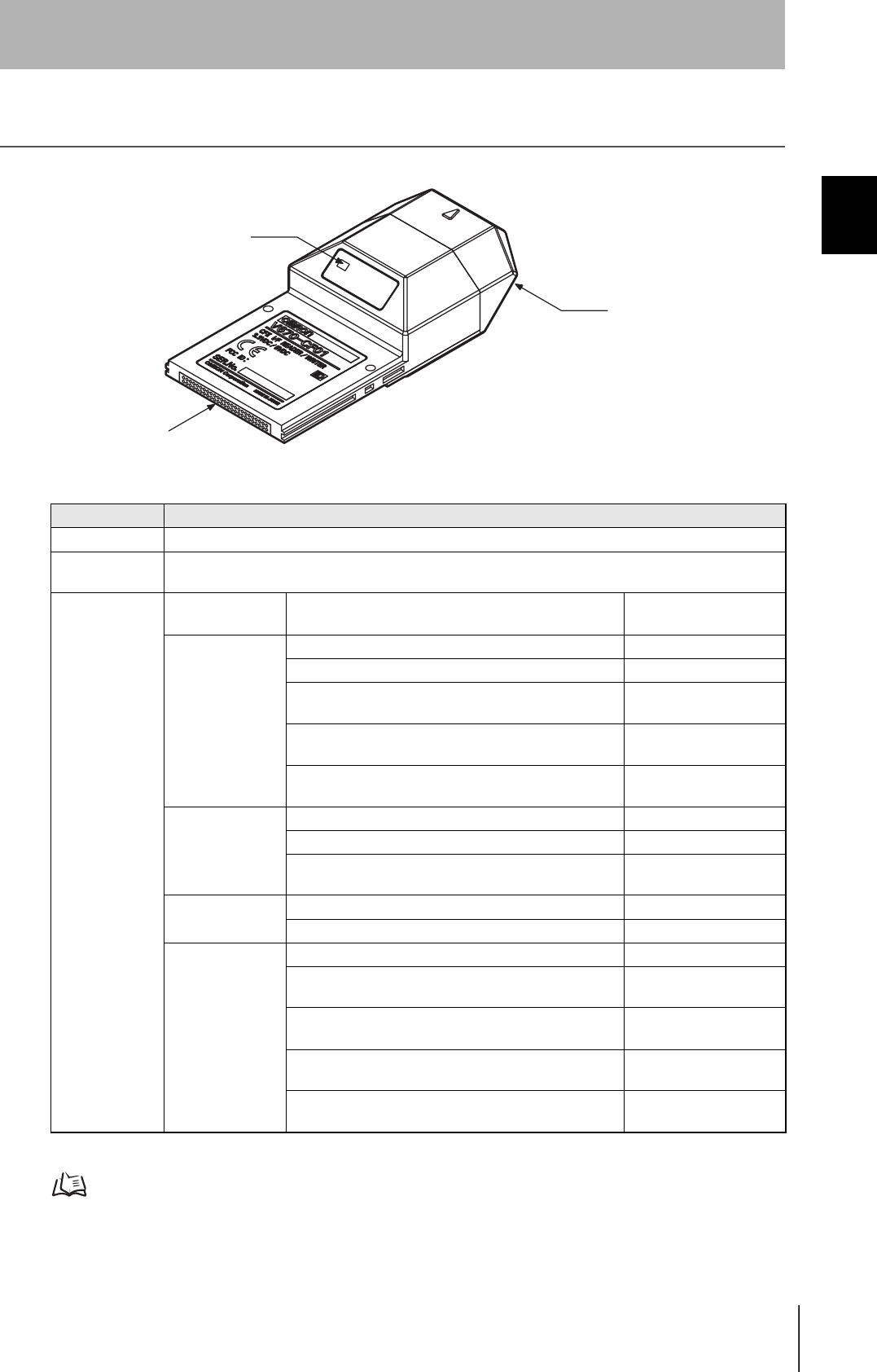
11
Electromagnetic Inductive RFID System
User's Manual
SECTION 1
Part Names and Functions
SECTION 1
Product Outline
Part Names and Functions
* When a CPU error occurs, the indicator will remain lit until the power supply is turned OFF.
p.62 Diagnosis Function
Name Details
Antenna The Antenna is brought close to the Tags in order to communicate with them.
CF card section
(Type II)
The interface for connection with a Handy Terminal. Conforms to the CF Card specification: Compact Flash
Specification Revision 2.0.
Indicator Status Description Lit time and number of
flashes
Green, lit Command received from Handy Terminal 3 s
Communications with Tag ended normally 5 s
When the result is “A” (low noise level) for the Noise Mea-
surement command (NS)
5 s
When the result is “0” (normal) for the Error Noise Detec-
tion command (EN)
5 s
When the result is “A” (excellent) for the Stability Evalua-
tion command (SF)
5 s
Green, flashing After completing initialization when power is turned ON 6 times
During communications with a Tag Until communications end
When the result is “B” (good) for the Stability Evaluation
command (SF)
8 times
Red, lit* When an error occurs in communications with a Tag 5 s
When a CPU error occurs Until power is turned OFF
Red, flashing When an error occurs because there is no Tag 10 times
When an error occurs in communications with the Handy
Terminal
5 times
When the result is “B” (high noise level) for the Noise
Measurement command (NS)
15 times
When the result is “1” (error) for the Error Noise Detection
command (EN)
15 times
When the result is “C” (No good) for the Stability Evalua-
tion command (SF)
15 times
CF card section
(Type II)
Indicator
Antenna
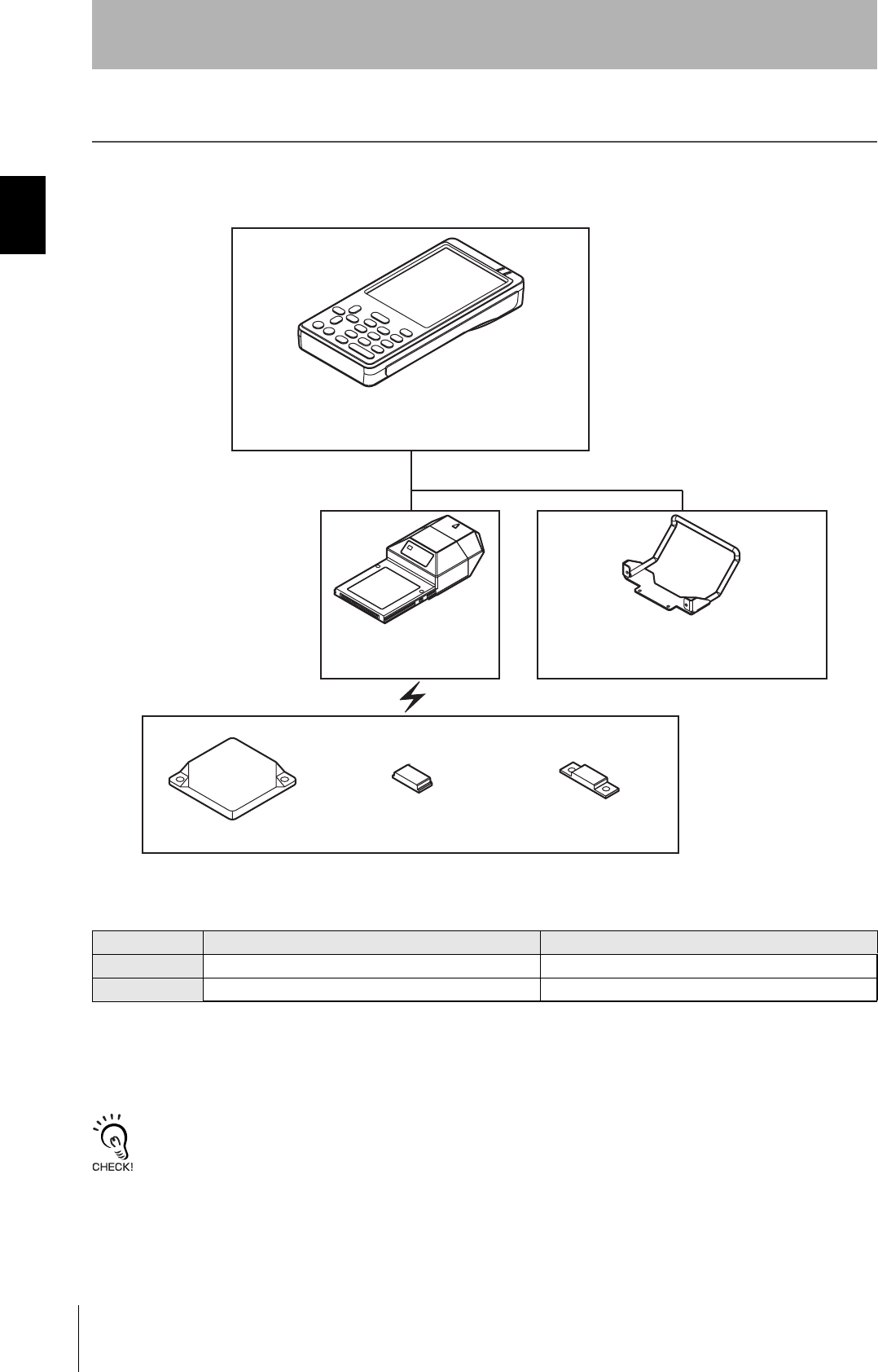
12
SECTION 1
System Configuration
Electromagnetic Inductive RFID System
User's Manual
SECTION 1
Product Outline
System Configuration
The CF Reader/Writer is inserted into a Handy Terminal CF card slot (Type II) and it controls communications
with Tags using serial communications from the Handy Terminal.
* The Handy Terminal manufactured by Symbol Technology is recommended for use in the USA, Canada,
Europe, and China. Contact your local Symbol Technology representative for further information.
http://www.symbol.com/index.htm
Use one of the recommended Handy Terminals listed in the above table. The CF Reader/Writer may not operate correctly if any
other Handy Terminal is used. For Handy Terminal operating procedures, refer to the operating instructions provided by the man-
ufacturer.
Recommended Handy Terminals
Manufacturer Symbol Technology* SHARP
Model PDT8046 RZ-N155S
OS PocketPC2002 Windows CE.NET4.2
V670-CF01
V670-D13F01V670-D13F03 V670-D13F01H
CF card slot
• Manufactured by Symbol
Technology
PDT8046
• Manufactured
by Sharp
RZ-N155S
Recommended Handy Terminals
Protective Cover
•V670-A75SH155S (Manufactured by Sharp)
•V670-A75SY8046 (Manufactured by Symbol
Technology)
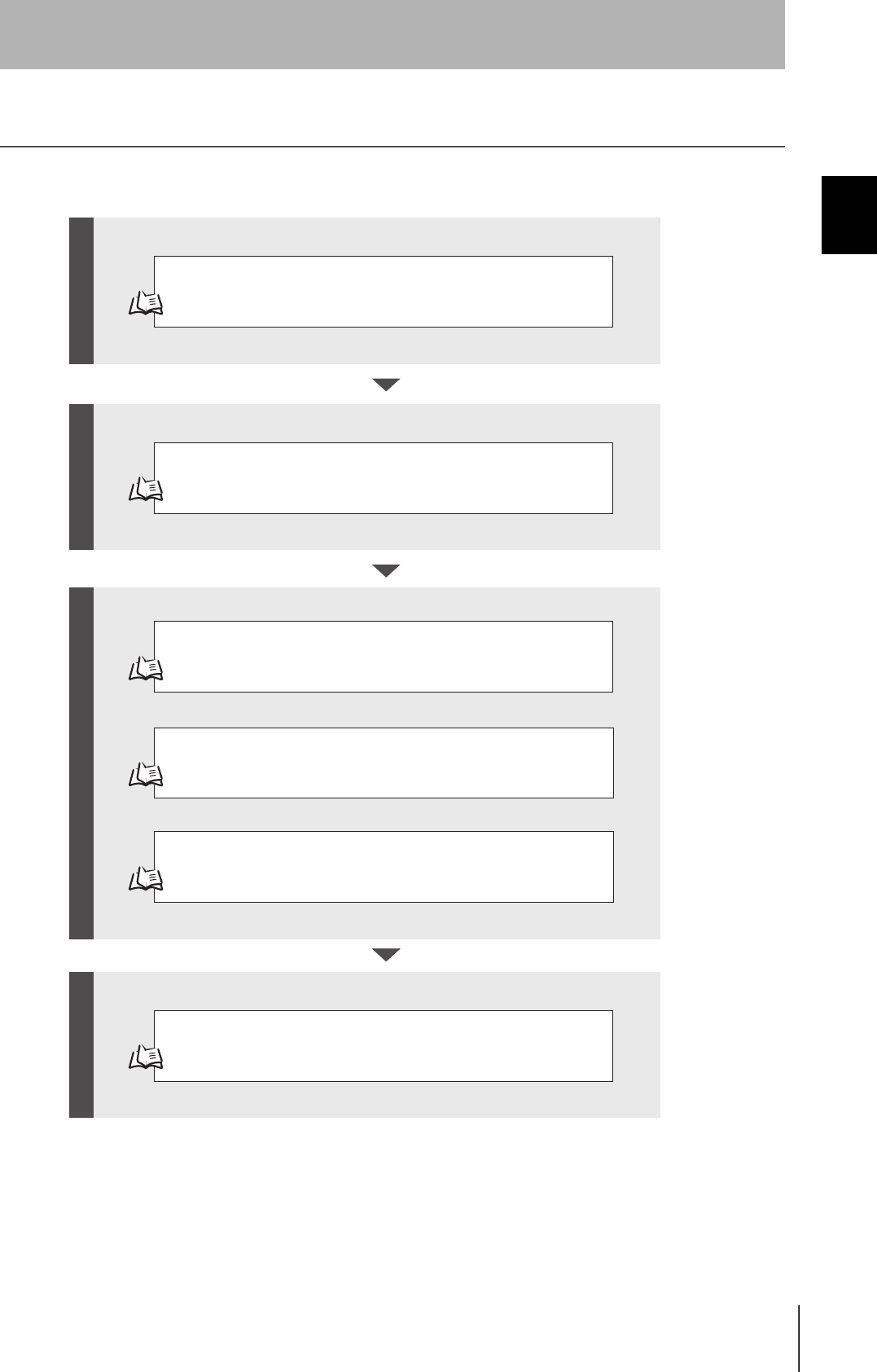
13
Electromagnetic Inductive RFID System
User's Manual
SECTION 1
Application Flowchart
SECTION 1
Product Outline
Application Flowchart
p.16
Connect the CF Reader/Writer.
p.25
Set the Handy Terminal communications conditions.
Preparation
Communications preparation
Trial operation
p.27
Test communications between the Handy Terminal and CF Reader/
Writer.
p.27
Test communications between Tags and the CF Reader/Writer.
p.79
Check the ambient environment.
p.35
Actual communications using commands.
Communications

14
SECTION 1
Application Flowchart
Electromagnetic Inductive RFID System
User's Manual
SECTION 1
Product Outline
MEMO

16
SECTION 2
Connection
Electromagnetic Inductive RFID System
User's Manual
SECTION 2
Communications Preparations
Connection
1. Turn OFF the power supply to the Handy Terminal.
Always turn OFF the power supply to the Handy Terminal before connecting or disconnecting the CF Reader/Writer. For
Handy Terminal operating procedures, refer to the operating instructions provided by the manufacturer.
2. Attach the Protective Cover to the end of the Handy Terminal.
Refer to Protective Covers for the attachment method for the Protective Cover.
p.21 Protective Covers
3. Insert the CF Reader/Writer into the Handy Terminal CF card slot.
Insert the CF Reader/Writer into the CF card slot as shown above. Insert it completely to the back of the CF card slot.
4. After the CF Reader/Writer has been inserted, turn ON the power supply to the Handy Terminal.
The indicator on the CF Reader/Writer will flash after the Handy Terminal power has been turned ON.

17
Electromagnetic Inductive RFID System
User's Manual
SECTION 2
Tags
SECTION 2
Communications Preparations
Tags
Installation Environment
Do not use Tags in the following locations.
• Locations with corrosive gases, flammable gases, or dust
• Locations with an ambient temperature not between −10 and 70°C and locations subject to sudden
temperature fluctuations that may cause condensation
• Inside microwave ovens
Mounting Method
Observe the following precautions when mounting Tags.
• Do not chip or make holes in Tags.
• Do not apply excessive force to Tags.
• Do not mount Tags side-by-side or close to metallic objects.
* Tags may warp if used in an environment subject to repeated high and low temperatures, but this will
not affect Tag functions.
■V370-D13F01(H)
•Mounting Direction
•Mounting Example
Use two M3 screws to mount a Tag.
Marking surface
Mount section
20.5±0.1
Two, M3 holes
(Unit: mm)
Mounting Hole Dimensions
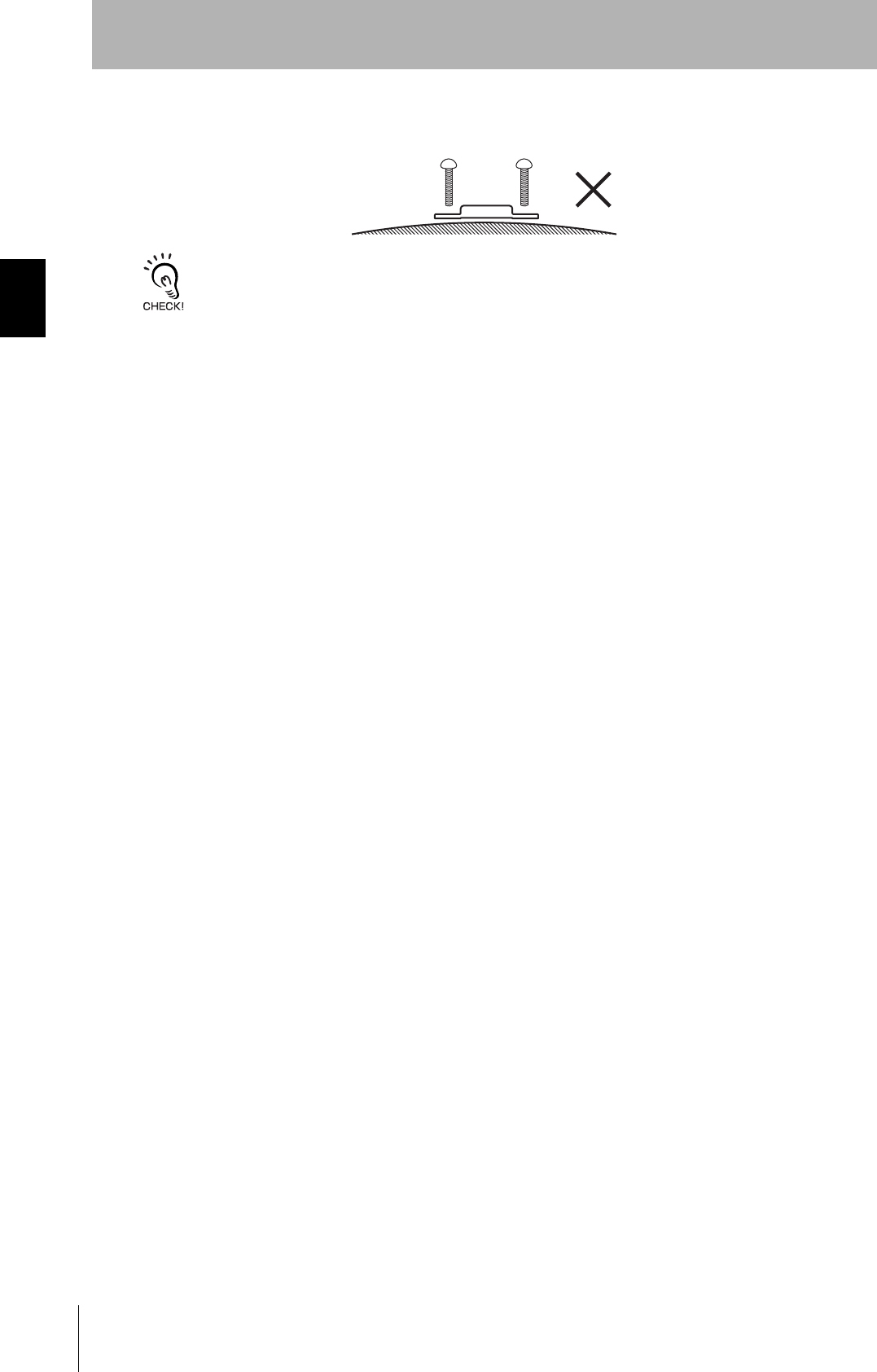
18
SECTION 2
Tags
Electromagnetic Inductive RFID System
User's Manual
SECTION 2
Communications Preparations
* Tags must be mounted on flat surfaces. Do not mount Tags on curved surfaces.
The Tag may be damaged due to tightening stress if it is mounted on a curved surface.
Tighten the M3 screws to a torque of 5 N·m or less.
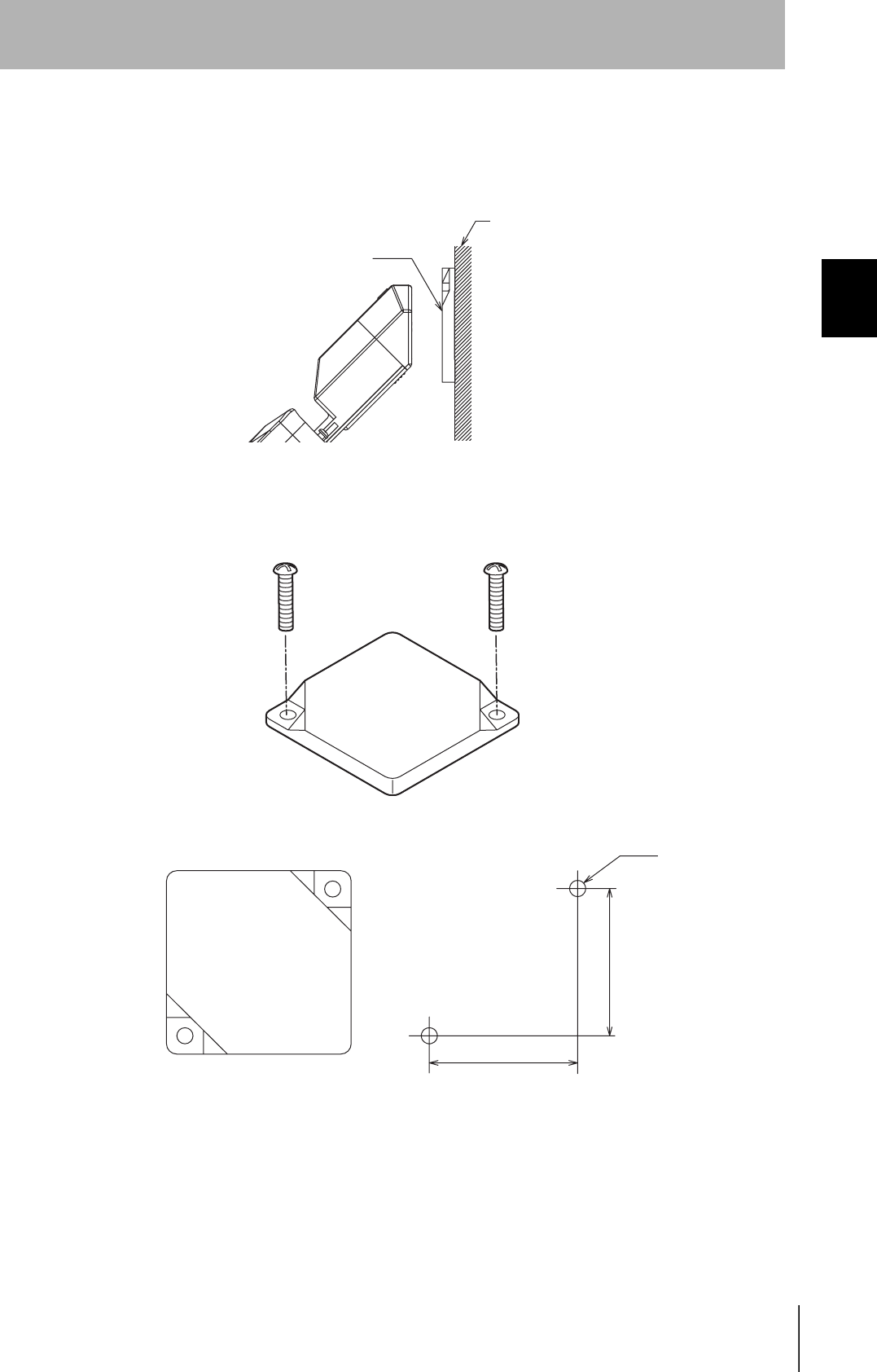
19
Electromagnetic Inductive RFID System
User's Manual
SECTION 2
Tags
SECTION 2
Communications Preparations
■V670-D13F03
•Mounting Direction
Mount the V670-D13F03 Tag so that the front is parallel to the CF Reader/Writer.
•Mounting Example
Use two M3 screws to mount a Tag.
Marking surface
Mounting section
32
32
(Unit: mm)
Two, M3 holes
Mounting Hole Dimensions

20
SECTION 2
Tags
Electromagnetic Inductive RFID System
User's Manual
SECTION 2
Communications Preparations
* Tags must be mounted on flat surfaces. Do not mount Tags on curved surfaces.
The Tag may be damaged due to tightening stress if it is mounted on a curved surface.
Tighten the M3 screws to a torque of 0.6 N·m or less.
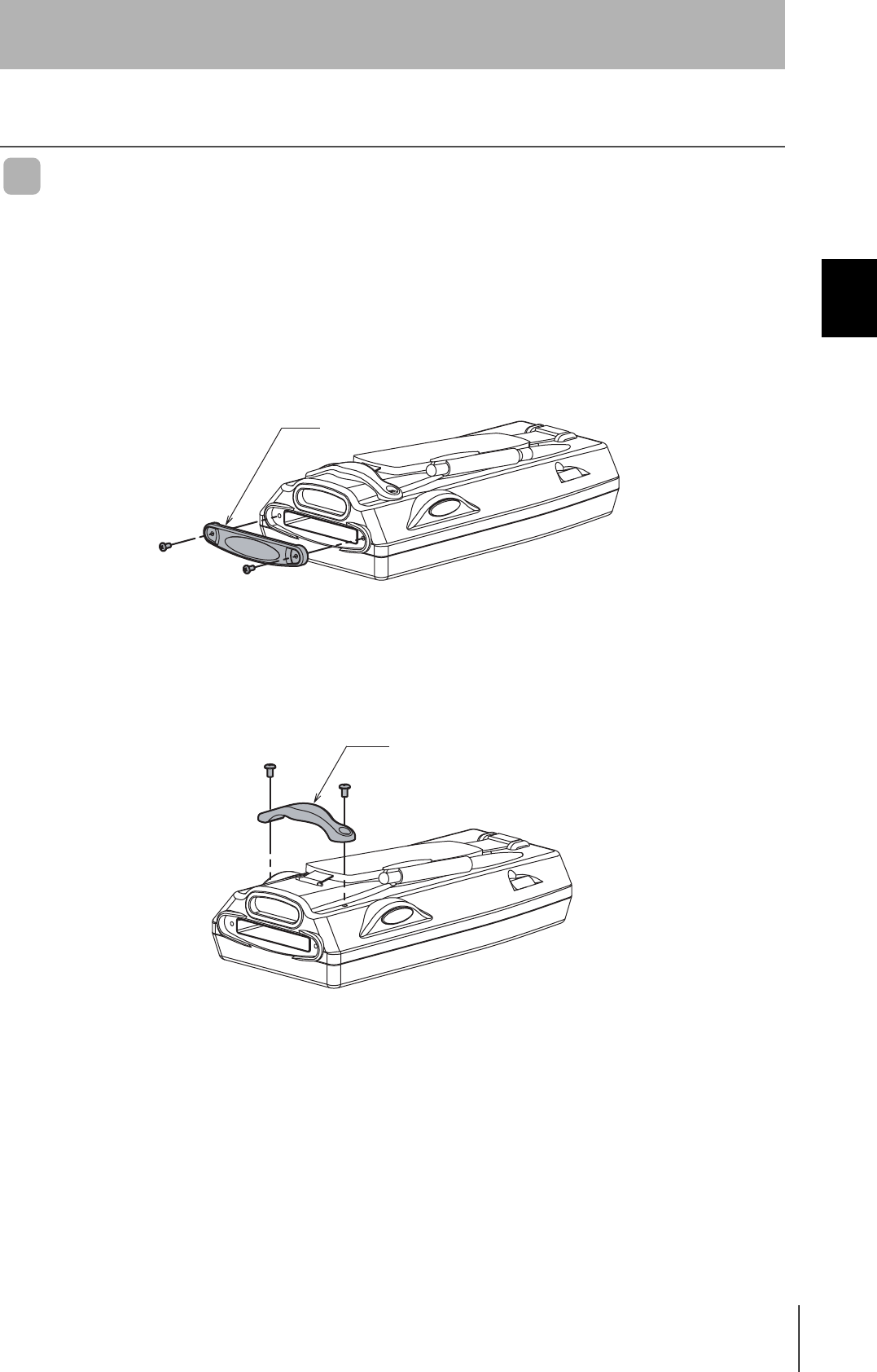
21
Electromagnetic Inductive RFID System
User's Manual
SECTION 2
Protective Covers
SECTION 2
Communications Preparations
Protective Covers
Mounting Method
Protective Covers are mounted with screws.
■V670-A75SY8046 (for Handy Terminals from Symbol Technology)
1. Loosen the screws on the cover at the end of the Handy Terminal and remove the cover.
2. Remove the screws from the hand strap bar and remove the bar.
Cover
Hand strap bar

22
SECTION 2
Protective Covers
Electromagnetic Inductive RFID System
User's Manual
SECTION 2
Communications Preparations
3. Insert the pin as shown in the following diagram to attach the hand strap to the Protective Cover.
4. Secure the Protective Cover to the Handy Terminal with two #4-40 screws and two #2-56 screws.
Tighten the mounting screws to a torque of ??? N·m or less.
Pin
Mounting screws (#4-40)
Mounting screws (#2-56)

23
Electromagnetic Inductive RFID System
User's Manual
SECTION 2
Protective Covers
SECTION 2
Communications Preparations
■V670-A75SH155S (for Handy Terminals from Sharp)
1. Loosen the mounting screws on the cover at the end of the Handy Terminal and remove the cover.
2. Remove the screws shown below from the Handy Terminal.
Cover

24
SECTION 2
Protective Covers
Electromagnetic Inductive RFID System
User's Manual
SECTION 2
Communications Preparations
3. Secure the Protective Cover to the Handy Terminal with the four M2 screws provided with the Protec-
tive Cover.
Tighten the mounting screws to a torque of ??? N·m or less.

25
Electromagnetic Inductive RFID System
User's Manual
SECTION 2
Setting Handy Terminal Communications Conditions
SECTION 2
Communications Preparations
Setting Handy Terminal Communications Conditions
1. Set the same communications conditions for the Handy Terminal and the CF Reader/Writer.
The default settings for the CF Reader/Writer are as follows: Baud rate: 38,400 bps, Data bits: 8 bits, Parity: even, Stop bits: 1 bit.
For Handy Terminal operating procedures, refer to the operating instructions provided by the manufacturer.
Refer to Interface Specifications for details on the communications settings for the CF Reader/Writer.
p.68 Interface Specifications
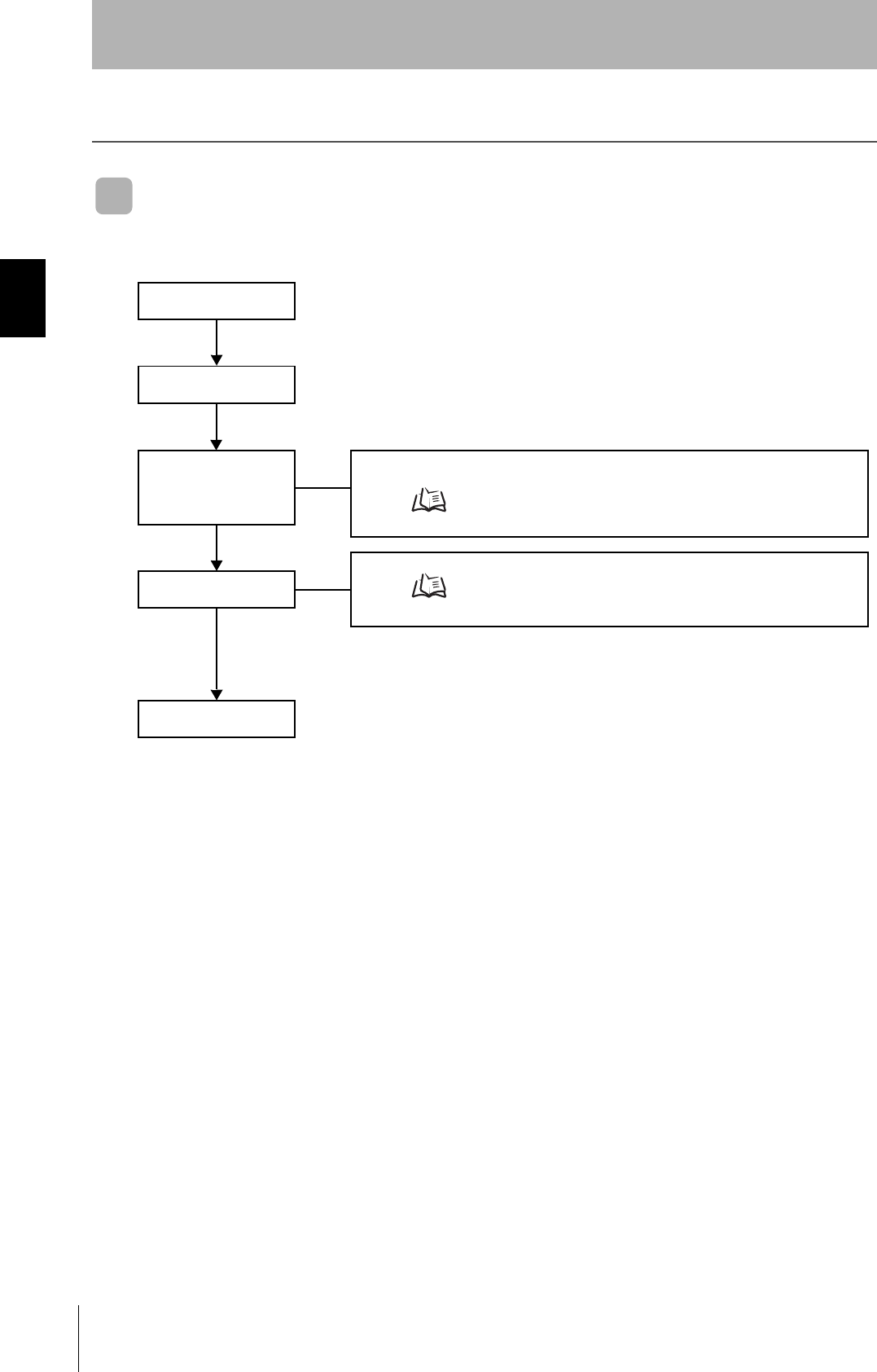
26
SECTION 2
Communications Test
Electromagnetic Inductive RFID System
User's Manual
SECTION 2
Communications Preparations
Communications Test
Procedure for Trial Operation
Turn ON the power.
Test online using
Handy Terminal.
Trial operation of system.
Trial operation completed.
Check communications between Handy Terminal and CF Reader/Writer using a Test
command.
p.27 Testing Communications between Handy Terminal and
CF Reader/Writer
Checking operation using actual commands.
p.27 Testing Communications between Tags and CF Reader/
Writer
Visually check operating
status indicator.
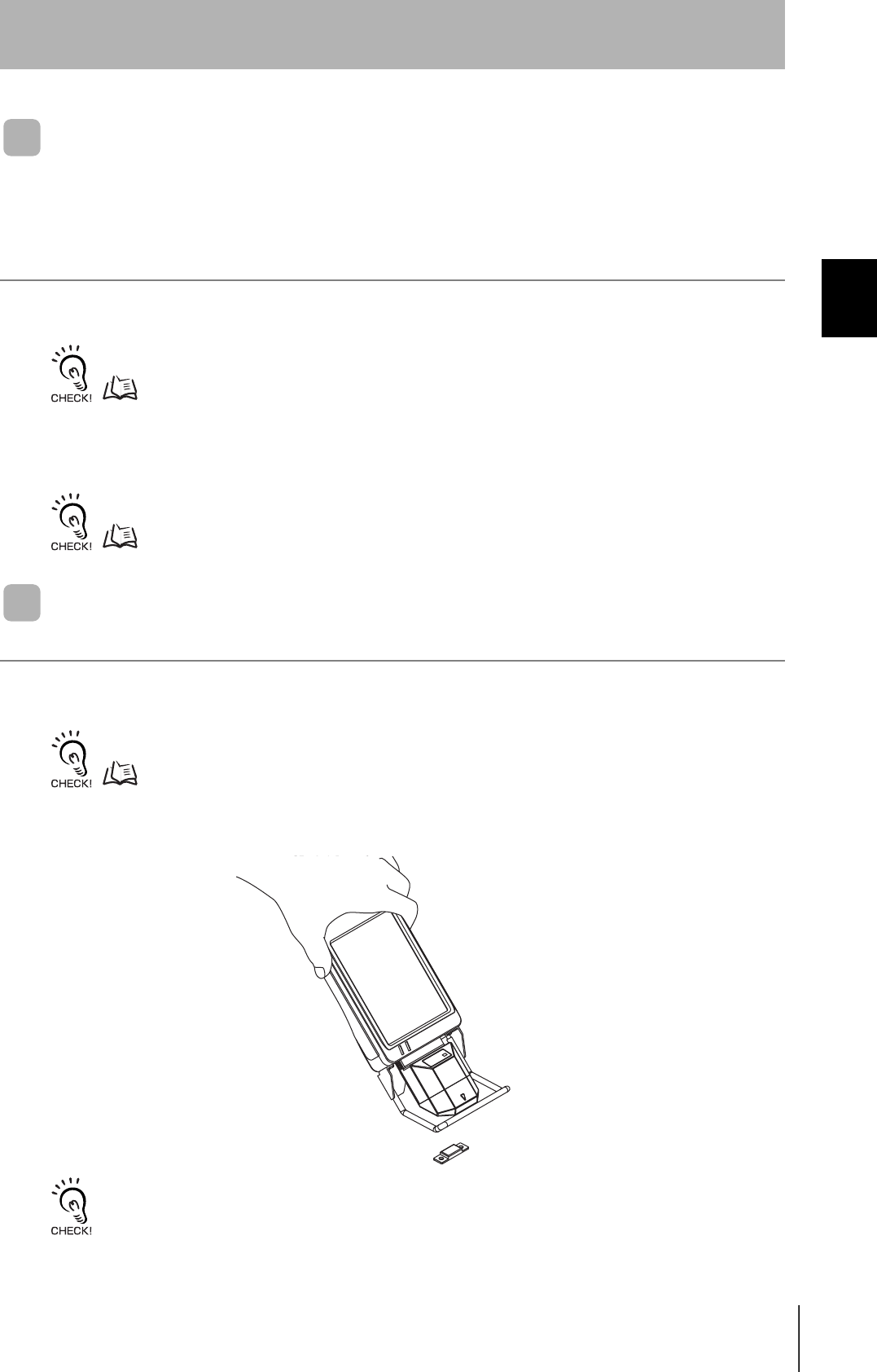
27
Electromagnetic Inductive RFID System
User's Manual
SECTION 2
Communications Test
SECTION 2
Communications Preparations
Testing Communications between Handy Terminal and CF
Reader/Writer
A Test command is used to test communications between the CF Reader/Writer and Handy Terminal.
This enables checking the CF card slot connection and communications processing before performing
trial operation of the system.
1. Send a Test command from the Handy Terminal.
Refer to Tes t (TS ) for information on using the Test command.
p.55 Te st (T S)
2. The CF Reader/Writer will return the received data if the communications network is operating nor-
mally.
Refer to Troubleshooting if there is no response from the CF Reader/Writer.
p.63 Troubleshooting
Testing Communications between Tags and CF Reader/Writer
Actual commands are used to test communications between Tags and the CF Reader/Writer.
1. Enter the Read command from the Handy Terminal.
Refer to Commands for information on how to use the command.
p.35 Commands
2. Bring the antenna on the CF Reader/Writer close to the Tag.
Keep the surface of the antenna on the CF Reader/Writer parallel to the Tag surface.

28
SECTION 2
Communications Test
Electromagnetic Inductive RFID System
User's Manual
SECTION 2
Communications Preparations
3. When the CF Reader/Writer is within the communications area, the data in the Tag’s internal memory
will be read and displayed on the Handy Terminal.
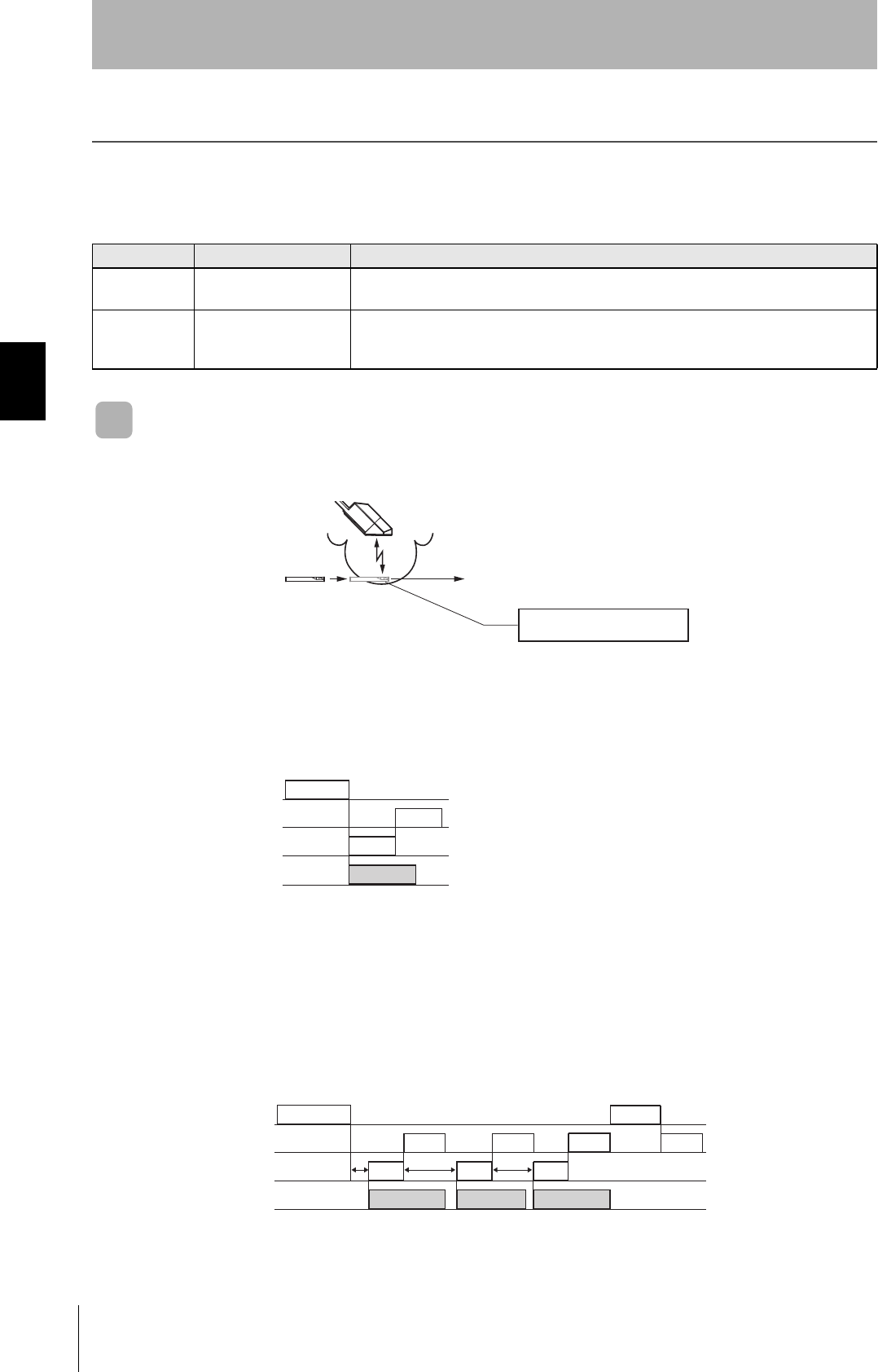
30
SECTION 3
Communications Designation Function
Electromagnetic Inductive RFID System
User's Manual
SECTION 3
Functions
Communications Designation Function
The CF Reader/Writer automatically detects Tags for the communications commands given in the following
table.
Communications Designations (SA/RA)
SA and RA automatically detect Tags and communicate with them.
■SA Designation
When the Single Auto command (SA) is specified, command processing is completed when communi-
cations have been completed.
■RA Designation
When the Repeat Auto command (RA) is specified, the CF Reader/Writer waits for the next Tag each
time communications are completed. Once communications have been performed with a Tag, there
are no more communications with that Tag until the Tag has moved outside the communications area.
This processing is repeated until it is ended when the Command Processing Abort command (AA) is
received.
Symbol Name Description
SA Single Auto command After the Single Auto command has been received, a communication is executed when a
Tag is detected in the communications area and a response is returned.
RA
Repeat Auto command The operation specified under SA is repeatedly executed. The CF Reader/Writer commu-
nicates only once with each Tag, even if that Tag continues to be in the communications
area.
CF Reader/Writer
Tag
Communications are started when a
Tag enters the communications area.
Host to CF Reader/Writer
CF Reader/Writer to Host
Between CF Reader/Writer and Tag
(Tag movement)
Response
Communica-
tions
Tag
SA command
- Processing completed -
Host to CF Reader/Writer
CF Reader/Writer to Host
Between CF Reader/Writer and Tag
(Tag movement)
Response Response
Communi-
cations A
Response
Communi-
cations B
Response
Communi-
cations C
Tag A Tag B Tag C
RA command AA command
- Processing completed -
Waiting for a Tag
Waiting for a new Tag Waiting for a new Tag

31
Electromagnetic Inductive RFID System
User's Manual
SECTION 3
Setting Operating Parameters
SECTION 3
Functions
Setting Operating Parameters
The operating parameters outlined below can be set to optimize CF Reader/Writer performance and reliability,
and to optimize the system itself. If changing the operating parameters, always do so with the power turned
ON. Normally, there are no problems in using the default settings.
• Auto command abort time
• Write verification
The CF Reader/Writer is initialized when the power is turned OFF and the operating parameter settings are not stored.
Refer to Parameter Setting (SP) for information on using the Parameter Setting (SP) command.
p.53
Auto Command Abort Time
When an Auto command is received, the CF Reader/Writer waits until a Tag is detected in the
communications area and then starts communications. If, however, a Tag is not detected within a set
period, processing is aborted and a No Tag error (72) is returned.
A command error will be returned if "00" is set as the Abort auto command time.
* The default setting is 10 s.
Write Verification
Write verification checks that any data written to Tags is correct. A verification error (71) will be
returned if the data is not written correctly.
* The default setting is 1 (write verification enabled).
Refer to Parameter Setting (SP) for information on how to use the Parameter Setting (SP) command.
p.53
Setting range
01 to 60 s
Setting range
0 (write verification disabled)
1 (write verification enabled)
CF Reader/Writer to Tag
Tag to CF Reader/Writer CF
Reader/Writer to Host
External input
Trans-
mission
Response
Auto command abort time
Error 72
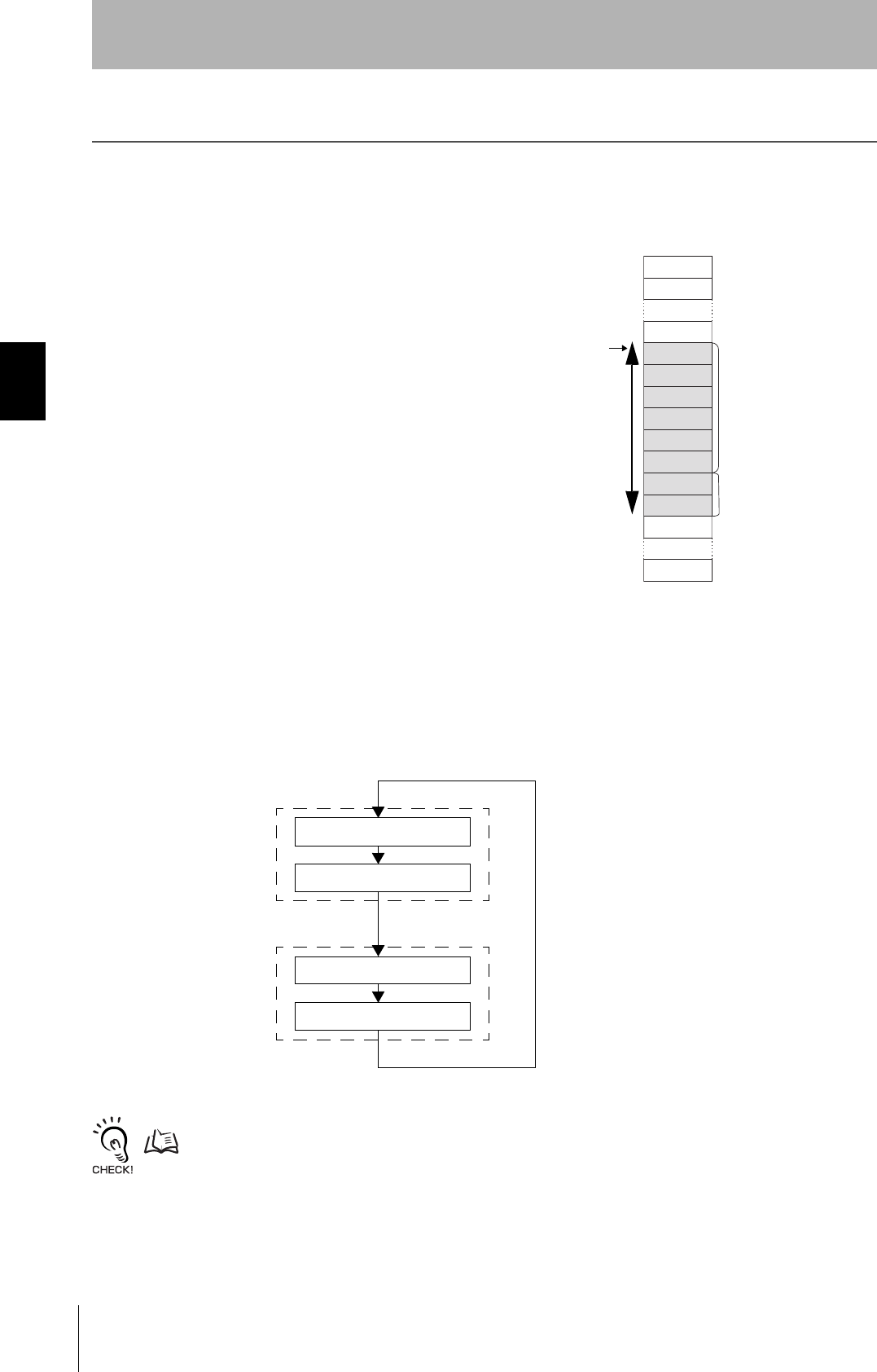
32
SECTION 3
Memory Check Function
Electromagnetic Inductive RFID System
User's Manual
SECTION 3
Functions
Memory Check Function
A check code can be added to the data in a Tag to detect errors from memory write life or unexpected causes.
The polynomial X16 + X12 + X5 + 1 is used to generate a CRC code as the check code.
Use the Memory Check command (MD) to write and verify commands.
In the check block, which is specified using the start
address and the number of bytes, all but the last two bytes
are the calculation area. The last two bytes of the block are
the check code area.
When a Check Code Write command is sent, the CRC
code for the data in the calculation area is calculated and
written to the check code area. When a Data Verify
command is sent, the CRC code for the data in the
calculation area is calculated and compared to the data in
the check code area. When the data matches, “0” is
returned as the response status flag to indicate that the
data is normal. If the data does not match, “1” is returned
as a warning.
Calculate and write the check code using the Memory Check command (MD) after writing data and verify the
check code before reading data. This enables detecting in advance data corruption in Tags that can occur
while the Tags are not being accessed.
Refer to Memory Check (MD) when using the Memory Check function.
p.48
Check code calculation area
(check block bytes − 2)
Area start address
Check code area (2 bytes)
Address
00
01
CRC (leftmost)
CRC (rightmost)
Data write
Check code calculation
Check code verification
Data read
Writing stage
Reading stage

33
Electromagnetic Inductive RFID System
User's Manual
SECTION 3
Write Protection
SECTION 3
Functions
Write Protection
The write protection function is a protective function designed to prevent fixed data, such as palette
information or product information, stored in a Tag memory from being erased by accidental overwriting. Any
area of specified addresses can be write protected (a maximum of two areas) by setting protection information
in the Tag. A protection error will occur if a write is executed for any write-protected page.
Part of the user data area ($0000 to $0003) is used for protection area information.
To enable write protection, write the protection area information to a specified address and then use the Tag
Function Setting command (TF) to specify “Protection Setting” in the process designation parameter.
Similarly, to disable write protection, specify “Disable” in the process designation parameter.
Refer to Tag Function Designation (TF) when using the write protection function.
p.49
* Range for protection area: 0004h to 007Fh
Area $0000 to $0003 cannot be used as data area if the write protection function is used.
Relationship between Protection Information and Protection Area
User address Description Data example
$0000 Start address of write protection area 1 05h
$0001 End address of write protection area 1 10h
$0002 Start address of write protection area 2 70h
$0003 End address of write protection area 2 75h
$0004
User area
$0005
Write protection area
1
.
.
$0010
$0011
.
.
$006F
$0070
Write protection area
2
.
.
$0075
$0076
$007F

34
SECTION 3
Write Protection
Electromagnetic Inductive RFID System
User's Manual
SECTION 3
Functions
MEMO

SECTION 4
Commands
35
Electromagnetic Inductive RFID System
User's Manual
SECTION 4
Commands
CF Reader/Writer Operation Status 36
Command Response Format 37
Command Frames 37
Response Frames 37
Data Type Designation 38
Ranges for Start Address and Number of Bytes 39
Command Response Flow 40
No Response 40
Single Response 40
Multiple Responses 40
Command List 41
Communications Designations 43
Communications Commands 44
Communications Subcommand 52
Controller Control Commands 53
Host Commands 55
Appraisal Commands 56
End Code List 59
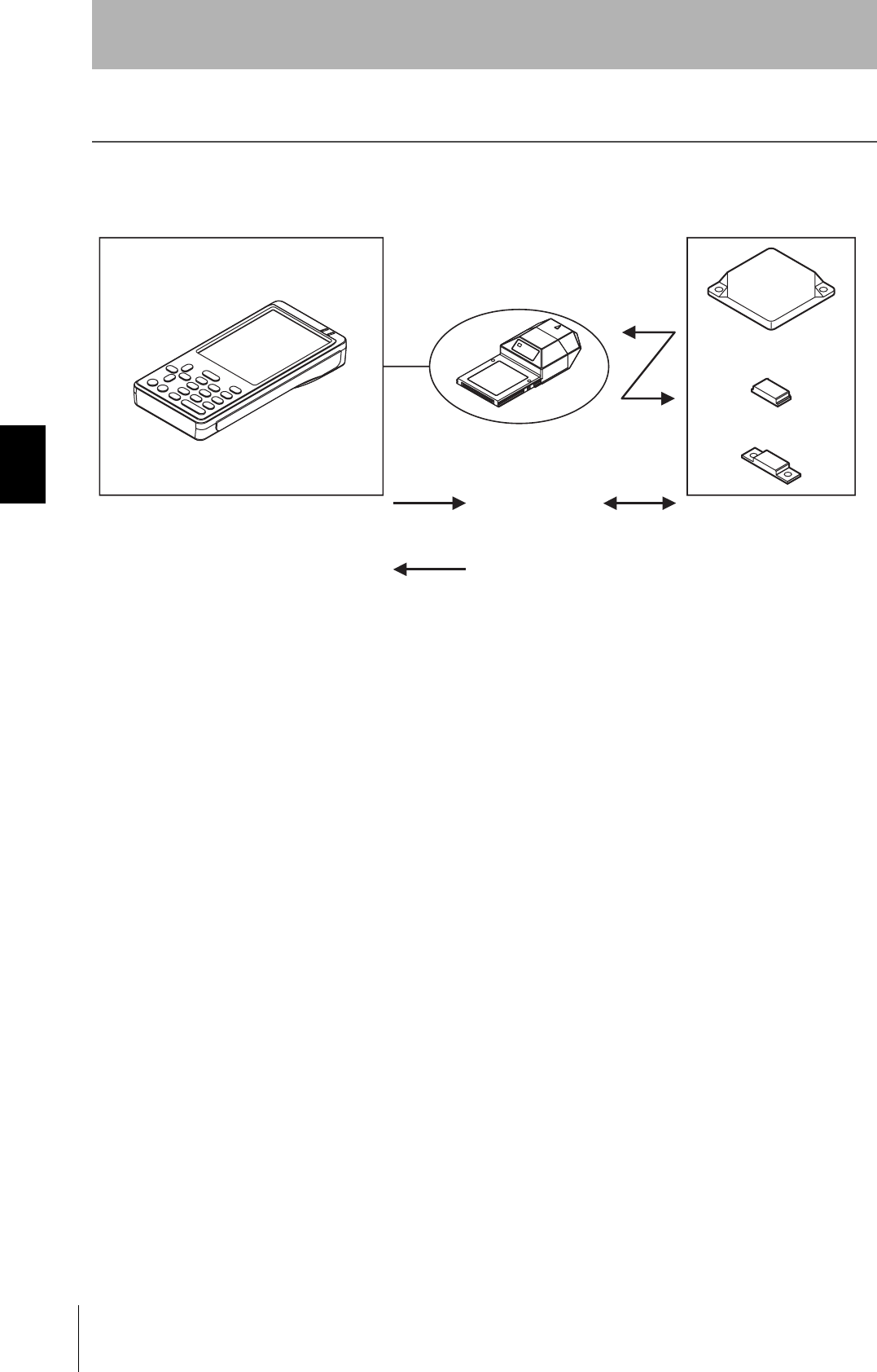
36
SECTION 4
CF Reader/Writer Operation Status
Electromagnetic Inductive RFID System
User's Manual
SECTION 4
Commands
CF Reader/Writer Operation Status
The CF Reader/Writer communicates with a Tag (2) according to the command (1) sent from the connected
Handy Terminal, and returns the result as a response (3) to the Handy Terminal.
■CF Reader/Writer Operation Status
•Command Standby Status
This is the status where the CF Reader/Writer is not processing any commands, but can accept any
command except subcommands. When a command is received, the CF Reader/Writer enters the
command processing status.
•Command Processing
Once a command has been received, the CF Reader/Writer ignores the next command until process-
ing of the received command has been completed. Command processing abort and reset commands,
however, can always be received.
CF Reader/Writer
Communi-
cations
Ta g Handy Terminal
Communications between the CF
Reader/Writer and the Tag
Command
Response
(1)
(3)
(2)
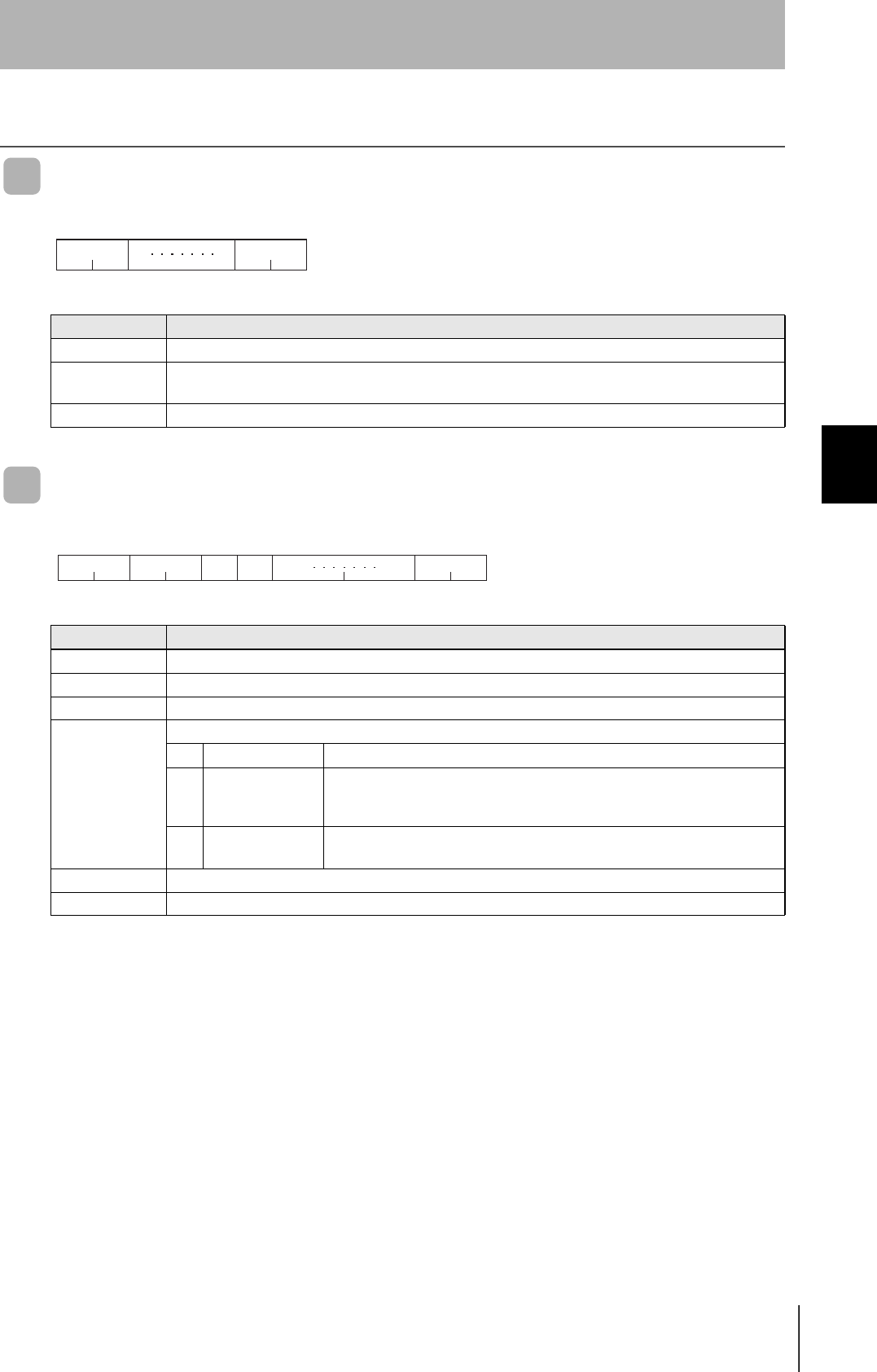
37
Electromagnetic Inductive RFID System
User's Manual
SECTION 4
Command Response Format
SECTION 4
Commands
Command Response Format
Command Frames
Response Frames
Name Description
Command code Specifies the command.
Data Specifies the parameters for command execution (address, number of bytes, etc.) or specifies the data to
be written.
Terminator Indicates the end of a command, using the two characters “*” ($2A) and the carriage return code ($0D).
Name Description
Command code The same data as the sent command frame is added and returned.
End code Shows the command execution result.
Retry flag Always 0.
Status flag A code that shows the status of command execution.
0 Normal Indicates that the processing was completed normally.
1 Tag data status Indicates that the verification result of the Memory Check command (MD)
detected an error, or that an overflow/underflow occurred in the calculation of a
Computation Write command (CW).
2 Abort status Indicates a communication with a Tag was aborted after it was started, using
the aborting command (AA).
Data Provides the data read according to the command.
Terminator Indicates the end of a command, using the two characters “*” ($2A) and the carriage return code ($0D).
CR㧖
2n2
Command code Data Terminator
㧖CR
2n
212 1
Command code Data Terminator Retry flag End code
Status
flag

38
SECTION 4
Command Response Format
Electromagnetic Inductive RFID System
User's Manual
SECTION 4
Commands
Data Type Designation
The data type to be used when transmitting read or write data between the CF Reader/Writer and the
Handy Terminal can be specified in a command. Either ASCII or hexadecimal can be used.
■ASCII (JIS8 Unit Code) Designation “A”
One byte of data in a Tag is transmitted directly as ASCII or JIS8 unit code. Each transmitted character
is equivalent to 1 byte of data in the Tag. Character data can be directly read or written, but do not use
the carriage return (CR) control code in send data. If the CR control code is used in write data, a com-
mand error will occur.
•Data Write Example
If “V670” is specified as the write data for 4 bytes of memory begin-
ning with the address 10h, the data is written to the Tag memory
as shown in the diagram.
•Data Read Example
If 4 bytes of memory is read starting with address 10h, the read
data will be “V670” for the data shown in the diagram.
■Hexadecimal (JIS8 Unit Code) Designation “H”
One byte of Tag data is converted to two hexadecimal characters (00 to FF) and transmitted. Each
transmitted character is equivalent to 2 bytes of data in the Tag. Always set write data in the 2-charac-
ter units 00 to FF (i.e., as an even number of characters). A command error will occur if an odd number
of characters is accidentally set.
•Data Write Example
If “56363730” is specified as the write data for 4 bytes of memory
beginning with the address 10h, the data is written to the Tag
memory as shown in the diagram.
•Data Read Example
If you read 4 bytes of memory starting with address 10h, the read data will be "56363730" for the data
shown in the diagram.
10h
11h
12h
13h
5
3
3
3
6
6
7
0
̌V̍
̌6̍
̌7̍
̌0̍
Address
Tag memory
WTSAA1001004V670㧖CR
ASCII
desig-
nation
Antenna
designa-
tion
Start address
Communica-
tions desig-
nation
Command No. of bytes Write data
Command
CRRD0 0 00 V6 70㧖
Retry
flag Status
flag Read data End code Command
Response
10h
11h
12h
13h
5
3
3
3
6
6
7
0
Address
Tag memory
㧖CR45636WTS A H 1 0 0 1 0 0 3730
HEX
desig-
nation
Antenna
designa-
tion
Start address
Communica-
tions desig-
nation
Command Write data No. of bytes
Command
RD0 0 0 0 56 36 CR㧖
37 30
Retry
flag Status
flag Read data End code Command
Response

39
Electromagnetic Inductive RFID System
User's Manual
SECTION 4
Command Response Format
SECTION 4
Commands
Ranges for Start Address and Number of Bytes
The following table shows the commands and available designation range for specifying start
addresses and number of bytes in commands. If a value outside the available range is specified, a
command error will occur.
* If the start address is 20h and the number of bytes is 70h, the result is A + B = 90h, which gives a
command error.
Command code Ranges for start address and number of bytes Other restrictions
Read (RD) A) Start address:
B) No. of bytes:
0000h to 007Fh
01h to 80h A+B ≤ 80h*
Write (WT) A) Start address:
B) No. of bytes:
0000h to 007Fh
01h to 80h A+B ≤ 80h*
Computation Write (CW) A) Start address:
B) Calculation area:
0000h to 007Fh
01h to 04h A+B ≤ 80h*
Data Fill (DF) A) Start address:
B) End address:
0000h to 007Fh
0000h to 007Fh A ≤ B
Memory Check (MD) A) Start address:
B) No. of check bytes:
0000h to 007Dh
03h to 80h A+B ≤ 80h*
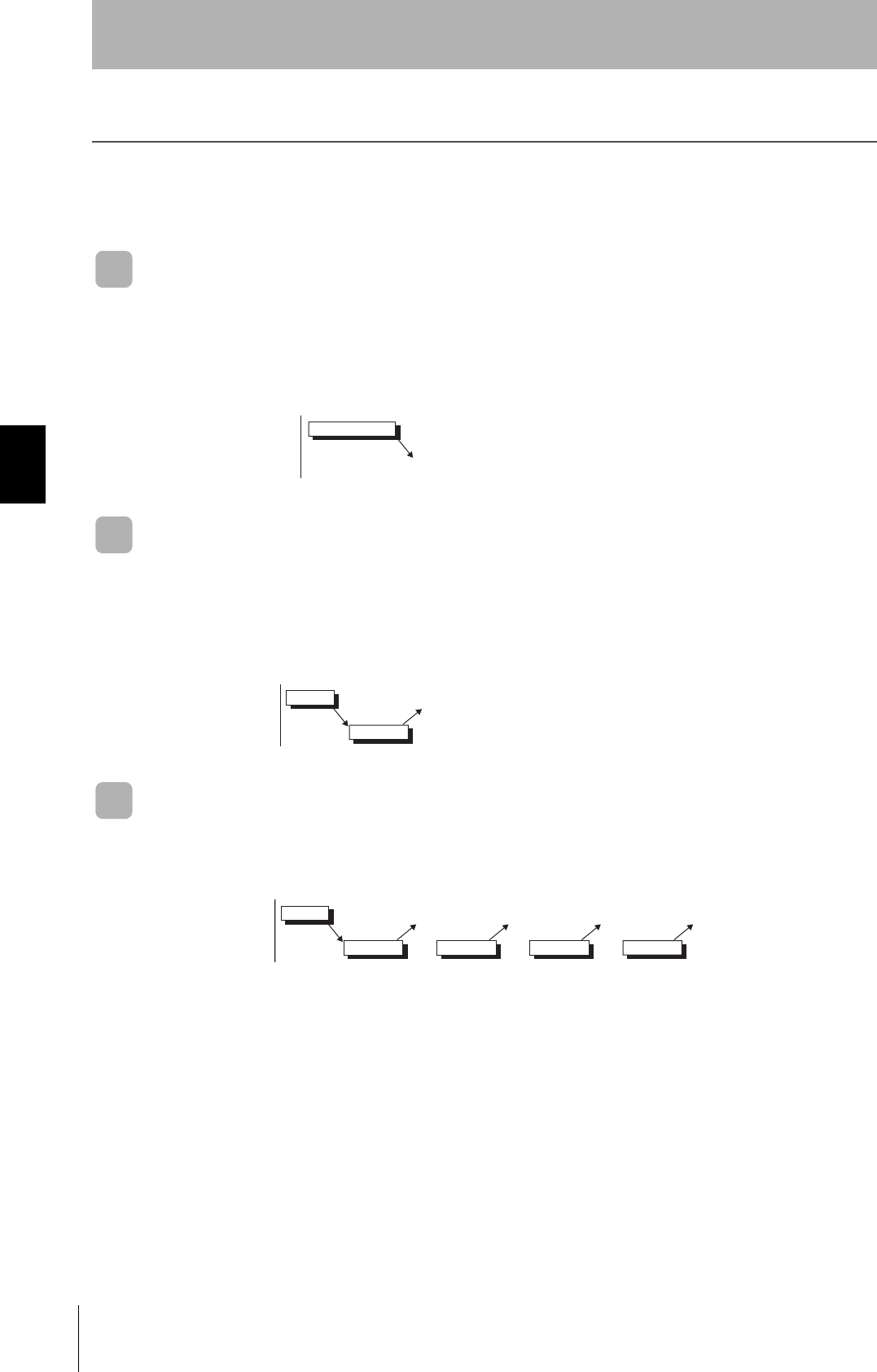
40
SECTION 4
Command Response Flow
Electromagnetic Inductive RFID System
User's Manual
SECTION 4
Commands
Command Response Flow
The command received from the Handy Terminal by the CF Reader/Writer may be different to the response
sent to the Handy Terminal from the CF Reader/Writer, depending on the type of command and the
communications designation.
No Response
If the CF Reader/Writer receives a reset command, it sends no response, performs reset processing,
and waits for the next command.
The indicator will light green when the CF Reader/Writer receives a command. After sending a com-
mand, check the indicator to be sure that the CF Reader/Write has received the command.
Single Response
One response is returned for one command when single auto (SA) is specified in a command for com-
municating with Tags, when commands that are not for communicating with Tags (communications
subcommand, controller control commands, or host commands) are specified when appraisal com-
mands are specified, etc.
Multiple Responses
Multiple responses are returned for one command when repeat auto (RA) is specified in a command
for communicating with Tags.
Host device
CF Reader/Writer
Reset command
Executes reset processing
Command
Response
Host device
CF Reader/Writer
Command
Response Response Response Response
Host device
CF Reader/Writer
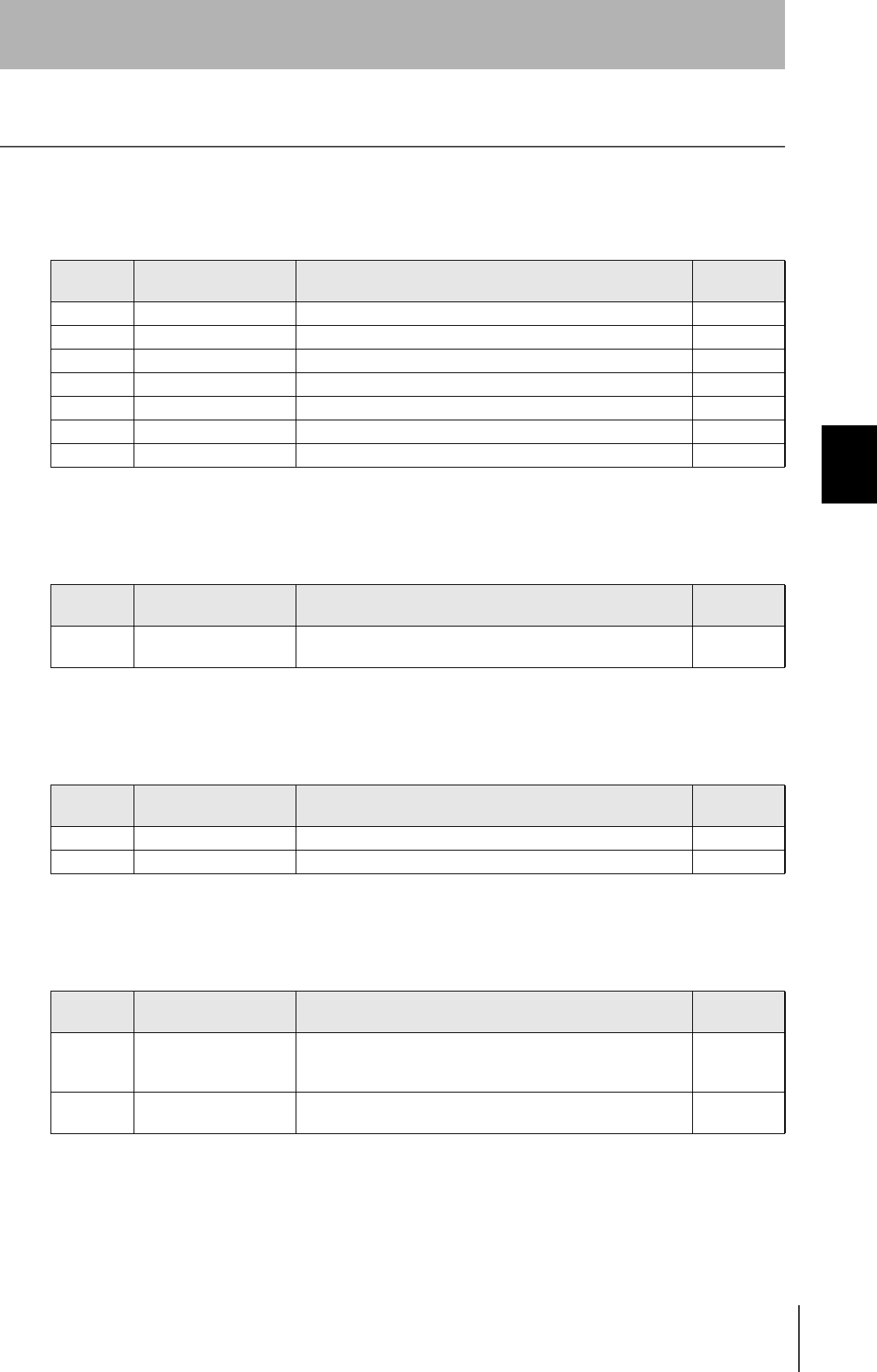
41
Electromagnetic Inductive RFID System
User's Manual
SECTION 4
Command List
SECTION 4
Commands
Command List
There are 6 main types of commands.
■Communications Commands
Communications commands communicate with Tags.
■Communications Subcommand
The communications subcommand aborts command execution.
■Controller Control Commands
Controller control commands stop communications with Tags, reset the CF Reader/Writer., etc.
■Host Commands
Host commands test communications between the CF Reader/Writer and the Handy Terminal.
Command
code Name Description Reference
page
RD Read Reads Tag memory data. p.44
WT Write Writes data to Tag memory. p.45
CW Computation Write Writes memory data and the calculation result to Tags. p.46
DF Data Fill Writes designated data to a designated area. p.47
MD Memory Check Sets and verifies Tag memory check codes. p.48
TF Tag Function Designation Sets/clears the write protection for Tags. p.49
ID ID Read Reads the Tag user ID. p.51
Command
code Name Description Reference
page
AA Command Processing
Abort
Aborts communications with a Tag. p.52
Command
code Name Description Reference
page
SP Parameter Setting Sets all CF Reader/Writer parameters. p.53
XZ Reset Resets the CF Reader/Writer. p.54
Command
code Name Description Reference
page
TS
Test Checks the status of communications between the Handy Terminal
and the CF Reader/Writer.
Returns data received from the Handy Terminal to as is.
p.55
VS Version Information Reads the CF Reader/Writer model information, software version,
and creation date.
p.55

42
SECTION 4
Command List
Electromagnetic Inductive RFID System
User's Manual
SECTION 4
Commands
■Appraisal Commands
Appraisal commands investigate the occurrence of ambient noise and evaluate communications stabil-
ity.
Command
code Name Description Reference
page
NS Noise Measurement Detects noise level. p.56
EN Error Noise Detection Detects noise above a certain level. p.57
SF Stability Evaluation Reads data from the Tag and evaluates the received data. p.58
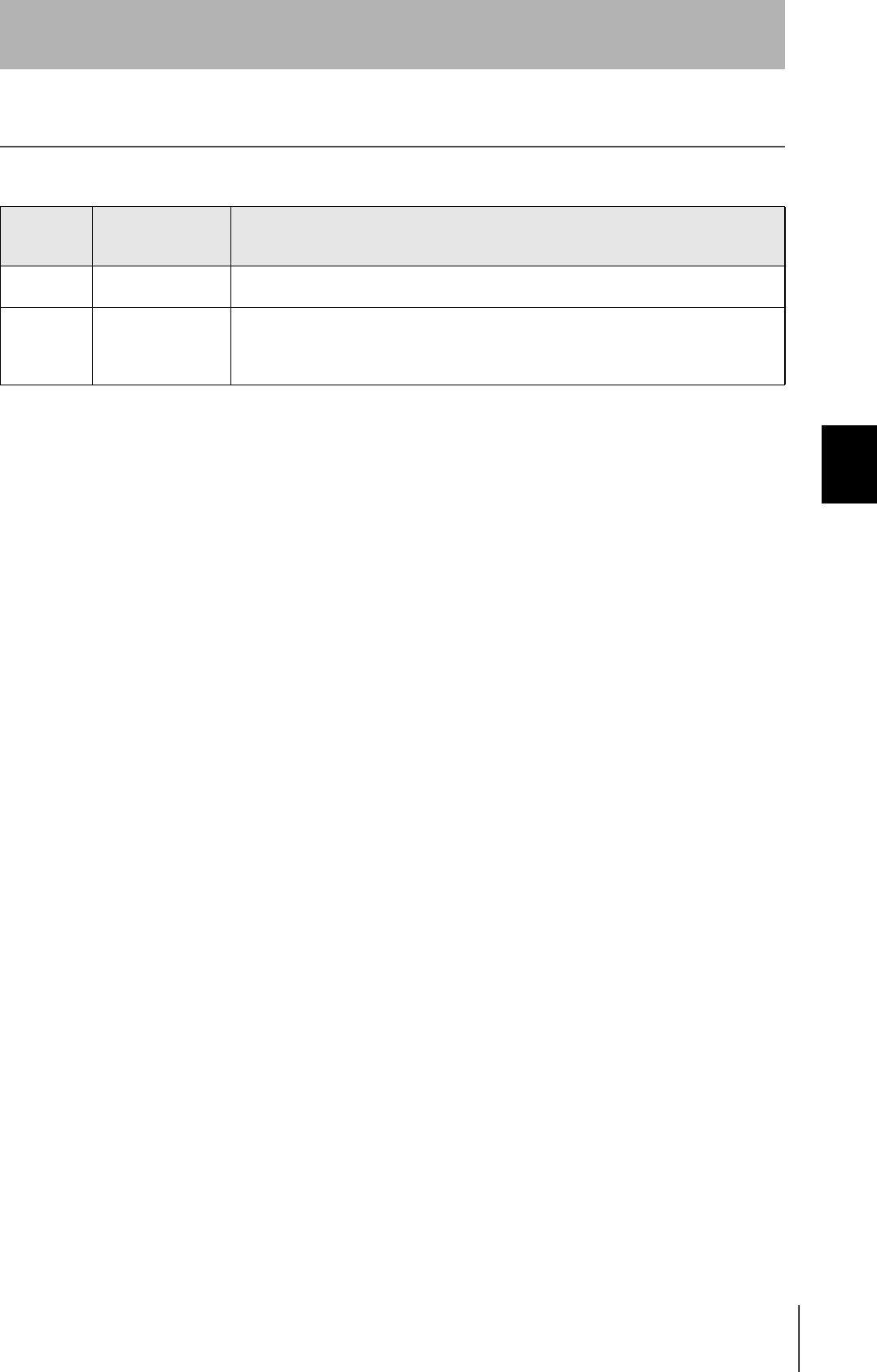
43
Electromagnetic Inductive RFID System
User's Manual
SECTION 4
Communications Designations
SECTION 4
Commands
Communications Designations
The following two communications designations can be specified using communications commands.
Communica-
tions desig-
nation code
Name Description
SA Single auto After the Single Auto command has been received, a communication is executed when a Tag is
detected in the communications area and a response is returned.
RA
Repeat auto The operation specified under SA is repeatedly executed. The CF Reader/Writer
communicates only once with each Tag, even if that Tag continues to be in the communications
area. Processing can be canceled by the Command Processing Abort command and the
Parameter Setting command (auto command abort time).

44
SECTION 4
Communications Commands
Electromagnetic Inductive RFID System
User's Manual
SECTION 4
Commands
Communications Commands
This section describes the commands used for communicating with Tags.
Read (RD)
Reads data from the area specified by start address and number of bytes.
Example: Reading 8 Bytes of Data Starting from Address 0000h (Single Auto, Hexadecimal)
Send data: RDSAH1000008*[CR]
Receive data: RD00001234567812345678*[CR]
Specify the total number of read bytes so that the sum of the read area start address and the number of bytes does not
exceed the Tag memory capacity (128 bytes).
Example: The number of bytes can be specified between 01h and 70h for a start address of 0010h.
Communications
designation
Specifies the method for communicating with a Tag.
Refer to Communications Designations for details.
p.43
Data designation Specifies the data format when sending the read data response.
“A”: ASCII
“H”: Hexadecimal
Antenna designation Always “1”.
Read area start address Specifies the start address in the Tag memory area for reading data in four hexadecimal digits.
Specification range: 0000h to 007Fh
No. of read bytes Specifies the number of bytes of data to be read from the Tag in two hexadecimal digits.
The maximum number of characters that can be read at one time is 256.
Specification range: 01h to 80h
Read data Data read from the Tag.
The number of characters is the number of read bytes in ASCII, and the
number of read bytes times 2 in hexadecimal.
2 22211 4
㧖CR
Command
code "RD" Data
desig-
na-
tion
Antenna
designa-
tion
Read area start
address No. of read
bytes
Communica-
tions desig-
nation
Command
2211 2
㧖CR
Command
code "RD" Retry
flag Status
flag
End code
"00"
Specified number of bytes
Read data
Response

45
Electromagnetic Inductive RFID System
User's Manual
SECTION 4
Communications Commands
SECTION 4
Commands
Write (WT)
Writes the specified number of bytes of data starting from the specified start address to a Tag.
Example: Writing 4 Bytes of Data (“11223344”) from Address 0010h (Single Auto, Hexadecimal)
Send data: WTSAH100100411223344*[CR]
Receive data: WT0000*[CR]
Specify the total number of write bytes so that the sum of the write area start address and the number of bytes does not
exceed the Tag memory capacity (128 bytes).
Example: The number of bytes can be specified between 01h and 70h for a start address of 0010h.
Communications
designation
Specifies the method for communicating with a Tag.
Refer to Communications Designations for details.
p.43
Data designation Specifies the data format when sending write data to Tags.
“A”: ASCII
“H”: Hexadecimal
Antenna designation Always “1”.
Write area start address Specifies the start address in the Tag memory area for writing data in four hexadecimal digits.
Specification range: 0000h to 007Fh
No. of write bytes Specifies the number of bytes of data to be written to the Tag in two hexadecimal digits.
Specification range: 01h to 80h
Write data Data written to Tags.
There will be 2 characters per byte if hexadecimal is specified.
2 2 211 4 2
㧖CR
Command
code "WT" Data
desig-
na-
tion
Antenna
designa-
tion
Write area start
address
Communica-
tions designa-
tion
No. of write
bytes
Specified number of bytes
Write data
Command
22112
㧖CR
Command
code "WT" Retry
flag Status
flag
End code
"00"
Response

46
SECTION 4
Communications Commands
Electromagnetic Inductive RFID System
User's Manual
SECTION 4
Commands
Computation Write (CW)
Performs a hexadecimal calculation using the data in Tag memory and the calculation data and writes
the result to the Tag. If an overflow occurs for addition or an underflow occurs for subtraction, the data
is not written to the Tag and “1” is returned for the status flag.
Example: Writing 2 Bytes of Data, the Result of Subtracting the Subtraction Data “0002” from “0010”,
the Data Starting at Address 0001h (Single Auto, Initial Value: “0010”)
Send data: CWSAS10001020002*[CR]
Receive data: CW0000000E*[CR]
This command performs hexadecimal calculations, so specify hexadecimal for all data being handled. Also, set the cal-
culation area so that it is contained within one page. If the calculation area is not contained within one page, a com-
mand error will occur.
p.83 Memory Map
Communications
designation
Specifies the method for communicating with a Tag.
Refer to Communications Designations for details.
p.43
Process designation Specifies the calculation method.
“A”: Hexadecimal addition
“S”: Hexadecimal subtraction
Antenna designation Always “1”.
Calculation area start
address
Specifies the start address in the Tag memory area for calculating data in four hexadecimal digits.
Specification range: 0000h to 007Fh
No. of bytes in calculation
area
Specifies the number of bytes of calculation data in the calculation area in two hexadecimal digits.
Specification range: 01h to 04h
Calculation data Specifies in hexadecimal the number to be used in the calculation.
Results data Returns the calculation results data written to the Tag.
The data before the calculation was performed will be returned if addition gives an overflow or
subtraction gives an underflow. The status flag will be “1” in these cases.
2 2 211 4 2
㧖CR
Command
code "CW" Proc-
ess
desig-
nation
Antenna
designa-
tion
Calculation area
start address
Communica-
tions desig-
nation
No. of bytes
in calculation
area
Specified number of bytes
Calculation data
Command
2211 2
㧖CR
Command
code "CW" Retry
flag Status
flag
End code
"00" Results data
Specified number of bytes
Response

47
Electromagnetic Inductive RFID System
User's Manual
SECTION 4
Communications Commands
SECTION 4
Commands
Data Fill (DF)
Writes one or two bytes of the same data to a specified Tag area. The write data is specified in hexa-
decimal.
Example: Writing Fill Data “00FF” from Address 0000h to 0007Fh (Single Auto, Writing 2 Bytes)
Send data: DFSAW10000007F00FF*[CR]
Receive data: DF0000*[CR]
The volume of data communications with the Handy Terminal can be reduced by writing fill data to a specified area, so
the use of this command can improve the efficiency of the system.
Communications
designation
Specifies the method for communicating with a Tag.
Refer to Communications Designations for details.
p.43
Data designation Specifies the size of the write data.
“B”: Bytes
“W”: Words (2 bytes)
Antenna designation Always “1”.
Write area start address The address in the Tag for writing data is specified in four hexadecimal digits.
Specification range: 0000h to 007Fh
Write area end address The end address in the Tag for writing data is specified in four hexadecimal digits.
Specification range: 0000h to 007Fh
Write data Data written to Tags.
Set one byte of hexadecimal if “B” is specified under Data designation, two bytes if “W” is
specified.
2 2 11 4 42
㧖CR
Command
code "DF" Data
desig-
na-
tion
Antenna
designa-
tion
Write area
start address
Communica-
tions desig-
nation
Write area
end address Write data
1 or 2 bytes
worth of data
Command
22112
㧖CR
Command
code "DF" Retry
flag Status
flag
End code
"00"
Response

48
SECTION 4
Communications Commands
Electromagnetic Inductive RFID System
User's Manual
SECTION 4
Commands
Memory Check (MD)
Calculates the check code for the specified block using the polynomial X16 +X12 + X5 + 1, and verifies
the result against the check code attached to the check block.
Example: Adding a Check Code to 4 Bytes of Data from Address 0010h (Single Auto)
Send data: MDSAK1001006*[CR]
Receive data: MD0000*[CR]
* The specified number of bytes will be 6, with 2 bytes of check code attached to 4 bytes of data.
Do not write required data in the last two bytes of the area. These two bytes are used to record the check code.
Refer to Memory Check Function for details.
p.32
Communications
designation
Specifies the method for communicating with a Tag.
Refer to Communications Designations for details.
p.43
Process designation Specifies the check process.
“K”: Check code calculation
“C”: Check code verification
Antenna designation Always “1”.
Check block start address Specifies the check block start address in four hexadecimal digits.
Specification range: 0000h to 007Dh
No. of check block bytes Specifies the number of check block bytes in two hexadecimal digits.
Specification range: 03h to 80h
Status flag Shows the check code verification result.
“0”: Verification normal
“1”: Verification error
2211 4 22
㧖CR
Command
code "MD"
Proc-
ess
desig-
nation
Antenna
designa-
tion
Check block start
address
Communica-
tions desig-
nation
No. of check
block bytes
Command
22112
㧖CR
Command
code "MD" Retry
flag Status
flag
End code
"00"
Response
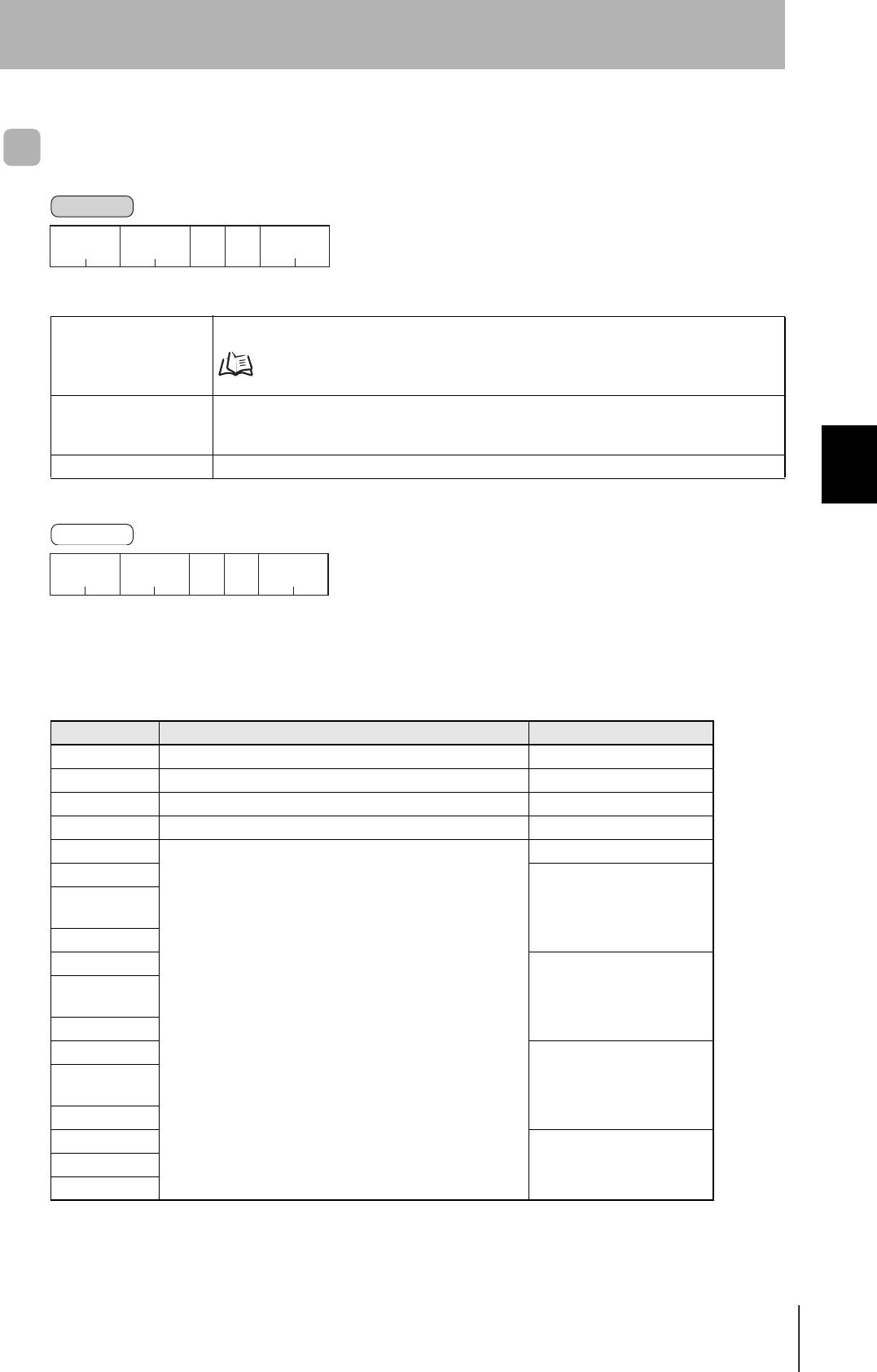
49
Electromagnetic Inductive RFID System
User's Manual
SECTION 4
Communications Commands
SECTION 4
Commands
Tag Function Designation (TF)
Sets/clears write protection for Tags.
■Setting Example
* Protection area setting range: 0004h to 007Fh
Communications
designation
Specifies the method for communicating with a Tag.
Refer to Communications Designations for details.
p.43
Process designation Specifies setting or clearing the function.
“P”: Sets protection.
“R”: Clears protection.
Antenna designation Always “1”.
Relationship between Protection Information and Protection Area
User address Description Data example
$0000 Start address of write protection area 1 05h
$0001 End address of write protection area 1 10h
$0002 Start address of write protection area 2 70h
$0003 End address of write protection area 2 75h
$0004
User area
$0005
Write protection area
1
.
.
$0010
$0011
.
.
$006F
$0070
Write protection area
2
.
.
$0075
$0076
$007F
22112
㧖CR
Command
code "TF" Proc-
ess
desig-
nation
Antenna
desig-
nation
Communica-
tions desig-
nation
Command
22112
㧖CR
Command
code "TF" Retry
flag Status
flag
End code
Response

50
SECTION 4
Communications Commands
Electromagnetic Inductive RFID System
User's Manual
SECTION 4
Commands
•No Write Protection
When write protection is not set for the Tag:
Send data: TFSAR1*[CR]
Receive data: TF0000*[CR]
•Write Protection Specified for One Location
When setting write protection for Tag memory addresses 0005h to 0010h
(single auto, hexadecimal)
Setting Protection Area Information
Send data: WTSAH100000405100510*[CR]
Receive data: WT0000*[CR]
Setting Write Protection
Send data: TFSAP1*[CR]
Receive data: TF0000*[CR]
When setting write protection for only one location, set the same data to addresses 0002h and 0003h and to addresses
0000h and 0001h.
•Write Protection Specified for Two Locations
When setting write protection for Tag memory addresses 0005h to 0010h and addresses 0070h to
0075h (single auto, hexadecimal)
Setting Protection Area Information
Send data: WTSAH100000405107075*[CR]
Receive data: WT0000*[CR]
Setting Write Protection
Send data: TFSAP1*[CR]
Receive data: TF0000*[CR]
Refer to Write Protection for details on write protection.
p.33

51
Electromagnetic Inductive RFID System
User's Manual
SECTION 4
Communications Commands
SECTION 4
Commands
ID Read (ID)
Reads the Tag’s user ID.
Example: Reading Tag User ID (Single Auto, User ID: “12345678”)
Send data: IDSAH1*[CR]
Receive data: ID000012345678*[CR]
All Tags store their own unique ID. The ID Read command can be used for very fast communications if all that is
required is to detect whether or not there is a Tag in the communications area.
Communications
designation
Specifies the method for communicating with a Tag.
Refer to Communications Designations for details.
p.43
Data designation Always “H” (hexadecimal).
Antenna designation Always “1”.
Read data User ID data read from a Tag.
00000000 to 3FFFFFFF
The leftmost 2 bits are system bits and are always 0.
22112
㧖CR
Command
code "ID" Data
desig-
na-
tion
Antenna
designa-
tion
Communica-
tions desig-
nation
Command
2211 2
㧖CR
Command
code "RD" Retry
flag Status
flag
End code
"00"
Specified number of bytes
Read data
Response
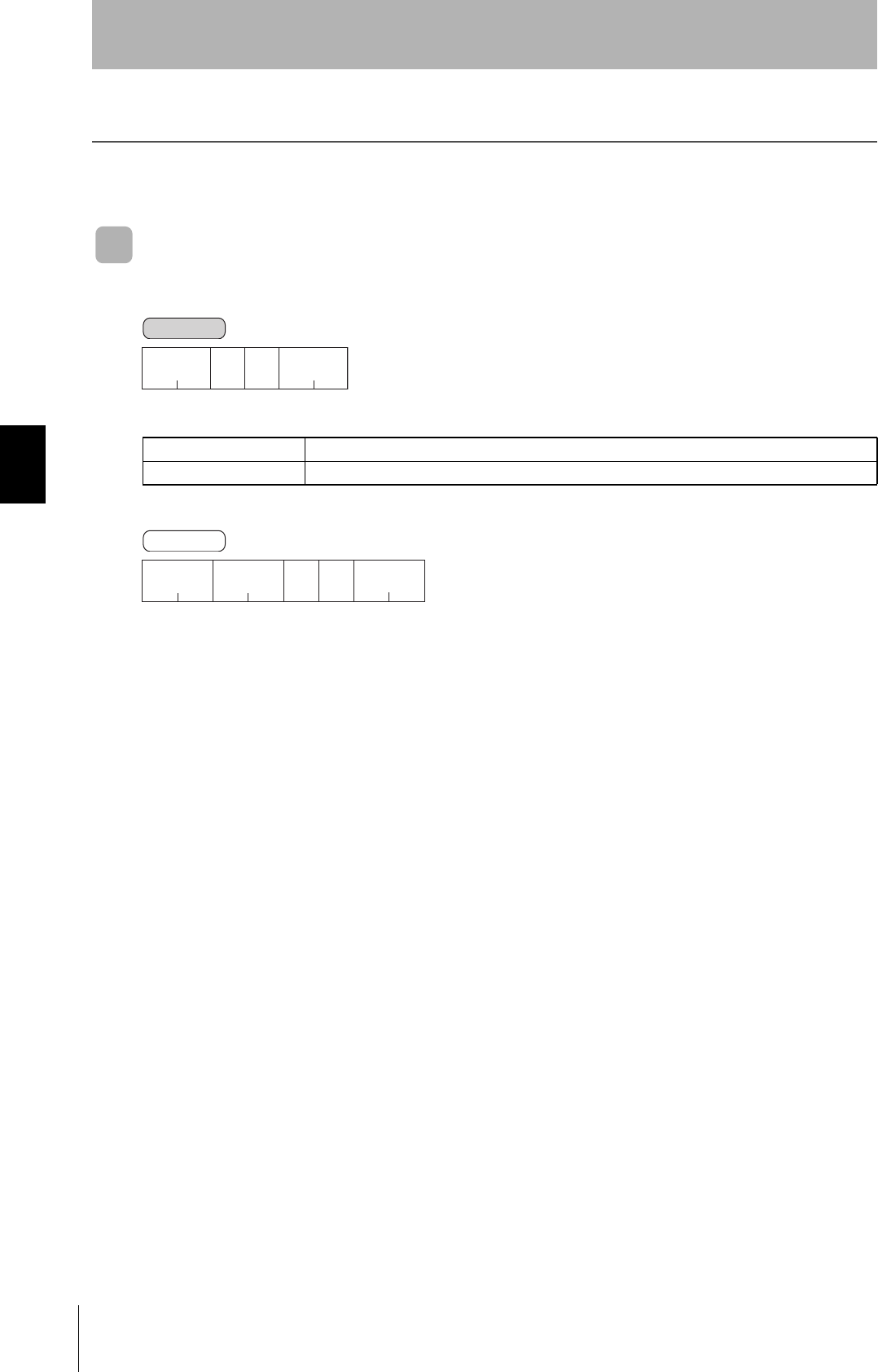
52
SECTION 4
Communications Subcommand
Electromagnetic Inductive RFID System
User's Manual
SECTION 4
Commands
Communications Subcommand
The communications subcommand is used in combination with communications commands. No
communications processing is performed with Tags when the communications subcommand is used alone.
Command Processing Abort (AA)
Aborts processing of a command being executed and returns to the command standby status. Com-
mand Processing Abort can be executed during the processing of any command.
When command processing has been aborted after a Tag is detected, the status flag will be “2”.
Example: Aborting Command Processing during Execution
Send data: AA01*[CR]
Receive data: AA0000*[CR]
Process designation Always “0”.
Antenna designation Always “1”.
2112
㧖CR
Command
code "AA" Proc-
ess
desig-
nation
Antenna
desig-
nation
Command
22112
㧖CR
Command
code "AA" Retry
flag Status
flag
End code
Response
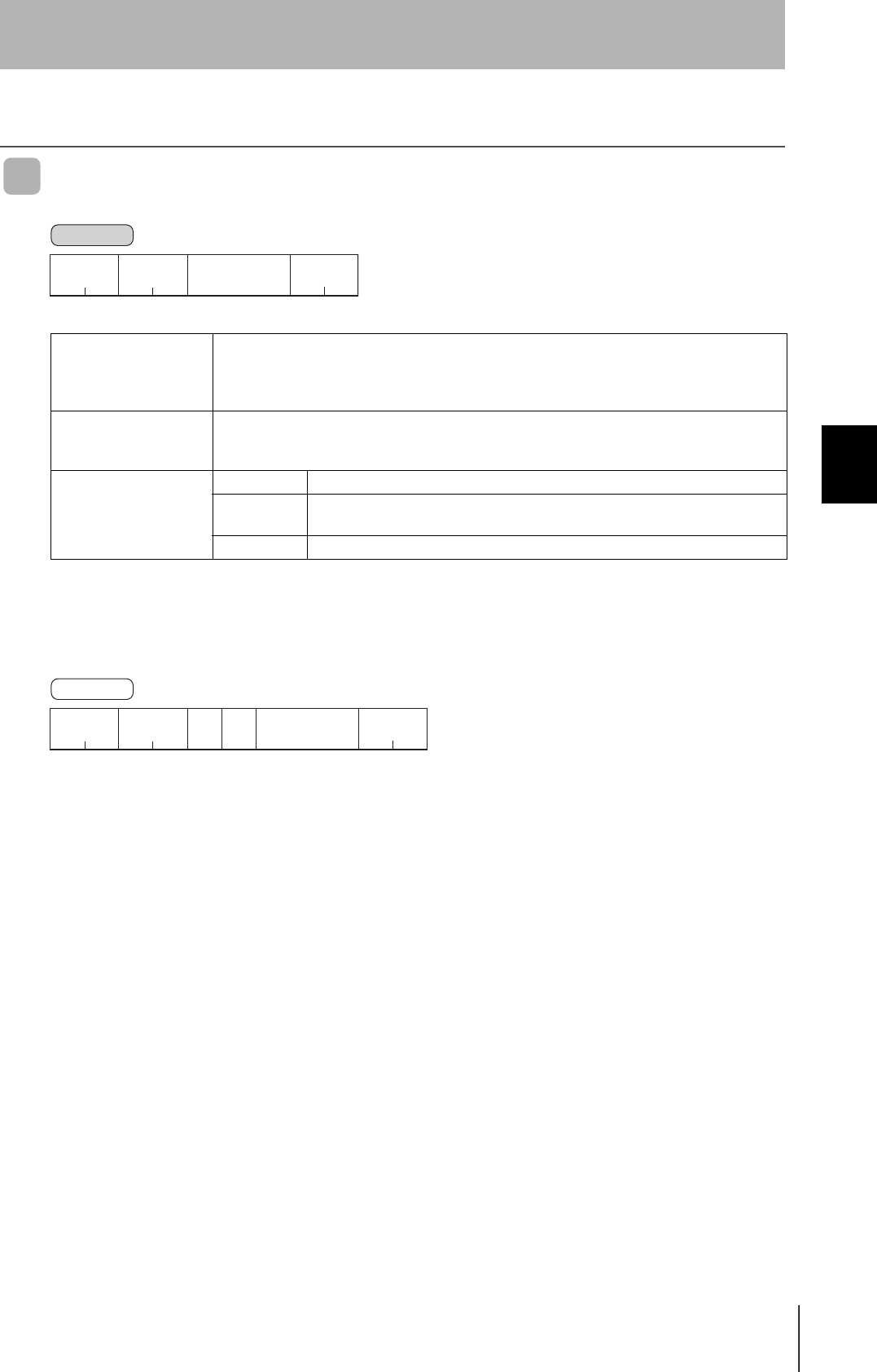
53
Electromagnetic Inductive RFID System
User's Manual
SECTION 4
Controller Control Commands
SECTION 4
Commands
Controller Control Commands
Parameter Setting (SP)
This command sets communications conditions by setting the parameters in the CF Reader/Writer.
* The parameter number for the parameter data is the number specified in the lower digit of the process
code. Set the parameter data within the setting range given for the parameter number specified in the
lower digit of the process code.
Example: Setting Character Interval Monitoring Time to 500 ms
Send data: SP010500*[CR]
Receive data: SP0000*[CR]
Process code (upper digit) Specifies the process to be performed for the parameter.
“0”: Change
“1”: Read
“9”: Initialize (default setting)
Process code (lower digit) Specifies the parameter.
“4”: Auto command abort time
“C”: Write verification
Parameter data
(only when changing the
parameter)
Parameter* Setting range
4Set two decimal digits 01 to 60 (unit: 1 s). A command error will occur if 00 is set.
Default is 10 s.
C 0: OFF, 1: ON, Default is 1 (Write varification enabled)
2 2
2
㧖CR
Command
code "SP" Parameter data
(only when
changing)
Process
code
(Upper) (Lower)
Command
2211 2
㧖CR
Command
code "SP" Retry
flag Parameter data
(only when
reading)
Status
flag
End code
Response
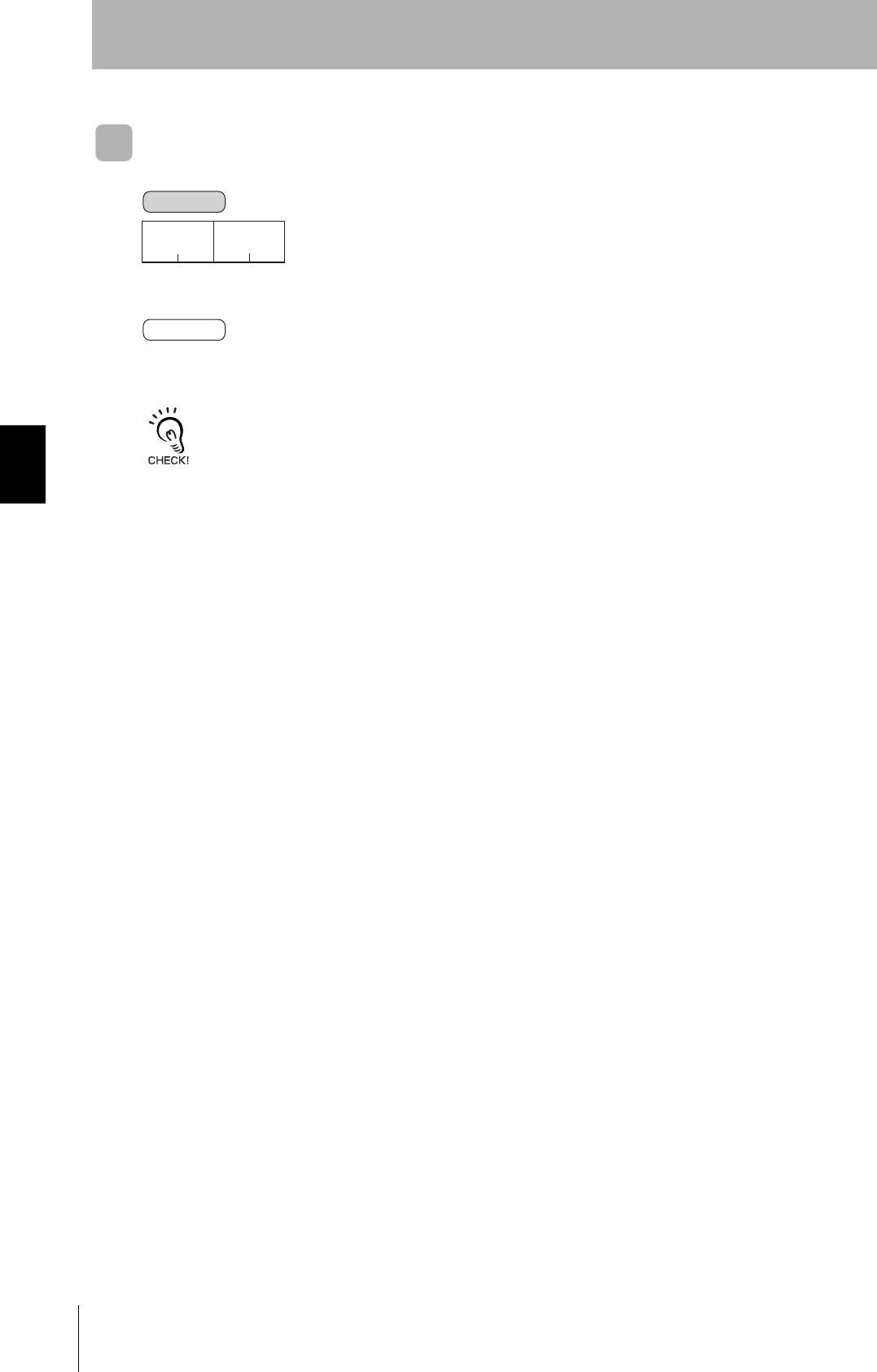
54
SECTION 4
Controller Control Commands
Electromagnetic Inductive RFID System
User's Manual
SECTION 4
Commands
Reset (XZ)
Resets the CF Reader/Writer.
No response is sent.
A response is not returned for the Reset (XZ) command. The indicator will flash green when this command is received.
Check the indicator after sending this command to confirm that it has been received.
Example: Resetting the CF Reader/Writer
Send data: XZ*[CR]
Receive data: None
22
㧖CR
Command
code "XZ"
Command
Response

55
Electromagnetic Inductive RFID System
User's Manual
SECTION 4
Host Commands
SECTION 4
Commands
Host Commands
Test (TS)
Returns the message sent by the Handy Terminal directly as the response. The Test command is used
to test communications between the CF Reader/Writer and a Handy Terminal.
Example: Sending Message Data “OMRON” from the Handy Terminal
Send data: TSOMRON*[CR]
Receive data: TS0000OMRON*[CR]
Version Information (VS)
Reads the CF Reader/Writer model information, software version, and creation date and time.
Example: Reading the CF Reader/Writer Software Version
Send data: VS*[CR]
Receive data: VS0000V670-CF01$00000000;1.00;2004/04/01*[CR]
Message data Any character string for testing communications.
22
㧖CR
Command
code "TS" Message data
Command
2211 2
㧖CR
Command
code "TS" Retry
flag Status
flag
End code Message data
Response
22
㧖CR
Command
code "VS"
Command
2211 2
㧖CR
Command
code "VS" Retry
flag Status
flag
End code Model information; software version; creation date and time
Response
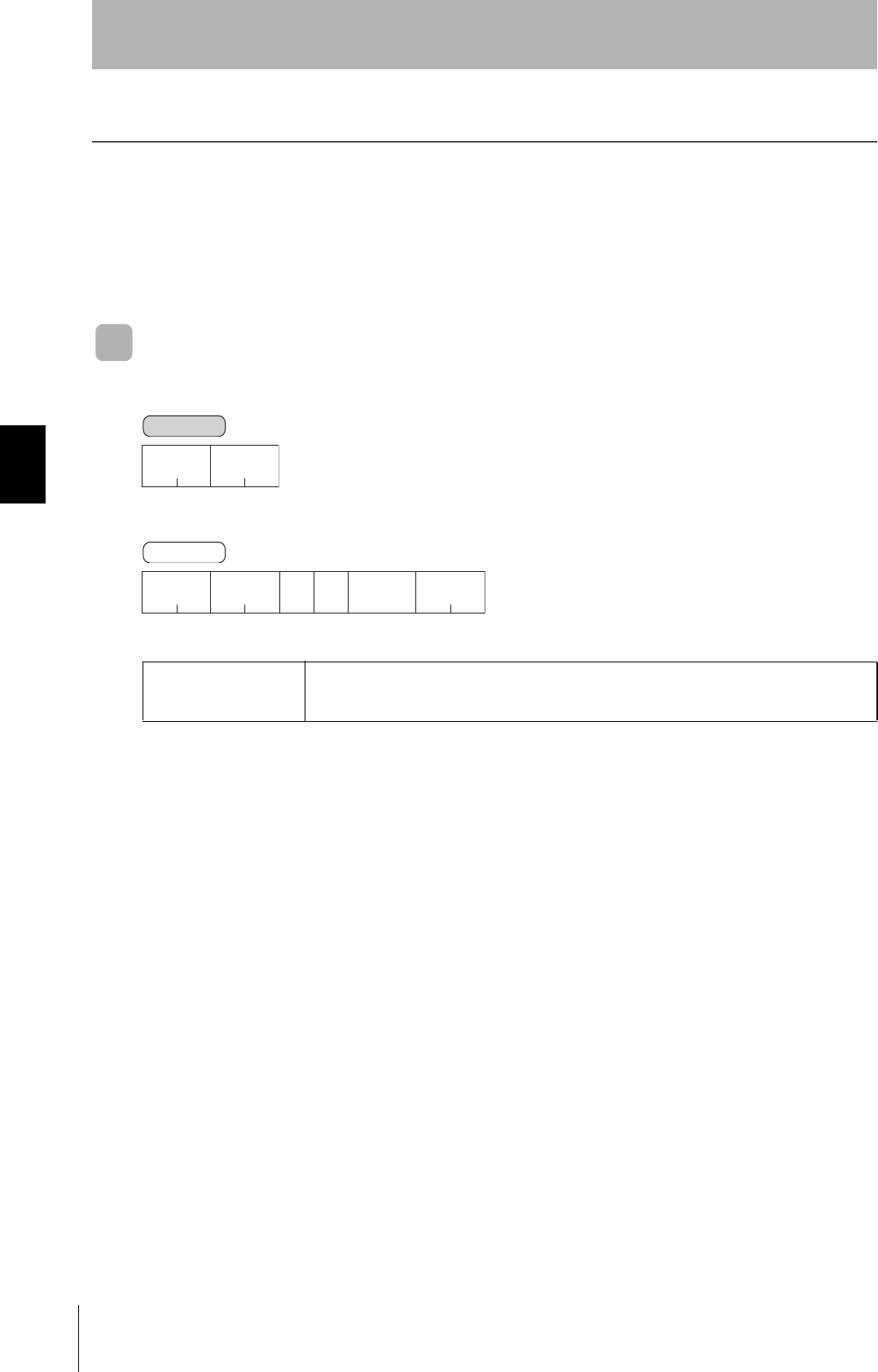
56
SECTION 4
Appraisal Commands
Electromagnetic Inductive RFID System
User's Manual
SECTION 4
Commands
Appraisal Commands
If errors are frequent during communications with Tags, one of the causes may be ambient noise. The
appraisal commands are used to investigate whether or not noise is the cause of errors. It can also be used to
check noise generation at installation sites before installing V670-series Tags or Antennas and Controllers.
Even if read results are normal, reception waveforms may exhibit interference. These commands can be used
to check for noise at the waveform level to provide more detailed information on the actual status of the
waveforms.
Noise Measurement Command (NS)
Investigates the noise level when commands are received.
Example: Investigating Ambient Noise Level
Send data: NS*[CR]
Receive data: NS00000A*[CR]
Noise evaluation result The noise level is evaluated as the maximum absolute value in the measured data.
“A”: Low noise level (0.0 V to 2.0 V); indicator will light green.
“B”: High noise level (2.0 V to 3.3 V); indicator will flash red.
22
㧖CR
Command
code "NS"
Command
221112
㧖CR
Command
code "NS" Retry
flag Status
flag
End code Result of
noise level
measure-
ment
Response
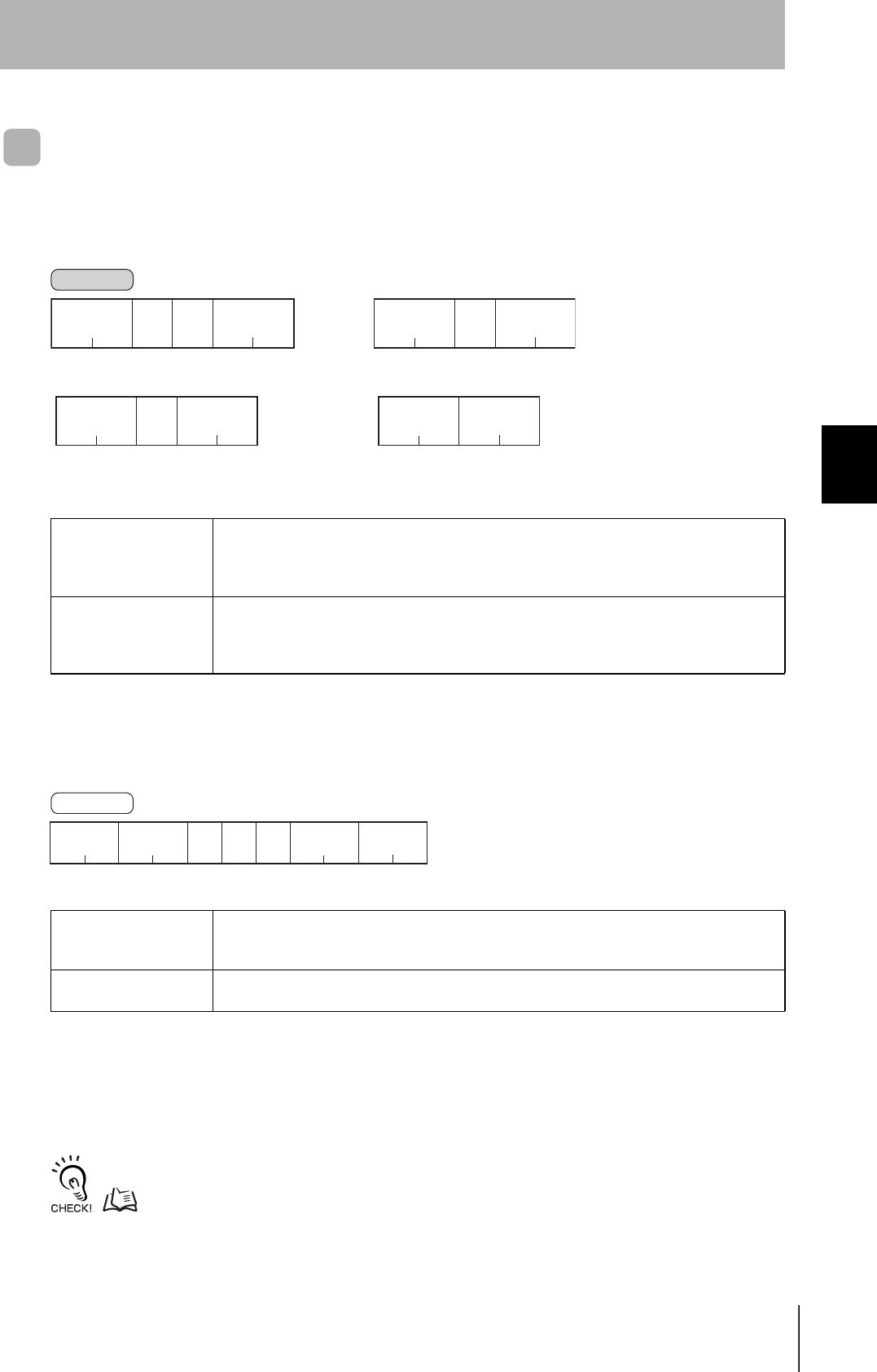
57
Electromagnetic Inductive RFID System
User's Manual
SECTION 4
Appraisal Commands
SECTION 4
Commands
Error Noise Detection Command (EN)
The Error Noise Detection command detects noise above a specified level.
When deciding where to mount Tags and Antennas, use this command to investigate where the noise
level is high.
* When both data 1 and data 2 are omitted, noise detection is performed using the previously specified
values. If they are omitted the first time this command is set after turning ON the power supply, the
default settings will be used for noise detection.
Example: Detecting Noise at 3.3 V or Greater during a Period of 5 s
Send data: EN330005*[CR]
Receive data: EN0000020*[CR]
The Error Noise Detection command can be canceled using the Command Processing Abort command (AA), because
no response is given for a set period of time.
p.52
Data 1
Error noise level
Specifies the error noise level in two decimal digits. (This setting may be omitted*).
Specification range: 00 to 33 (× 0.1 V)
Default: 2.0 V
When “00” is specified: 100%
Data 2
Measurement time
Specifies the error noise measurement time in four decimal digits. (This setting may be omitted*).
Specification range: 0000 to 0100 s
Default: 0060 s
When “0000” is specified: Noise level when command is received is returned in the response.
Judgment result The noise level is evaluated as the maximum absolute value in the measured data.
“0”: Normal; indicator will light green.
“1”: Error; indicator will flash red.
Maximum noise level Gives the maximum noise level (V) detected during the measurement period in two decimal digits.
Unit: 0.1 V
2242
㧖CR
24 2
㧖CR
Command
code "EN" Data
1 Data
2
Command
code "EN" Data
2
Command
22 2
㧖CR
22
㧖CR
Command
code "EN" Data
1
Command
code "EN"
Specifying Data 1 and Data 2 Omitting Data 1
Omitting Data 2 Omitting Data 1 and Data 2
2211 2
㧖CR
12
Command
code "EN" Retry
flag Status
flag
End code Judge-
ment
result
Maximum
noise level
Response
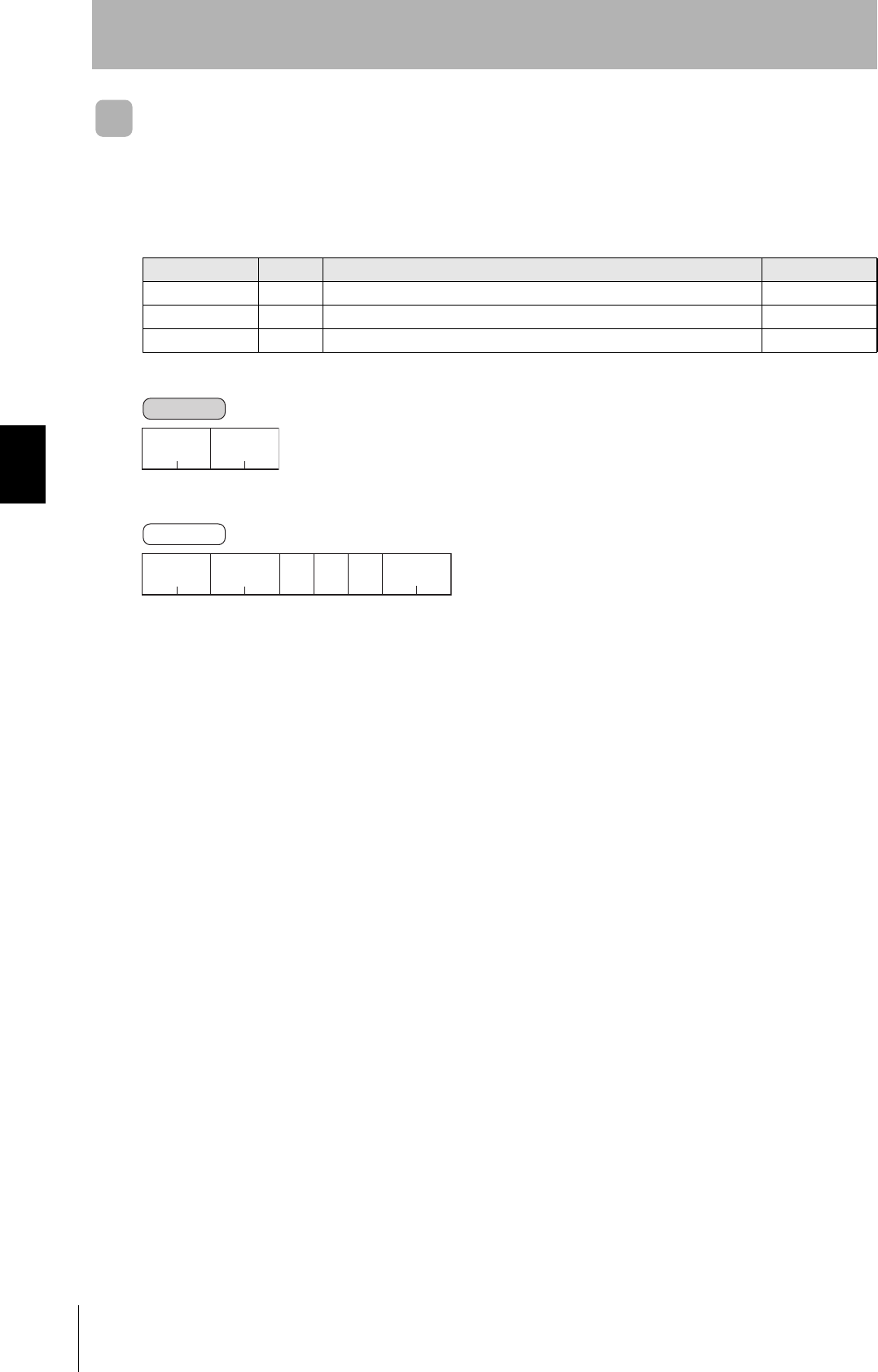
58
SECTION 4
Appraisal Commands
Electromagnetic Inductive RFID System
User's Manual
SECTION 4
Commands
Stability Evaluation Command (SF)
The Stability Evaluation command evaluates the stability of received data.
Data is read from the Tag, the received data is evaluated, and the evaluation results are returned in the
response and through the indicator. Forty bytes of data is read starting from address 0000h.
Example: Investigating Communications Stability
Send data: SF*[CR]
Receive data: SF0000A*[CR]
Evaluation Criteria
Response Meaning Evaluation criteria Indicator
A Excellent Min. 80% within distribution range Lit green.
B Good Min. 60% within distribution range Flashing green.
C No good Less than 60% within distribution range Flashing red.
2 2
㧖CR
Command
code "SF"
Command
2211 2
㧖CR
1
Command
code "SF" Retry
flag Status
flag
End code Judge-
ment
result
Response

59
Electromagnetic Inductive RFID System
User's Manual
SECTION 4
End Code List
SECTION 4
Commands
End Code List
*1 Communications between the CF Reader/Writer and the Handy Terminal are called host communi-
cation.
*2 “7E” (lock error) and “7F” (tag error) most likely Tag errors. If these errors occur no matter how many
times communications are attempted, replace the Tag.
Refer to Part Names and Functions for details on the indicator.
p.11
Type End code Name Description
Normal end 00 Normal end Command execution has ended correctly.
A command started executing normally when polling processing is specified.
Host
communications
error*1
10 Parity error A parity error has occurred in the characters in the command.
11 Framing error A framing error has occurred in the characters in the command.
12 Overrun error An overrun error has occurred in the characters in the command.
14 Format error The command format is incorrect.
The character interval exceeds the set time.
18 Frame length error A command string longer than 300 characters was received.
Tag
communications
error
70 Communications error An error occurred during communications with a Tag, and the
communications could not be completed normally.
71 Verification error The correct data could not be written to the Tag (only possible when
verification is enabled).
72 No-tag error There is no Tag in the CF Reader/Writer communications area.
7A Address designation
error
The designated processing address is not suitable, and the execution is
impossible.
7D Write protection error Data was written to a write-protected page.
7E*2 Lock error Write was specified for a locked area.
7F*2 Tag error Communications were attempted with a Tag for which communications are
not enabled (e.g., no password setting).

60
SECTION 4
End Code List
Electromagnetic Inductive RFID System
User's Manual
SECTION 4
Commands
MEMO

62
SECTION 5
Diagnosis Function
Electromagnetic Inductive RFID System
User's Manual
SECTION 5
Troubleshooting
Diagnosis Function
When errors occur with the CF Reader/Writer, the type of error can be determined through the indicator, i.e.,
by whether the indicator lights red or flashes red.
Errors
The errors detected by the diagnostic function can be classified into two types of errors. One
terminates operation (fatal errors) and the other does not terminate any operation (nonfatal errors).
■Fatal Errors
When a CPU error has occurred in the CF Reader/Writer, CPU operation is terminated and the
indicator lights red. The indicator will remain lit red until the power supply is turned OFF. Check the
information in the following table and take appropriate corrective actions before restarting operation.
If the above procedure does not correct the problem, the CF Reader/Writer may be faulty.
■Nonfatal Errors
When errors occur during communications between the CF Reader/Writer and the Handy Terminal or
between the CF Reader/Writer and Tags, the indicator lights or flashes red. The indicator will turn OFF
after lighting or flashing and the command will be recieved. Check the information in the following table
and take approrriate corrective actions before restarting operation.
If the problem cannot be solved after performing the above checks, the CF Reader/Writer may be faulty.
Indicator Status Description Error code
Lights red CPU error Turn OFF the power supply and then turn it back ON to return to initial status ---
Indicator Status Description Error code
Lights red Error in communica-
tions with Tag
Ambient noise interference
p.56 Appraisal Commands
70
Tag write life expired (replace Tag). 71
Processing address specification
p.39 Ranges for Start Address and Number of Bytes
7A
Tag write protection settings
p.49 Tag Function Designation (TF)
7D
Model or specifications of the Tags being used 7E, 7F
Settings (e.g., lock setting) of the Tags being used 7E, 7F
Tag operating environment (Tags destoyed by unanticipated usage.)
Try communicating with a different Tag. If communications are possible,
there is an error in the tag.
71, 7E, 7F
Flashes red Tag missing error Distance between CF Reader/Writer and Tag
p.75 Communications Distance Specifications
72
Tag operating environment (Tags destoyed by unanticipated usage.)
Try communicating with a different Tag. If communications are possible,
there is an error in the tag.
72
Communications
error with the Handy
Terminal
Command format
p.35 Commands
14
Handy Terminal communications specifications
p.68 Interface Specifications
---

63
Electromagnetic Inductive RFID System
User's Manual
SECTION 5
Errors and Countermeasures
SECTION 5
Troubleshooting
Errors and Countermeasures
Problems with the CF Reader/Writer are normally caused by one of the following four problems.
• Handy Terminal is faulty.
• CF Reader/Writer is faulty.
• Tag is faulty.
• Other
Repairs are required if a device is faulty.
Troubleshooting
When an error occurs, study the situation fully, determine if the error will recur and its relation to other devices,
and then check the error according to the following flowchart.
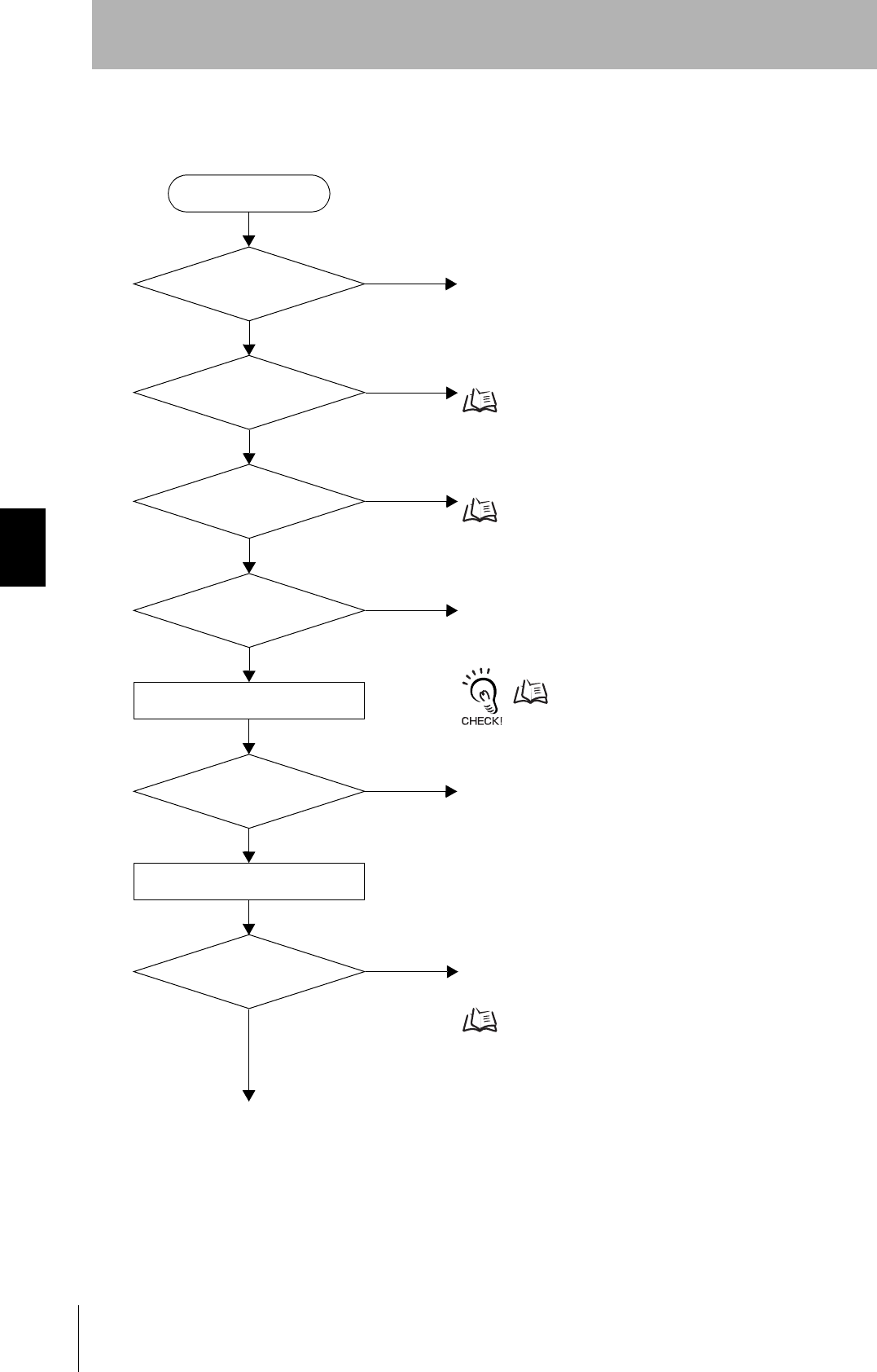
64
SECTION 5
Errors and Countermeasures
Electromagnetic Inductive RFID System
User's Manual
SECTION 5
Troubleshooting
■Operation Check Flowchart
Start
Send a test command (TS) from the
Handy Terminal.
Is the
indicator on the CF Reader/Writer
flashing green when the COM port
is opened?
Connect the CF Reader/Writer so that the indicator is on the top.
p.16
Is a recommended Handy
Terminal being used?
Is the CF
Reader/Writer connected prop-
erly to the CF card slot in the
Handy Writer?
Is the CF
Reader/Writer indicator flashing
green after the Handy Terminal
power is turned ON?
Use the Handy Terminal program to open
the COM port allocated to the CF port.
Is the Handy Terminal
power turned ON? Contact the sales representative for the Handy Terminal manufacturer.
Use a recommended Handy Terminal.
p.12
Reset the Handy Terminal and turn ON the power again.
If the indicator does not flash after several attempts, the Handy Termi-
nal CF port may be damaged.
Contact the sales representative for the Handy Terminal manufacturer.
Refer to the ??? program.
p.62
Reset the Handy Terminal and execute the program again.
If the indicator does not flash after several attempts, the Handy Ter-
minal CF port may be damaged. Contact the sales representative
for the Handy Terminal manufacturer.
Is the response normal? Check the communications format.
The default settings for the CF Reader/Writer are as follows:
38,400 bps baud rate, 8 data bits, even parity, 1 stop bit.
p.68
YES
N
YES
YES
YES
YES
YES
NO
NO
NO
NO
NO
*1
NO
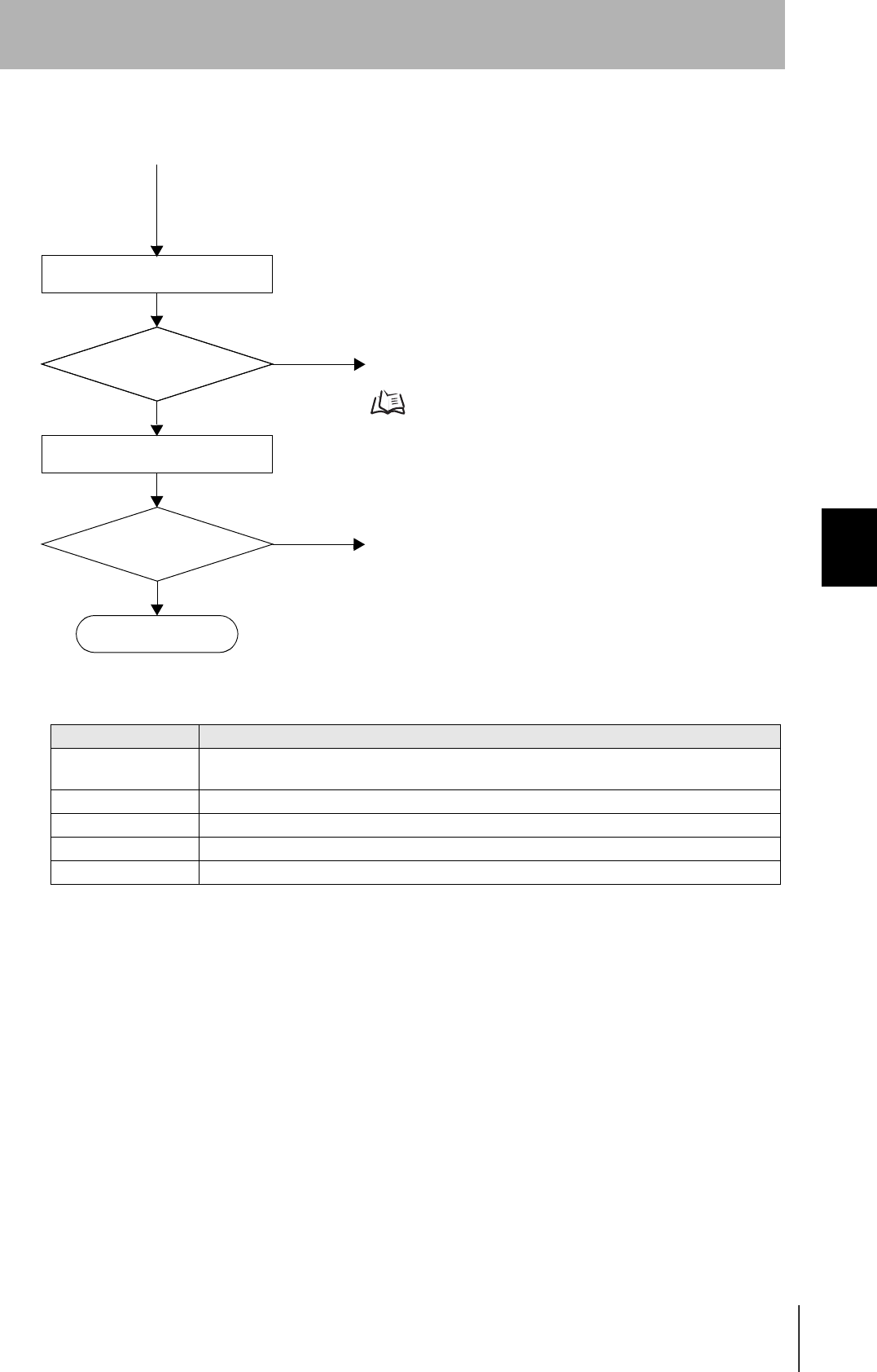
65
Electromagnetic Inductive RFID System
User's Manual
SECTION 5
Errors and Countermeasures
SECTION 5
Troubleshooting
•Check Table 1
Check point Corrective action
Distance to CF Reader/
Writer
Bring the CF Reader/Writer closer to the Tag so that it is within the communications range.
Tag write protection Release the Tag write protection settings.
Ambient metal Remove metal objects from near the Tag or change the mounting location of the Tag.
Noise Measure the noise level and take appropriate noise countermeasures.
Tags Communicate with the Tag with a different device to see if the Tag is functioning properly.
Normal end
Are communications
with Tags OK?
Is the
indicator on the CF Reader/
Writer flashing green?
Send Read command (RD) from the
Handy Terminal.
The command format is incorrect.
Check the format of the Read command
p.44
Follow Check Table 1.
YES
YES
YES
NO
NO
Bring the CF Reader/Writer closer
to the Tag.
*1

66
SECTION 5
Errors and Countermeasures
Electromagnetic Inductive RFID System
User's Manual
SECTION 5
Troubleshooting
Error Tables
■Host CommunicationsErrors
Host communications errors are errors in communications between the CF Reader/Writer and the
Handy Terminal. The indicator will flash red when a host communications error occurs.
Refer to Errors for corrective actions for the above errors.
p.62
■Tag Communications Errors
Tag errors are errors in communications between the CF Reader/Writer and a Tag. The indicator will
flash red when a “Tag missing” tag error occurs and will light red when any other tag error occurs.
Refer to Errors for corrective actions for the above errors.
p.62
Error code Name Description
10 Parity error A parity error has occurred in characters in the command.
11 Framing error A framing error has occurred in characters in the command.
12 Overrun error An overrun error has occurred in characters in the command.
14 Format error The command format is incorrect.
The character interval exceeded the set time.
18 Frame length error A command string longer than 300 characters was received.
Error code Name Description
70 Communications error An error occurred during communications with a Tag, and the communications
could not be completed normally.
71 Verification error The correct data could not be written to the Tag (possible only when verification is
enabled).
72 No-tag error There is no Tag in the CF Reader/Writer communications area.
7A Address designation
error
The designated processing address is not suitable, and the execution is impossible.
7D Write protection error Data was written to a write-protected page.
7E Lock error Write was specified to a locked area.
7F Tag error Communications were attempted with a Tag for which communications are not
enabled (e.g., no password setting).

SECTION 6
Appendices
67
Electromagnetic Inductive RFID System
User's Manual
SECTION 6
Appendices
Specifications and Dimensions 68
CF Reader/Writer 68
Tags 70
Protective Covers 73
Communications Distance Specifications 75
Characteristics Data Based on Operating Conditions 79
Mutual Interference between Tags 79
Influence of Metal behind Tags (Reference) 80
Chemical Resistance of Tags 82
Memory Map 83
Maintenance and Inspection 84
Table of JIS8 Unit Code (ASCII) 85
Degree of Protection 86
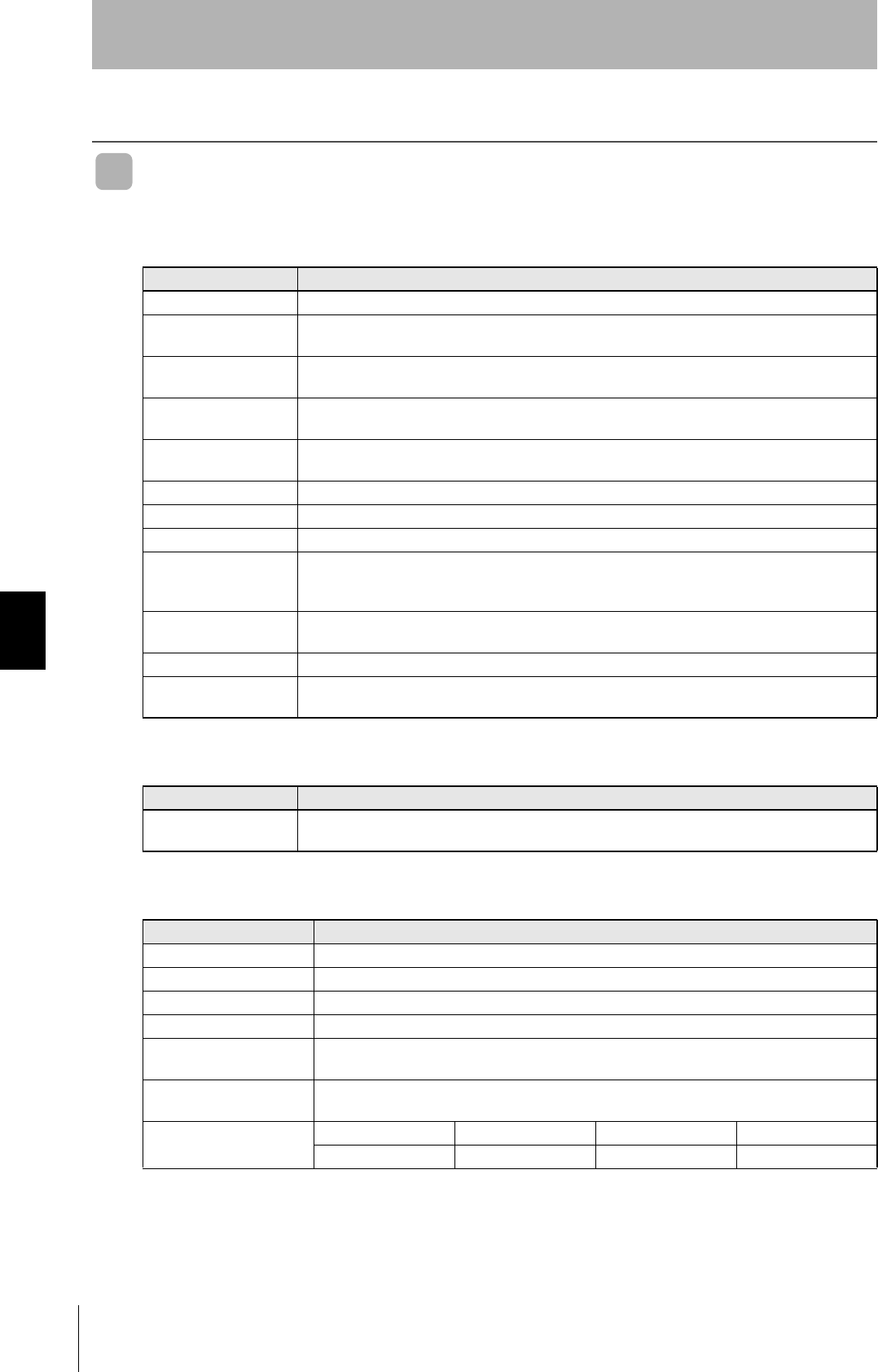
68
SECTION 6
Specifications and Dimensions
Electromagnetic Inductive RFID System
User's Manual
SECTION 6
Appendices
Specifications and Dimensions
CF Reader/Writer
■General Specifications
■Performance Specifications
■Interface Specifications
■Electrical Interface Specifications
The electrical specifications for the interface conform to the CF Card specification: Compact Flash
Specification Revision 2.0.
Item Specifications
Power supply voltage 3.3 V ±5%, 5.0 V ±5%
Ambient operating
temperature
0 to 40°C
Ambient operating
humidity
35% to 85% (with no condensation)
Ambient storage
temperature
−25 to 65°C
Ambient storage
humidity
35% to 85% (with no condensation)
Weight Approx. 28 g
Current consumption 200 mA max. (power supply voltage 3.3 V)
Material ABS (black), SUS
Vibration resistance 1 to 150 Hz, single amplitude 0.1 mm, acceleration 15 m/s2
Performed 10 sweeps for 8 minutes each in upward, downward, right, left, forward, and backward
directions along 3 axes.
Shock resistance Imposed impact of 150 m/s2 3 times each in upward, downward, left, right, forward, and backward
directions.
Insulation resistance 20 MΩ min. (at 100 VDC) between connector terminals and case
Dielectric strength 1,000 VAC (50/60 Hz, 1 min)
Impressed between connector terminals and case, leakage current: 1 mA max.
Item Specifications
Communications func-
tion
Single, repeat, and write protection functions
Memory check function, noise measurement function, communications stability evaluation function
Item Description
Connector CF Card connector: Type II
Communications method 1:1
Synchronization method Start-stop synchronization
Baud rate 38,400 bps
Communications control
protocol
1:1
Communications control
method
CR control (Character control not supported.)
Character format Start bits Data bits Parity Stop bits
18Even1

SECTION 6
Specifications and Dimensions
SECTION 6
Appendices
69
Electromagnetic Inductive RFID System
User's Manual
■Dimensions
Two, 2.5 dia.
37.3
42.8
(90.1)
(46.3) 43.8
7
5
22
45°
(Unit: mm)
34.1
37

70
SECTION 6
Specifications and Dimensions
Electromagnetic Inductive RFID System
User's Manual
SECTION 6
Appendices
Tags
■Specifications
* The number of times accessed refers to the total number of read and write communications.
■Dimensions
•V670-D13F03
Item Description
Model V670-D13F01 V670-D13F01H V670-D13F03
Memory capacity 128 bytes
Memory type FeRAM (non-volatile ferroelectric memory)
Memory life No. of times accessed (See note.): 1 billion
Data holding time 10 years (after access using write or read commands)
Ambient operating
temperature −10 to 70°C
Ambient storage
temperature −10 to 70°C
Ambient operating
humidity 35% to 95% 35% to 85%
Enclosure rating IP67 (IEC60529 standard)
Vibration resistance 10 to 2,000 Hz, double amplitude 0.2 mm, acceleration 150 m/s2
Performed 10 sweeps for 15 minutes in upward, downward, left, right, forward, and backward directions.
Shock resistance 500 m/s2 3 times each in upwards, downwards, left, right, forwards, and backwards directions, i.e., 18
times in total
Material PPS/epoxy resin filling material ABS/epoxy resin filling
Mass Approx. 1 g Approx. 1 g Approx. 6 g
Communications
distance 0 to 3 mm 0 to 3 mm 0 to 8 mm
10.2 8
5.2
13.2
16 Two, 3.5 dia.
16
16
1
40+0.1
−0.5
40+0.1
−0.5
8
13.2
5.2
8
0.2
2
4.
Case material ABS resin
Filling material Epoxy resin
(Unit: mm)
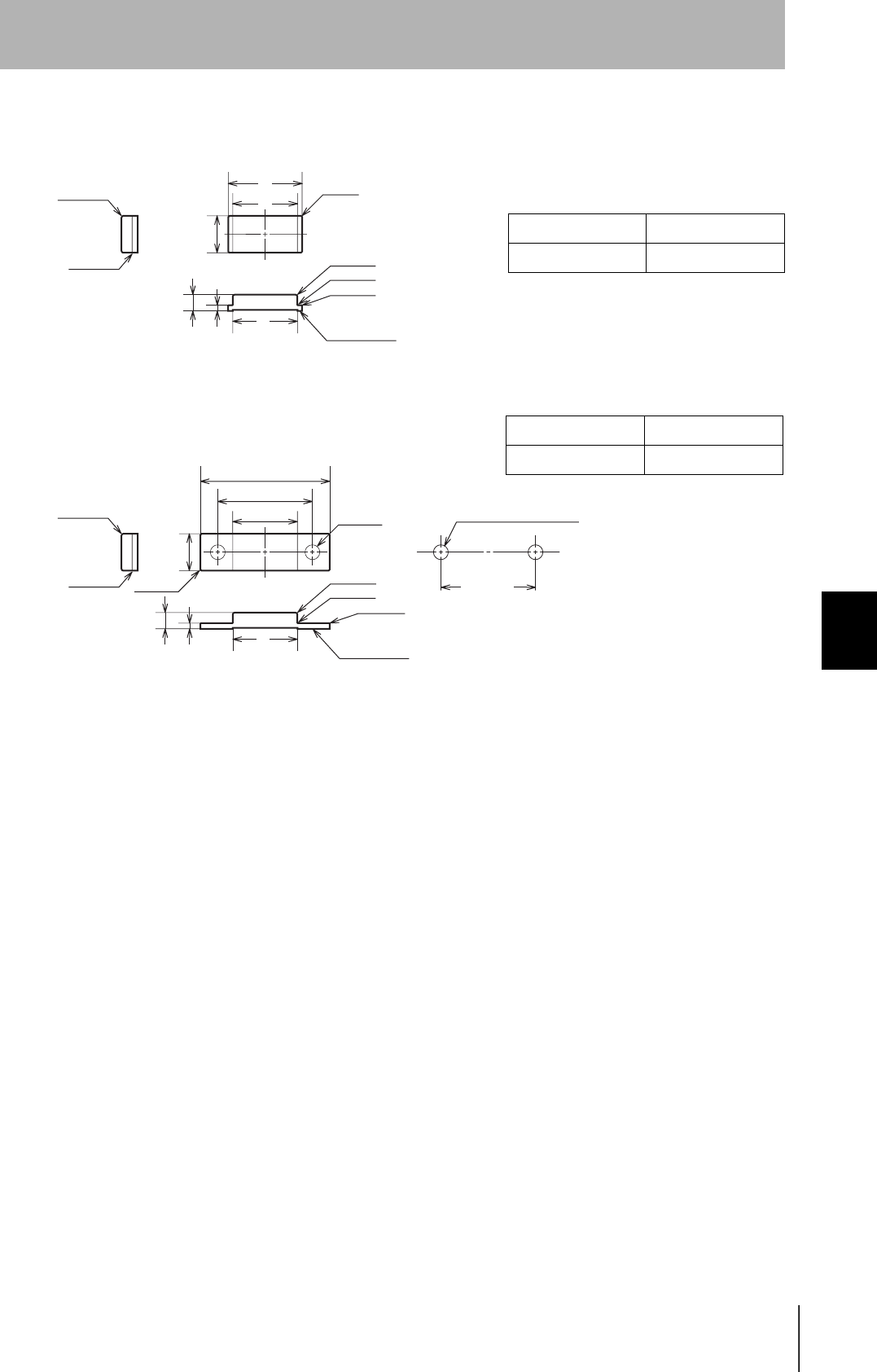
SECTION 6
Specifications and Dimensions
SECTION 6
Appendices
71
Electromagnetic Inductive RFID System
User's Manual
•V600-D13F01
•V600-D13F01H
Tw o, R 0 . 8
Tw o, R 0 . 2
1
14
8
Four, R0.5
3.5
1.2 1
Tw o, R 0 . 8
Tw o, R 0 . 2
Tw o, R 0 . 2
Reference
plane
16
Case material PPS resin
Filling material Epoxy resin
(Unit: mm)
Two, R0.2
Tw o,
3.5
1.2 14
Two, R0.8
Tw o, R 0 . 2
Reference
plane
14
20.5
8
Two, R0.2
Two, 3.2 dia.
Four,
R0.5
Two, 3.2 dia. M3 screw holes
Standard mounting holes
20.5±0.1
Mounting Hole Dimensions
(Unit: mm)
Case material PPS resin
Filling material Epoxy resin
28
Tw o, R 0 . 8
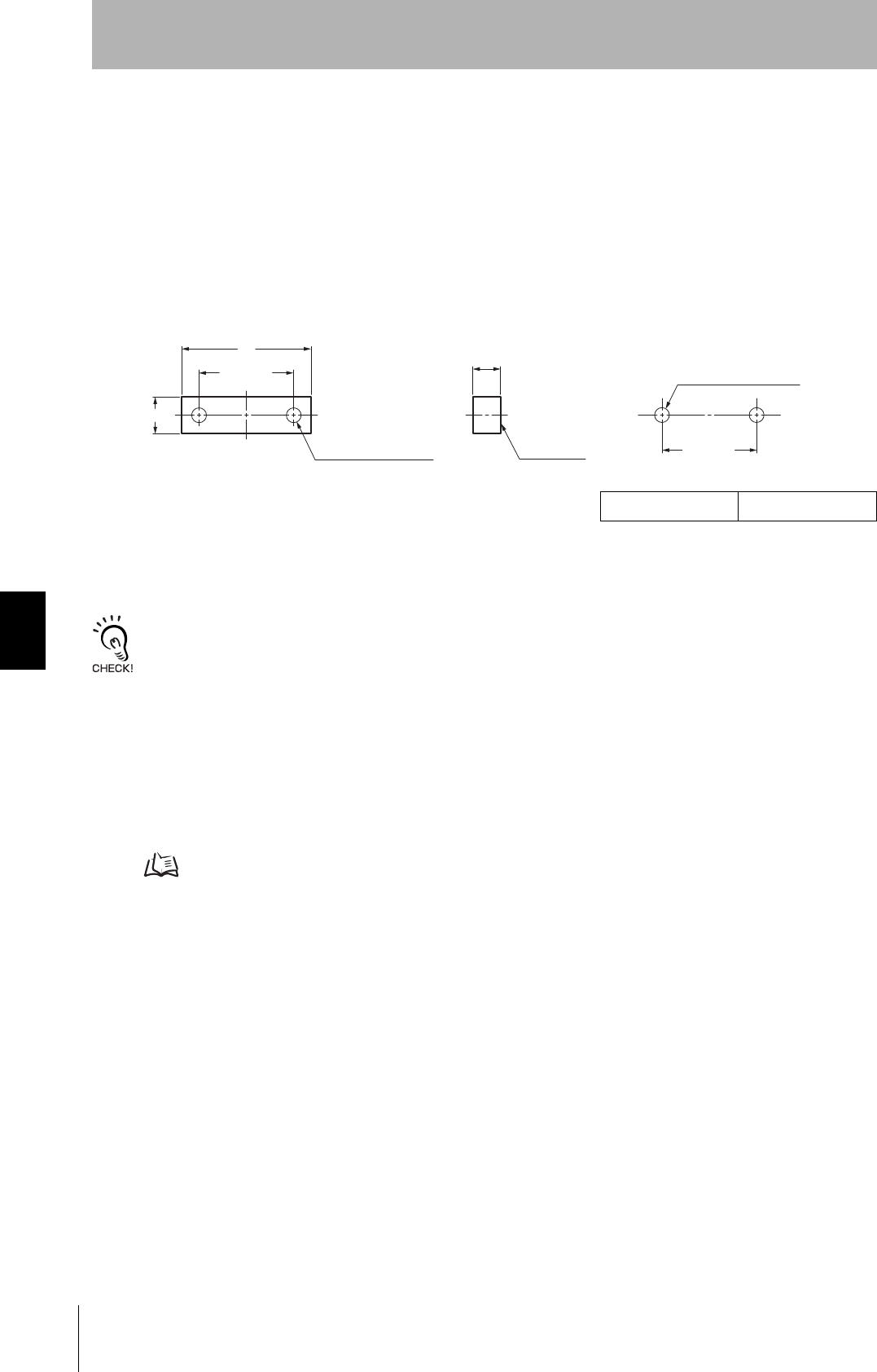
72
SECTION 6
Specifications and Dimensions
Electromagnetic Inductive RFID System
User's Manual
SECTION 6
Appendices
■V670-A81 Attachment for V670-D13F01H Tag
The communications range of a Tag will be reduced when Tags are attached to metal objects. The
V670-A81 Attachment is specifically designed for V670-D13F01H Tags. When combined with this
Attachment, V670-D13F01H Tags retain their original communications range even when installed on
metal objects.
Target Tag model: V670-D13F01H
•Dimensions
•Mounting Method
Place the attachment on the reference plane of the Tag and adjust its position until the mounting holes
are aligned. Secure it with M3 screws.
Tighten the M3 screws to a torque of 5 N·m max.
•General Specifications
Conforms to Tag specifications.
•Effect of Metal behind Tags
Use of this Attachment increases the distance between the Tag and the metal surface to 6 mm. Refer
to Influence of Metal behind Tags (Reference) before using the Attachment.
p.80
Two, 3.2 dia. M3 screw holes Reference plane
6
8
20.5±0.1
28
(Unit: mm)
Two, 3.2 dia. M3
Standard mounting holes
20.5±0.1
Mounting Hole Dimensions
Material PPS resin

SECTION 6
Specifications and Dimensions
SECTION 6
Appendices
73
Electromagnetic Inductive RFID System
User's Manual
Protective Covers
■Dimensions
•V670-A75SY8046 (for Symbol Technology Handy Terminals)
Two, (3 x 5) oblong holes
SUS304CP T1.2
SUS304 4 dia., inter-
nal diameter 2.4 dia.
60.4
53.4
13.6
Square
holes
6
6
60
24
28
42
49
(36)
72
47
34
720
60
(44)
16
Two, 2.2 dia.
40
45°
16
55
4 SUS304 dia., inter-
nal diameter 2.4 dia.
Accessories: Mounting screws, #4-40: 2 screws
Mounting screws, #2-56: 2 screws
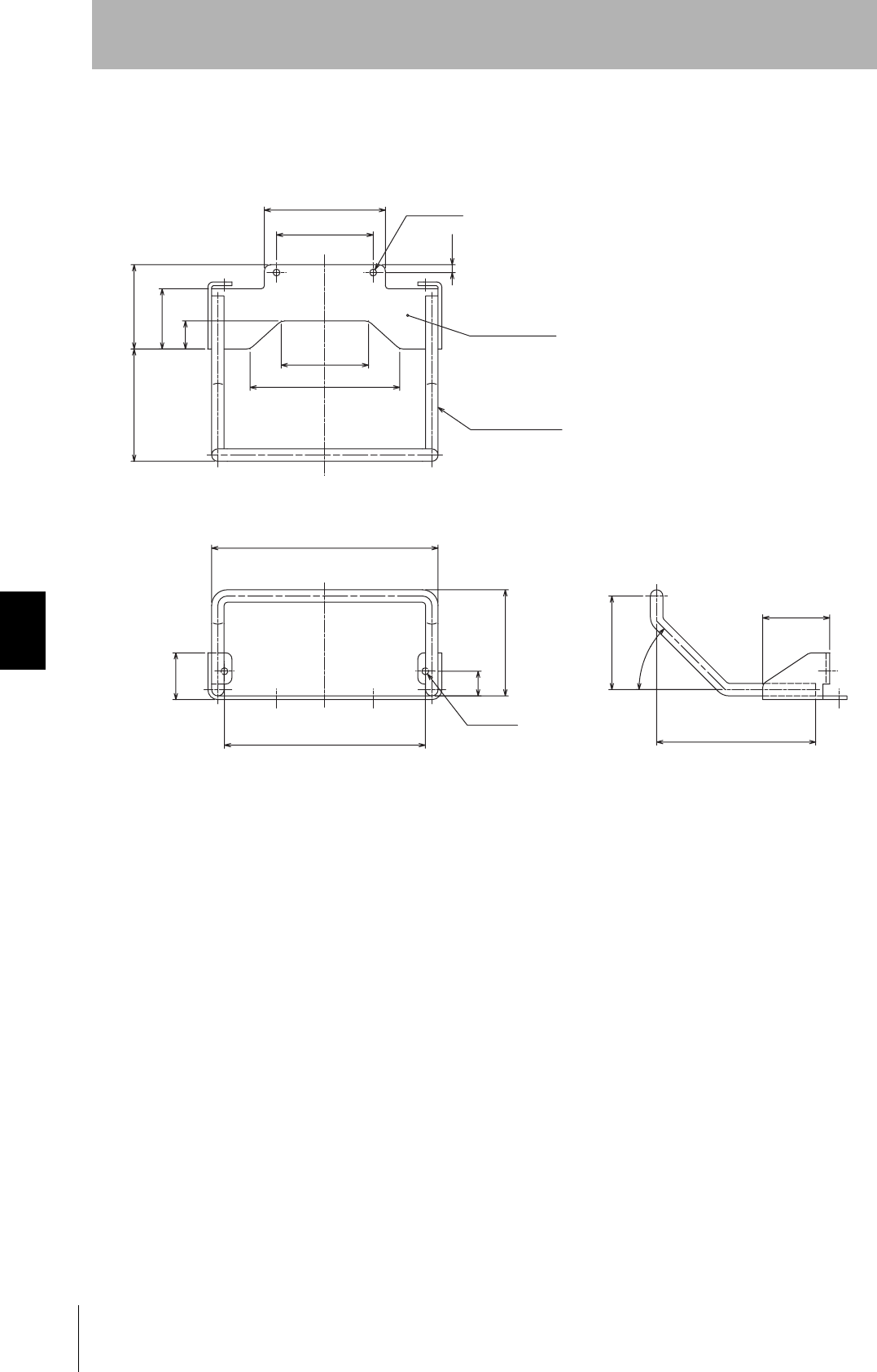
74
SECTION 6
Specifications and Dimensions
Electromagnetic Inductive RFID System
User's Manual
SECTION 6
Appendices
•V670-A75SH155S (for SHARP Handy Terminals)
Two, 2.2 dia.
SUS304CP T1.2
SUS304WPB 4 dia.
38.8
31
48
9
19.3
27
36
72.6
15
64.4 (hole pitch)
34
7.9
Two, 2.2 dia.
30
45°
51
21.5
28
2.5
Two, 2.2 dia.
Accessories: Mounting screws (M2) 4 screws

SECTION 6
Specifications and Dimensions
SECTION 6
Appendices
75
Electromagnetic Inductive RFID System
User's Manual
Communications Distance Specifications
The communications distance depends on the mounting conditions. Carefully check the conditions
listed here.
■Maximum Communications Distances
■Measurement Conditions
•V670-D13F03
•V670-D13F01/V670-D13F01H
Tag model Communications distance
V670-D13F03 0 to 8mm
V670-D13F01 0 to 3 mm
V670-D13F01H 0 to 3 mm
Tag
CF Reader/Writer
Non-metal
Communica-
tions distance
Non-metal
Communica-
tions distance
Ta g
CF Reader/Writer
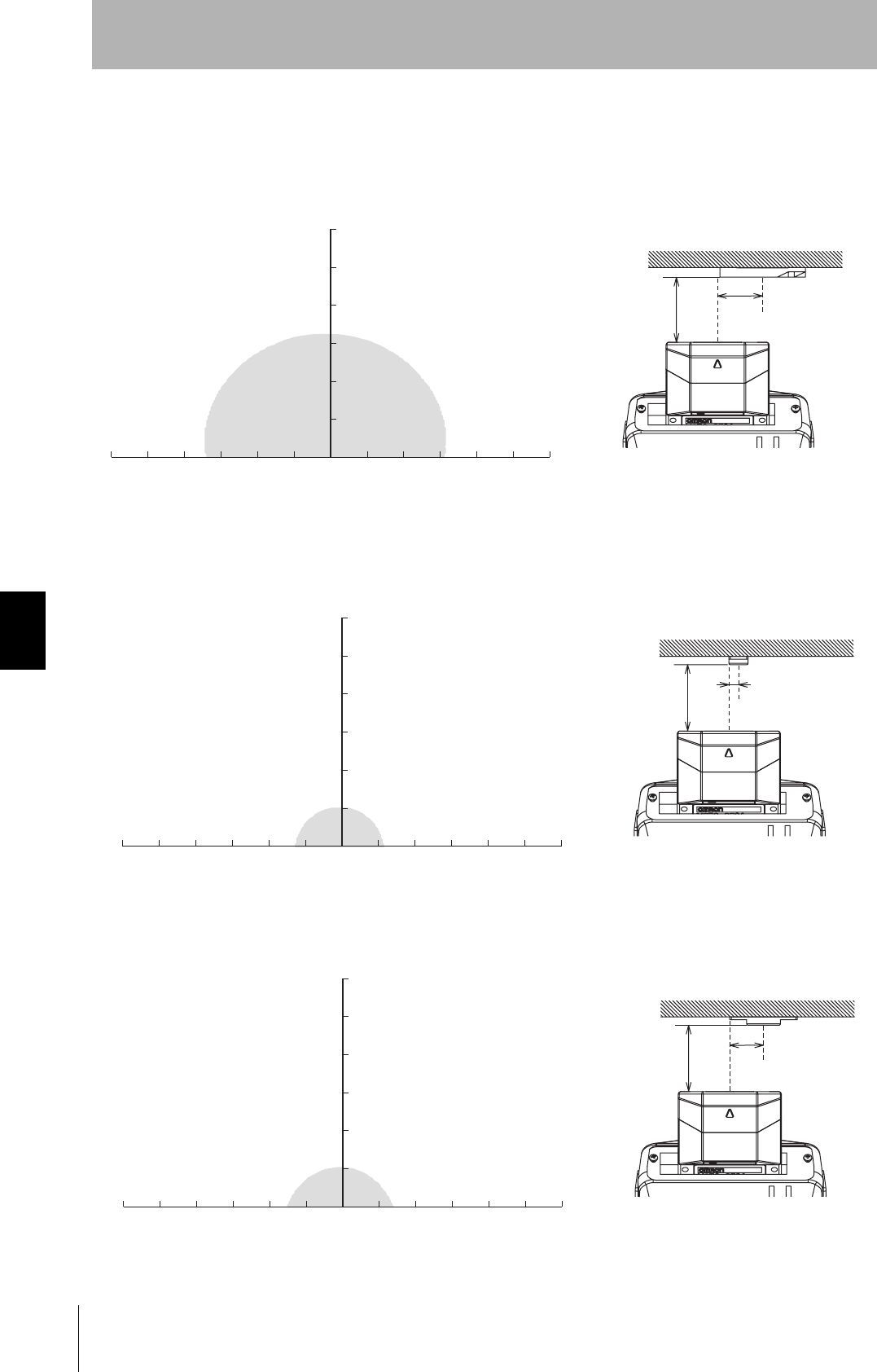
76
SECTION 6
Specifications and Dimensions
Electromagnetic Inductive RFID System
User's Manual
SECTION 6
Appendices
■Communications Area (Reference)
•V670-D13F03
•V670-D13F01/V670-D13F01H
Tag Attached Perpendicular to Passing Direction (X Direction) (Example)
Tag Attached Horizontally in Relation to Passing Direction (X Direction) (Example)
㪄㪉㪌 㪄㪉㪇㪄㪊㪇 㪄㪈㪇 㪄㪌㪄㪈㪌 㪌 㪈㪇㪇㪉㪇㪉㪌㪈㪌 㪊㪇
㪌
㪊㪇
㪉㪌
㪉㪇
㪈㪌
㪈㪇
Distance in x-axis direction (mm)
Distance in y-axis direction (mm)
Nonmetal
Y (mm) X (mm)
㪄㪉㪌 㪄㪉㪇㪄㪊㪇 㪄㪈㪇 㪄㪌㪄㪈㪌 㪌 㪈㪇㪇㪉㪇㪉㪌㪈㪌 㪊㪇
㪌
㪊㪇
㪉㪌
㪉㪇
㪈㪌
㪈㪇
Distance in x-axis direction (mm)
Distance in y-axis direction (mm)
Y (mm) X (mm))
Nonmetal
㪄㪉㪌 㪄㪉㪇㪄㪊㪇 㪄㪈㪇 㪄㪌㪄㪈㪌 㪌 㪈㪇㪇㪉㪇㪉㪌㪈㪌 㪊㪇
㪌
㪊㪇
㪉㪌
㪉㪇
㪈㪌
㪈㪇
Distance in x-axis direction (mm)
Distance in y-axis direction (mm)
Y (mm) X (mm)
Nonmetal
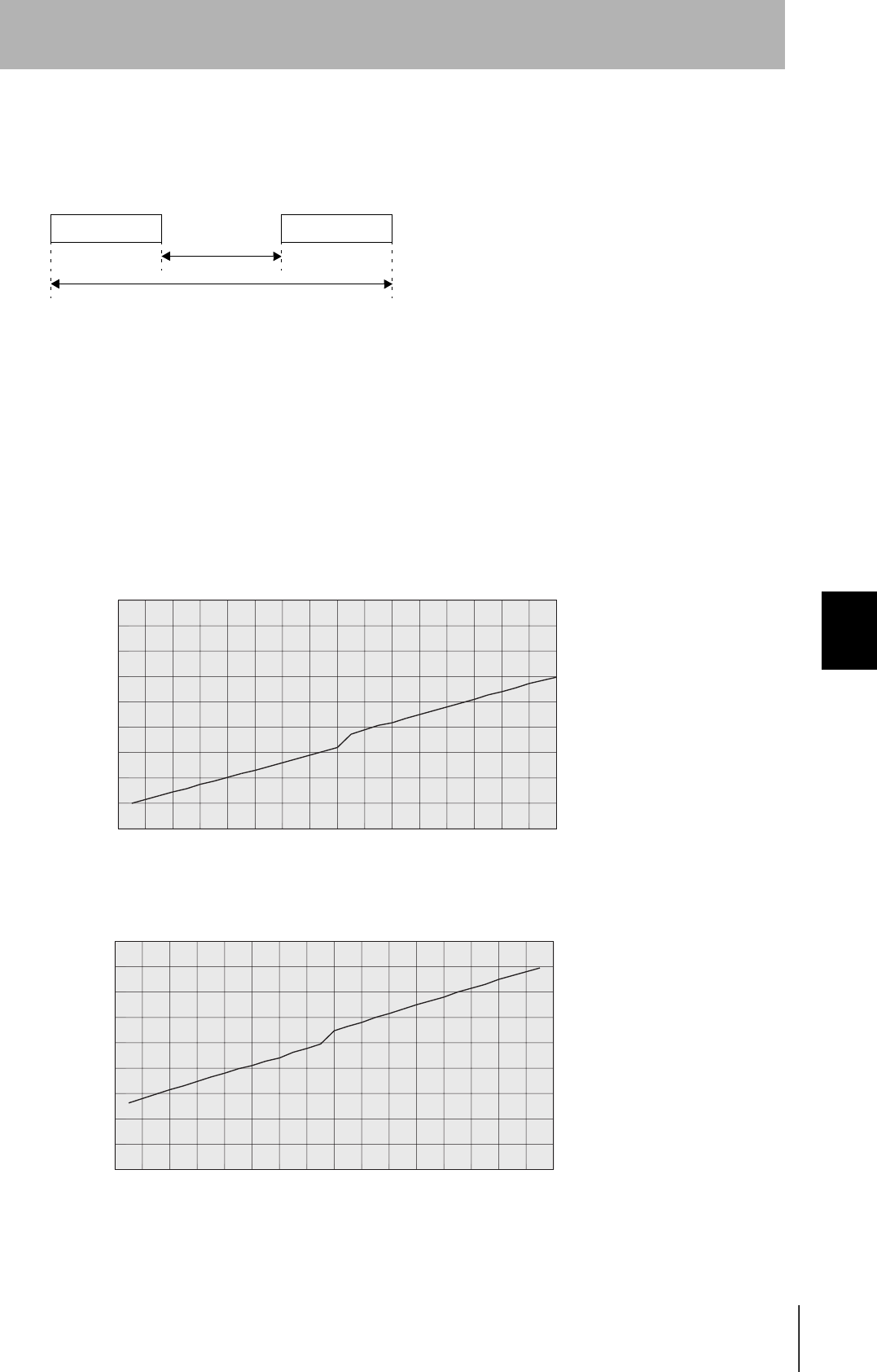
SECTION 6
Specifications and Dimensions
SECTION 6
Appendices
77
Electromagnetic Inductive RFID System
User's Manual
■Operation Time (Reference)
Operation time includes the TAT (Turn Around Time) and communications time.
The TAT is the total processing time required to operate the CF Reader/Writer, from the viewpoint of
the Handy Terminal. The communications time is the time required for communications between the
CF Reader/Writer and a Tag, and does not include communications with the host device.
•Communications Time
The communications time is the time required for communications between CF Reader/Writers and a
Tag. The time depends on the amount of data to be read or written. Refer to the following charts for the
communications time.
Command Response
Communications
time
TAT
81624040485632 72 80 8864 10411212096 128
240
220
200
180
160
140
120
100
80
60
No. of processed data bytes
Communications time (ms)
• Read
81624040485632 72 80 8864 10411212096 128
240
220
200
180
160
140
120
100
80
60
No. of processed data bytes
Communications time (ms)
• Write (with Verification)

78
SECTION 6
Specifications and Dimensions
Electromagnetic Inductive RFID System
User's Manual
SECTION 6
Appendices
Read and write communications with Tags is performed in 4-byte units. This means that the communi-
cations time can be minimized by specifying the address and number of bytes so that the write start
address is a multiple of 4.
Example: If 4 bytes of data is to be written from address 0001h, change the address to 0000h.
If the system configuration is such that the address cannot be changed like this, the times on the fol-
lowing table must be added to the communications time.
•TAT
The TAT is the time from the start of command transmission by the host device to the end of response
reception by the Handy Terminal. TAT can be calculated from the communications time and the number
of command/response characters. The formula is shown below.
* The transmission time depends on the number of bits per character and the communications condi-
tions (baud rate, data length, parity, and stop bits).
This formula applies when there is no interval between Handy Terminal command characters, i.e.,
when characters are continually transmitted.
If the number of command characters is A, the number of response characters is B, the baud rate is
38,400 bps, the data length is 8 bits, the parity is even, and there is 1stop bit, the following formula can
be used.
The above formula finds the time when processing is started (command transmitted) with the Tag inside the communications
area of the CF Reader/Writer. The time depends on the communications mode and the Tag status.
When write protection is used +2.9 ms
When the start address is not a multiple of 4 +2.9 ms
When the end address (start address + number of addresses) is not a multiple of 4 +2.9 ms
TAT = Command transmission time + Communications time + Response transmission time
Transmission time =
Bits per character
Baud rate (bps)
TAT = 11 × (A + B)
38400 + communications time
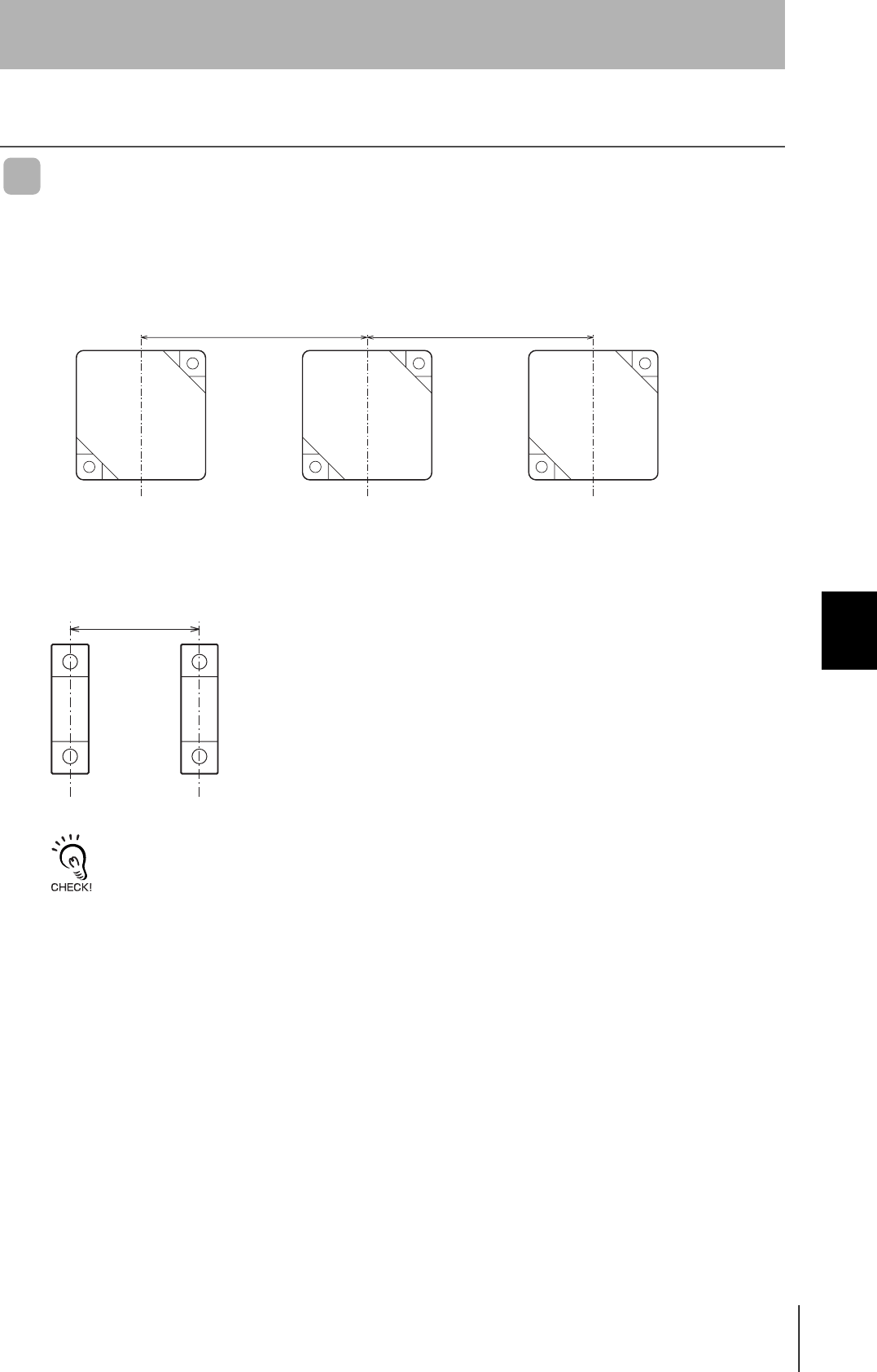
SECTION 6
Characteristics Data Based on Operating Conditions
SECTION 6
Appendices
79
Electromagnetic Inductive RFID System
User's Manual
Characteristics Data Based on Operating Conditions
Mutual Interference between Tags
When using multiple Tags, maintain the distances between Tags shown below to prevent malfunction
due to mutual interference.
•V670-D13F03
■V670-D13F01(H)
Using the above information as reference, carry out preliminary tests or take other appropriate measures to ensure
proper installation.
70 mm min. 70 mm min.
16 mm

80
SECTION 6
Characteristics Data Based on Operating Conditions
Electromagnetic Inductive RFID System
User's Manual
SECTION 6
Appendices
Influence of Metal behind Tags (Reference)
Take into consideration the influence of metal behind Tags when installing them.
The communications range deteriorates if there is any metal material behind the Tag. The following
graphs show the deterioration in the communications distances depending on the distance between
the Tag and the metal behind the Tag (same size as the Antenna).
■V670-D13F01H
•Metal: Aluminum
•Metal: Iron
㪈㪇㪇
㪐㪇
㪏㪇
㪎㪇
㪍㪇
㪌㪇
㪋㪇
㪊㪇
㪉㪇
㪈㪇
㪉㪋㪍㪇㪈㪇㪈㪉㪈㪋㪏㪈㪏㪉㪇㪈㪍 㪉㪋 㪉㪍 㪉㪏㪉㪉 㪊㪇
Distance between Tag and metal (mm)
Percent of communications distance (%)
* The communications
distance without metal is
100%.
㪈㪇㪇
㪐㪇
㪏㪇
㪎㪇
㪍㪇
㪌㪇
㪋㪇
㪊㪇
㪉㪇
㪈㪇
㪉㪋㪍㪇㪈㪇㪈㪉㪈㪋㪏㪈㪏㪉㪇㪈㪍 㪉㪋 㪉㪍 㪉㪏㪉㪉 㪊㪇
Distance between Tag and metal (mm)
Percent of communications distance (%)
* The communications
distance without metal is
100%.
Communica-
tions dis-
tance
Distance
between
Tag and
metal
behind
Tag
Metal
CF Reader/Writer
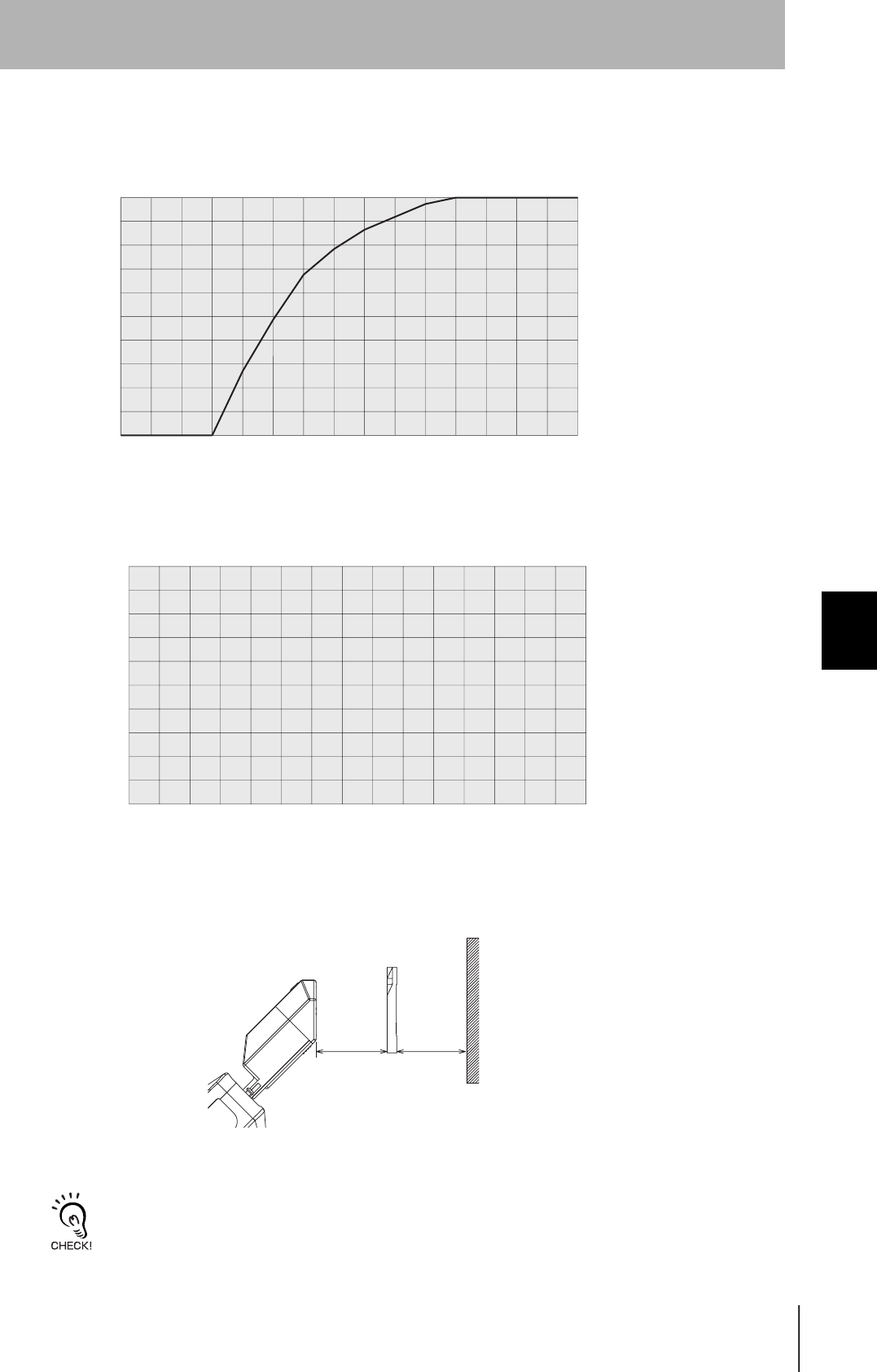
SECTION 6
Characteristics Data Based on Operating Conditions
SECTION 6
Appendices
81
Electromagnetic Inductive RFID System
User's Manual
■V670-D13F03
•Metal: Aluminum
•Metal: Iron
Using the above information as reference, carry out preliminary tests or take other appropriate measures to ensure
proper installation.
* The communications distance
without metal is 100%.
㪈㪇㪇
㪐㪇
㪏㪇
㪎㪇
㪍㪇
㪌㪇
㪋㪇
㪊㪇
㪉㪇
㪈㪇
㪉㪋㪍㪇㪈㪇㪈㪉㪈㪋㪏㪈㪏㪉㪇㪈㪍 㪉㪋 㪉㪍 㪉㪏㪉㪉 㪊㪇
Distance between Ta
g
and metal
(
mm
)
Percent of communications distance (%)
㪈㪇㪇
㪐㪇
㪏㪇
㪎㪇
㪍㪇
㪌㪇
㪋㪇
㪊㪇
㪉㪇
㪈㪇
㪉㪋㪍㪇㪈㪇㪈㪉㪈㪋㪏㪈㪏㪉㪇㪈㪍 㪉㪋 㪉㪍 㪉㪏㪉㪉 㪊㪇
Distance between Tag and metal (mm)
Percent of communications distance (%)
* The communications distance
without metal is 100%.
Communi-
cations
distance
Distance be-
tween Tag
and metal
behind
Tag
Metal
CF Reader/Writer
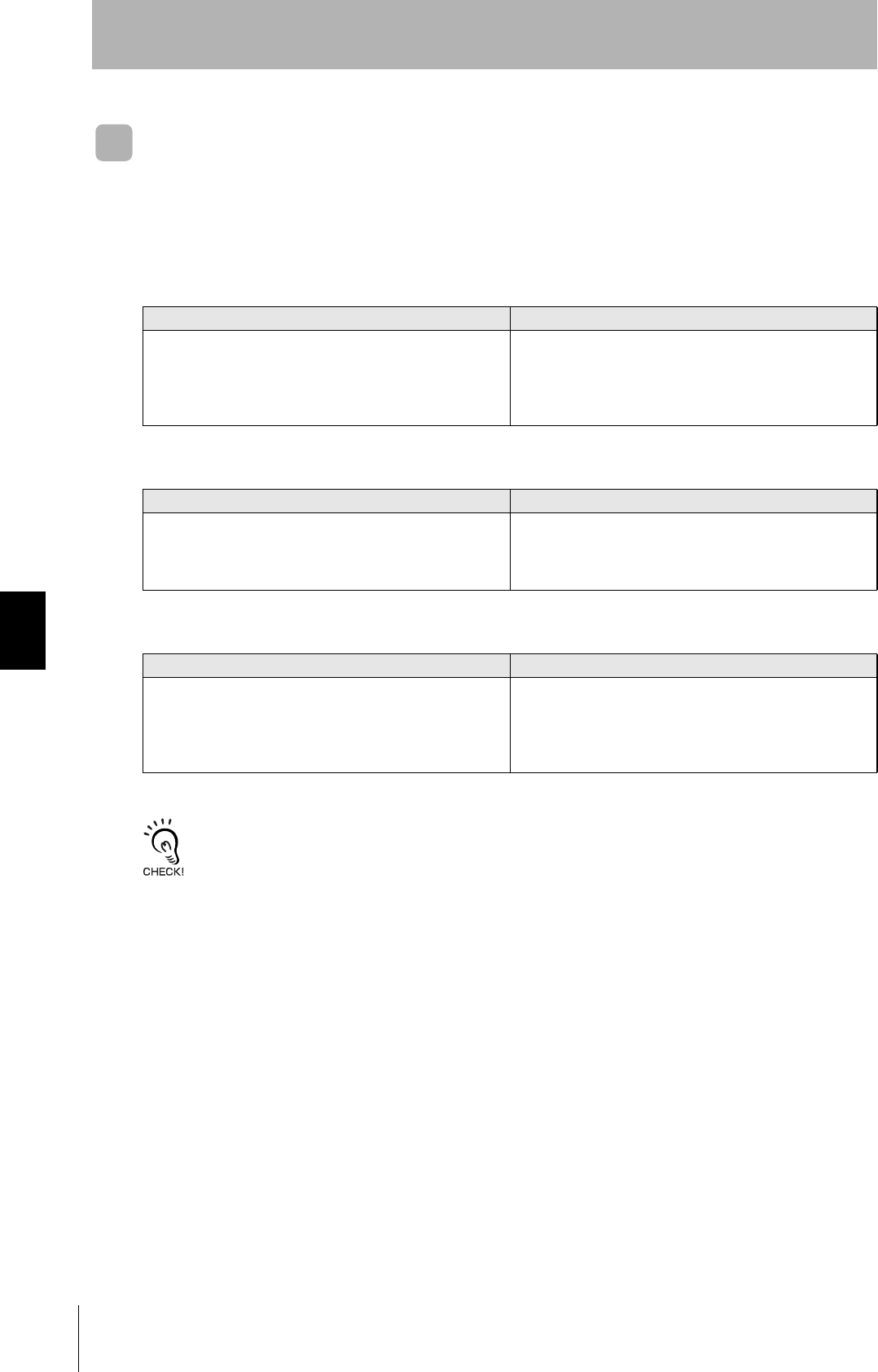
82
SECTION 6
Characteristics Data Based on Operating Conditions
Electromagnetic Inductive RFID System
User's Manual
SECTION 6
Appendices
Chemical Resistance of Tags
Chemicals that affect Tags are shown below.
ABS resin is used for case material and epoxy resin for filling material. Refer the following lists and do
not use chemicals that effect ABS and epoxy resin. Use only chemicals that do not effect these resins.
Tags cannot be used in applications with explosion-proof specifications.
The above results are from tests conducted at room temperature (23°C). Even if the chemicals do not affect the ABS or
epoxy resins at room temperature, they may affect the resins at higher or lower temperatures. Always contact the man-
ufacturer of the chemicals and check the chemicals carefully in advance.
Chemicals That Cause Deformations, Cracks, etc.
ABS resin Epoxy resin
Trichlene, acetone, xylene, toluene, gasoline, creosol,
methylene chloride, phenol, microhexanone, aqua regia,
chromic acid, sulfur (90% RT), methyl ethyl ketone, aniline,
nitrobenzene, monochlorobenzene, pyridine, nitric acid (60%
RT), and formic acid (80% RT)
Aqua regia, chromic acid, sulfuric acid (90% RT), nitric acid
(60% RT), liquid ammonia, acetone, methylene chloride,
phenol, and trichlene.
Chemicals That May Cause Discoloration, Swelling, etc.
ABS resin Epoxy resin
Hydrochloric acid, alcohol, freon, sodium hydroxide, hydrogen
peroxide, benzine, sulfuric acid (10% RT), nitric acid (10%
RT), phosphoric acid (85% RT), liquid ammonia
Sulfuric acid (10% RT), nitric acid (10% RT), hydrochloric acid
(30% RT), acetic acid (50% RT), nitric acid, calcium hydroxide,
benzene, creosol, alcohol, microhexanone, toluene, xylene,
benzine, and grease.
Chemicals That Do Not Affect ABS Resin or Epoxy Resin
ABS resin Epoxy resin
Ammonia, kerosene, mineral oil, developer, YUSHIROKEN
S50, CHEMICOOL Z, VELOCITY NO. 3, YUSHIROKEN EEE-
30Y, petroleum, grease, acetic acid, nitric acid, calcium
hydroxide, phosphoric acid (30% RT), hydrochloric acid (10%
RT), and potassium hydroxide.
Ammonia, hydrochloric acid (10% RT)), potassium hydroxide,
petroleum, gasoline, YUSHIROKEN S50, CHEMICOOL Z,
VELOCITY NO. 3, and YUSHIROKEN EEE-30Y.

SECTION 6
Memory Map
SECTION 6
Appendices
83
Electromagnetic Inductive RFID System
User's Manual
Memory Map
Tag memory has a user area and an ID code. The memory capacity of the user area is 128 bytes. One byte of
data is written to one address. The memory area is divided into pages of 4 bytes, 0000h to 0003h, 0004h to
0007h, etc.
■Memory Map
* If write protection is used, addresses 0000h to 0003h are used for protection address information
and cannot be used as part of the user area.
For details, refer to Write Protection.
p.33 Write Protection
■ID Codes
This is a 4-byte area where a Tag identification number (unique Tag number) is written. The ID code is
written at shipment and cannot be changed. The ID code can be read using the ID read command.
Page User address User area
Write protection not used Write protection used
1
$0000
User area
Specified address in protected area
$0001
$0002
$0003
.
.
.
.
.
$0004
User area
.
.
.
.
.
$007F
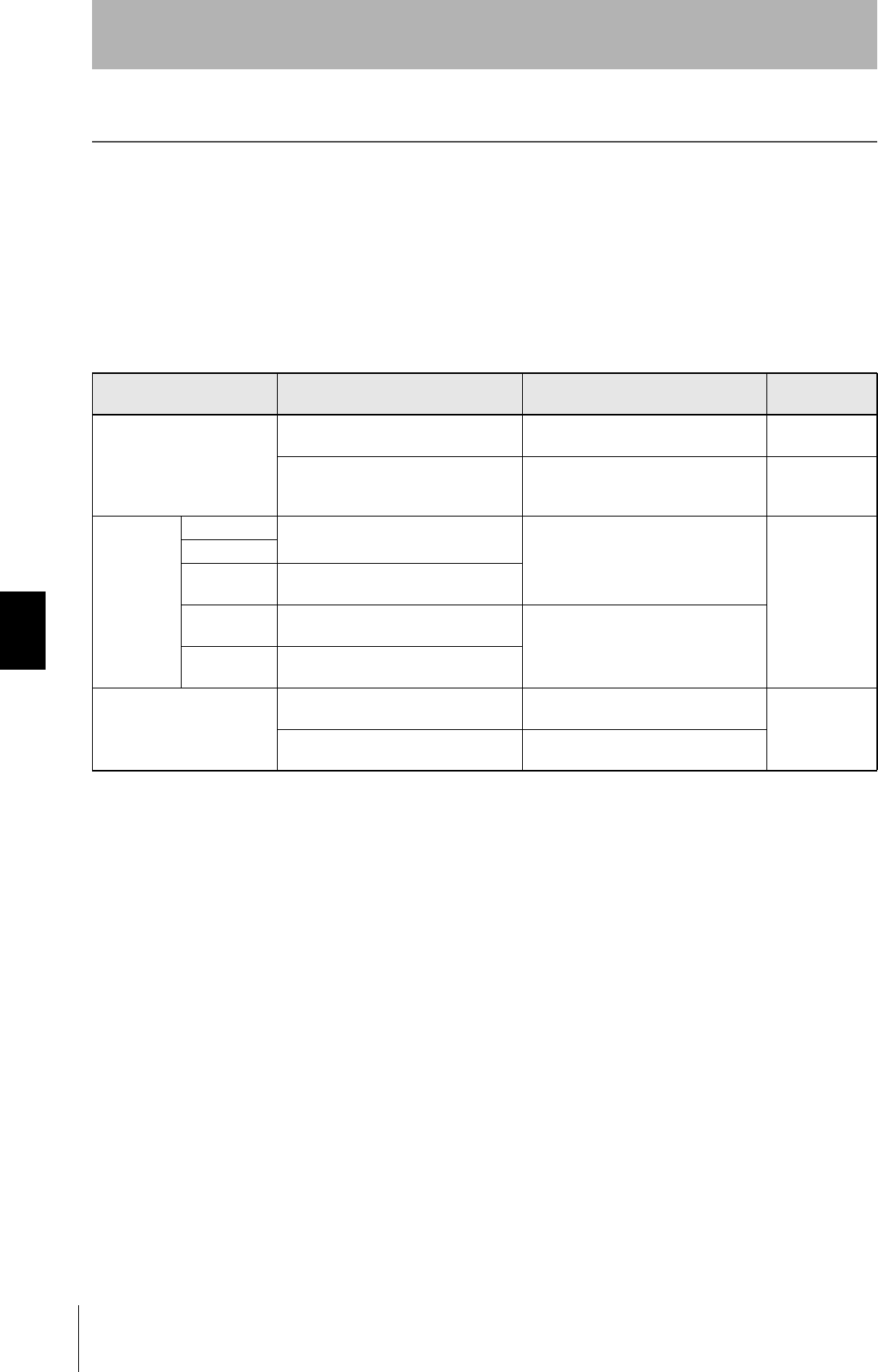
84
SECTION 6
Maintenance and Inspection
Electromagnetic Inductive RFID System
User's Manual
SECTION 6
Appendices
Maintenance and Inspection
To maintain the CF Reader/Writer in optimum condition, daily or periodic inspections are required.
The CF Reader/Writer mainly consists of semiconductor components, which have a long life. The following
malfunctions, however, may occur depending on the environment and operating conditions.
(1) Deterioration of elements due to overvoltage or overcurrent
(2) Deterioration of elements due to long-term stress caused by operation in locations with high ambient
temperatures
(3) Deterioration of insulation or imperfect connector contact due to humidity or dust
(4) Imperfect connector contact or corrosion of elements due to corrosive gas.
Inspection item Inspection details Criteria Required equip-
ment
Fluctuation in power supply
voltage
Check at the power supply terminal block
that the criteria area satisfied.
Within the specifications for power sup-
ply voltage.
Tester
Check whether instantaneous power fail-
ure occurs frequently and whether volt-
age fluctuates considerably.
Within allowable voltage fluctuation
range.
Power supply
analyzer
Ambient envi-
ronment
Temperature Check if within specifications. Within the specifications. Lowest tempera-
ture thermometer
Hygrometer
Humidity
Vibration and
shock
Check for vibration or shock from
machines.
Dust Check for adherence or sedimentation of
dust or foreign matter.
No dust or foreign matter.
Corrosive gas Check for discoloration or corrosion in
metal parts.
Mounting state Check that the CF Reader/Writer is com-
pletely inserted.
There is no looseness.
The CF must be a Type II.
Phillips screw-
driver
Check that the protective cover is firmly
mounted.
The cover must be secured by screws.

SECTION 6
Table of JIS8 Unit Code (ASCII)
SECTION 6
Appendices
85
Electromagnetic Inductive RFID System
User's Manual
Table of JIS8 Unit Code (ASCII)
Left
digits
Right
digits
b8 to
b5 0000 1001 0010 0011 0100 0101 0110 0111 1000 1101 1010 1011 1100 1101 1110 1111
b4 to b1 Col
Row 0 1 2 3 4 5 6 7 8 9 10 11 12 13 14 15
0000 0NUL TC7 (DLE) (SP) 0 @ P ` p Unde-
fined -タミ
0001 1TC1 (SOH) DC1!1AQaq 。 アチム
0010 2TC2 (STX) DC2"2BRbr 「 イツメ
0011 3TC3 (ETX) DC3#3CScs 」 ウテモ
0100 4TC4 (EOT) DC4$4DTd t 、 エトヤ
0101 5TC5 (NEQ) TC8 (NAK) % 5 E U e u . オナユ
0110 6TC6 (ACK) TC9 (SYN) & 6 F V f v ヲ カニヨ
0111 7BEL TC10 (ETB) ' 7 G W g w ァ キヌラ
1000 5FE0 (BS) CAN ( 8 H X h x ィ クネリ
1001 9FE1 (HT) EM ) 9 I Y i y ゥ ケノル
1010 10 FE2 (LF) SUB * : J Z j z ェ コハレ
1011 11 FE3 (VT) ESC + ; K [ k { ォ サヒロ
1100 12 FE4 (FF) IS4 (FS) , < L \ l | ャ シフワ
1101 13 FE5 (CR) IS3 (GS) - = M ] m } ュ スヘン
1110 14 SO IS2(RS) . > N ^ n  ̄ ョ セホ゛
1111 15 SI IS1(US) / ? O _oDEL ッソマ
°
Undefined
Note: The character in the 5th column, 12th row is backslash ( / ) in ASCII.
Undefined
Undefined
Undefined
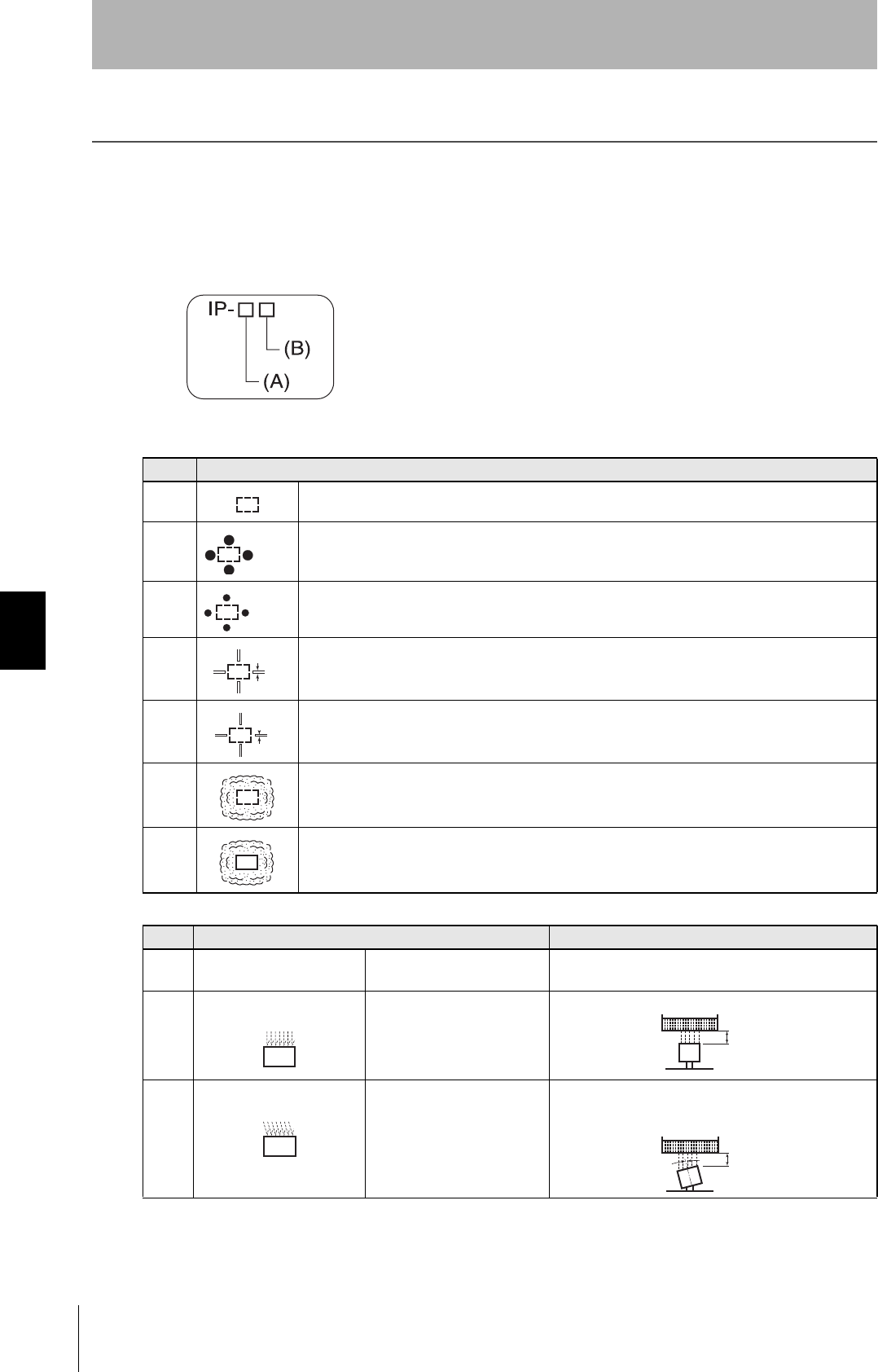
86
SECTION 6
Degree of Protection
Electromagnetic Inductive RFID System
User's Manual
SECTION 6
Appendices
Degree of Protection
IP-@@ is classified by the test method described below. Check sealing in a working environment and
operating conditions in advance. IP refers to the International Protection code.
■IEC (International Electrotechnical Commission)
Standards (IEC60529: 1989-11)
(A) Protective Classification for “1st symbol” Solid Foreign Objects
(B) Protective Classification for “2nd symbol” Water Penetration
Class Protection level
0No protection.
1
Solid foreign material 50 mm or more in diameter (e.g., a hand) cannot enter.
2
Solid foreign material 12.5 mm or more in diameter (e.g., a finger) cannot enter.
3
Solid foreign material 2.5mm or more in diameter (e.g., wire) cannot enter.
4
Solid foreign material 1 mm or more in diameter (e.g., wire) cannot enter.
5
Dust, in a volume that interferes with the normal operation of devices or reduces safety, cannot
enter.
6
No dust can enter.
Class Protection level Test method overview (tested with fresh water)
0 No particular protection No particular protection
against water penetration.
No test.
1 Protection against drops of
water
No adverse effect from water
drops from vertically above.
Drop water for 10 minutes using a water drop tester.
2 Protection against drops of
water
No adverse effect from water
drops from within 15° of a
vertical line.
Drop water to an object set at an incline of 15° for 10
minutes (2.5 minutes in each direction) using a water
drop tester.
50 mm dia.
12.5 mm dia.
2.5 mm
1 mm
200 mm
200 mm
15°

SECTION 6
Degree of Protection
SECTION 6
Appendices
87
Electromagnetic Inductive RFID System
User's Manual
■JEM (Japan Electrical Manufacturers Association) Standard (JEM1030:
1991)
(A) Complies with 1st and 2nd symbols of IEC60529.
Note: There are four other classes: "h", "c", "d", and "e".
3 Protection against water
spray
No adverse effect from water
spray from within 60° of a
vertical line.
Spray water in an area within 60° to the right and left
from a vertical line for 10 minutes, using the tester
shown in the following figure.
4 Protection against water
splash
No adverse affect from water
splash from any direction.
Spray water for 10 minutes from all directions, using the
tester shown in the following figure.
5 Protection against water jet
flow
No adverse affect from direct
water jet flow from any
direction.
Spray water from all directions for 1 minute per surface
area 1 m2, for a total of 3 minutes or more, using the
tester shown in the following figure.
6 Protection against extreme
water jet flow
No adverse effect from
extreme direct water jet flow
from any direction.
Spray water from all directions for 1 minute per surface
area 1 m2, for a total of 3 minutes or more, using the
tester shown in the following figure.
7 Protection against water
soaking
No water penetration, even if
the object is immersed in
water of a specified pressure
for a specified time.
Immerse the object to a depth of 1 m (when the height
of the device is less than 850 mm), for 30 minutes.
8 Protection against water
immersion
Can be used when always
immersed in water.
Agreement to be reached between the manufacturer
and the device user.
(B) Protective Classification for Oil Penetration
Class Protection level
f Oil-retaining type No adverse affect from oil drops or oil spray from any direction.
g Oil-resistant type Oil drops and oil spray from any direction do not enter.
Class Protection level Test method overview (tested with fresh water)
0.07 l/min per spray hole
0.07 l/min per spray hole
12.5 l/min
2.5 to 3 m
100 l/min
2.5 to 3 m
1 m
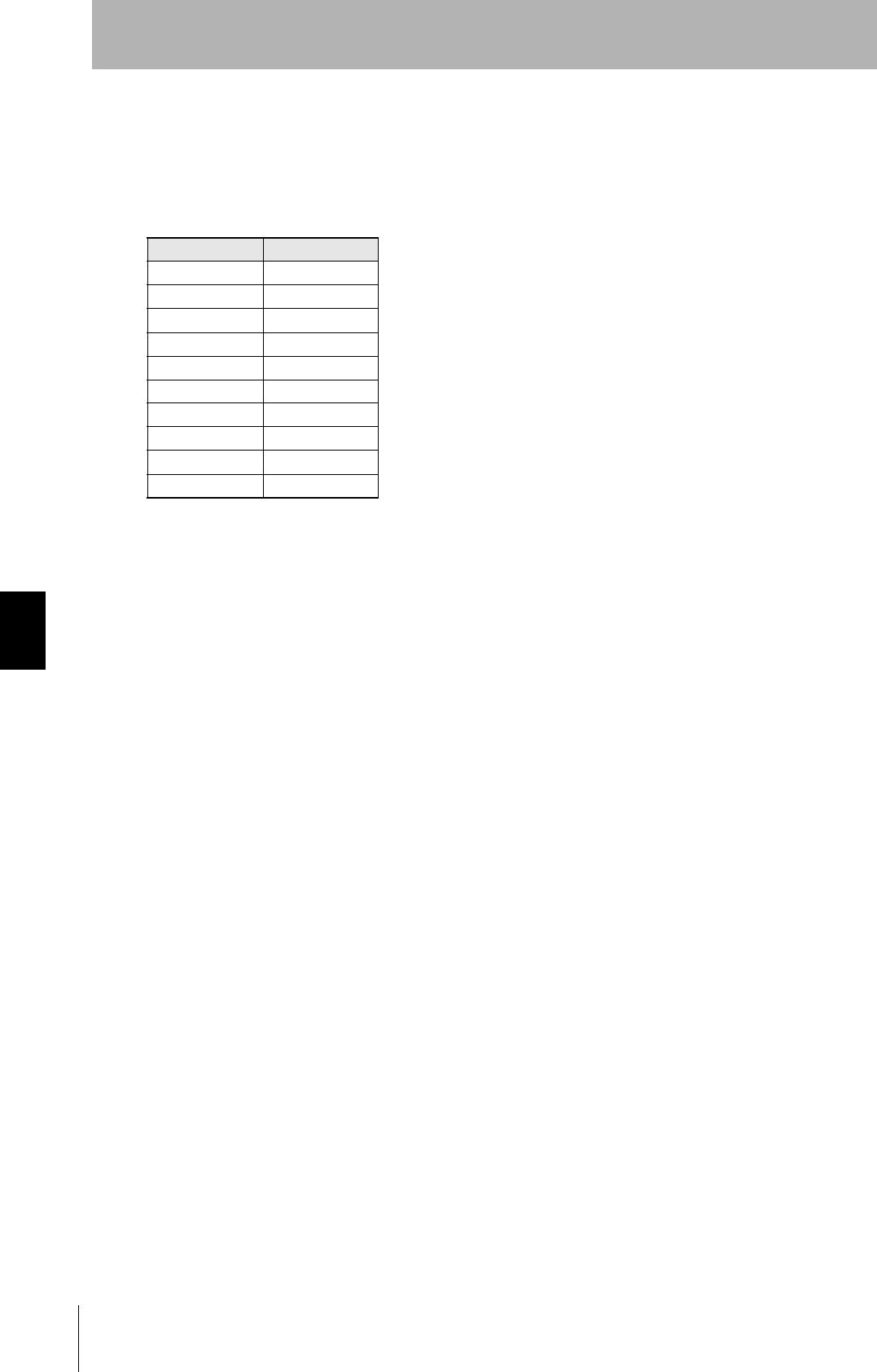
88
SECTION 6
Degree of Protection
Electromagnetic Inductive RFID System
User's Manual
SECTION 6
Appendices
■NEMA (National Electrical Manufacturers Association)
Table for conversion from NEMA enclosure classifications to IEC60529. (Conversion from IEC60529 to
NEMA enclosure classifications is not available.)
NEMA250 IEC60529
1IP10
2IP11
3IP54
3R IP14
3S IP54
4,4X IP56
5IP52
6,6P IP67
12,12K IP52
13 IP54

SECTION 6
Degree of Protection
SECTION 6
Appendices
89
Electromagnetic Inductive RFID System
User's Manual
MEMO

90
Electromagnetic Inductive RFID System
User's Manual
Manual Revision History
A manual revision code is added to the end of the catalog number shown at the bottom of the front and back
covers.
Revision code Date of
revision Reason for revision/revised page
01 June 2004 Original production
Catalog number ???-E1-01
Revision code


